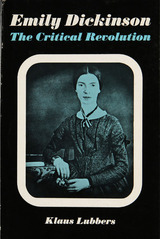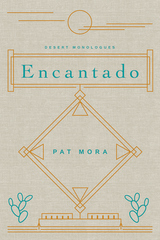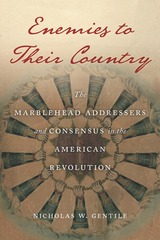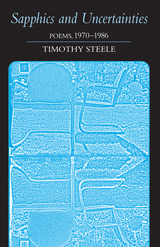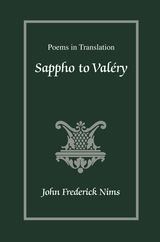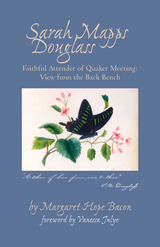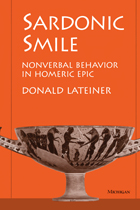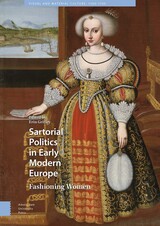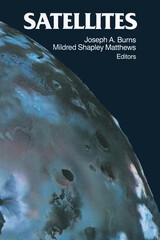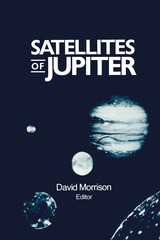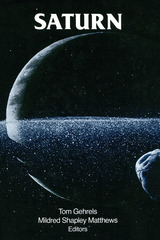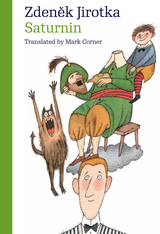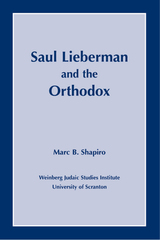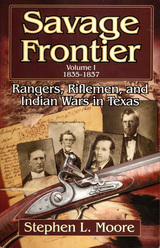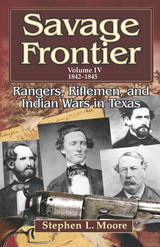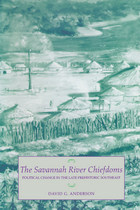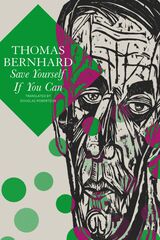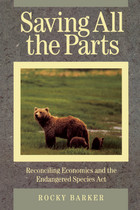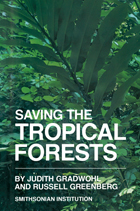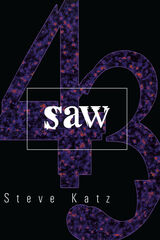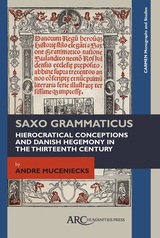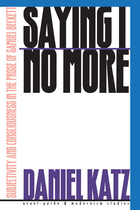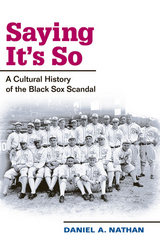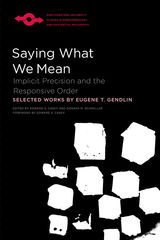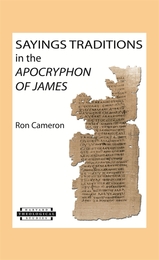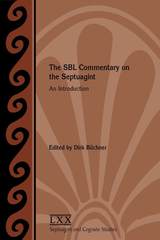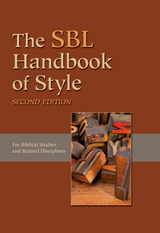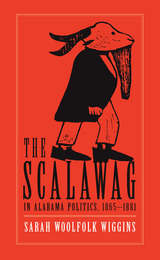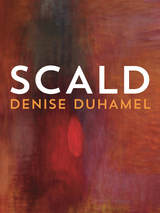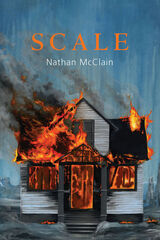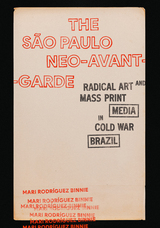 The São Paulo Neo-Avant-Garde: Radical Art and Mass Print Media in Cold War Brazil
Mari Rodríguez Binnie
University of Texas Press, 2024 How artists challenged a military dictatorship through mass print technologies in 1970s and 1980s São Paulo. Throughout the 1970s and into the 1980s, during Brazil's military dictatorship, artists shifted their practices to critique the government and its sanitized images of Brazil, its use of torture, and its targeted persecutions. Mari Rodríguez Binnie's The São Paulo Neo-Avant-Garde examines these artworks and their engagement with politics and mainstream art institutions and practices. As Binnie skillfully shows, artists appropriated processes like photocopy, offset lithography, and thermal and heliographic printing, making newly available technologies of mass production foundational to their work of resistance against both the dictatorship and the established art world. Often working collaboratively, these artists established alternative networks of exchange locally and internationally to circulate their work. As democracy was reestablished in Brazil, and in the decades that followed, their works largely fell out of sight. Here, in the first English-language book to focus entirely on conceptual practices in São Paulo in the 1970s and 1980s, Binnie unearths a scene critical to the development of contemporary Brazilian Art.
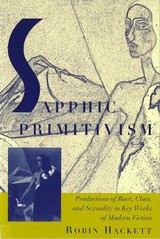 Sapphic Primitivism: Productions of Race, Class, and Sexuality in Key Works of Modern Fiction
Hackett, Robin
Rutgers University Press, 2003 In this book, Robin Hackett examines portrayals of race, class, and sexuality in modernist texts by white women to argue for the existence of a literary device that she calls “Sapphic primitivism.” The works vary widely in their form and content and include Olive Schreiner’s proto-modernist exploration of New Womanhood, The Story of an African Farm; Virginia Woolf’s high modernist “play-poem,” The Waves; Sylvia Townsend Warner’s historical novel, Summer Will Show; and Willa Cather’s Southern pastoral, Sapphira and the Slave Girl. In each, blackness and working-class culture are figured to represent sexual autonomy, including lesbianism, for white women. Sapphic primitivism exposes the ways several classes of identification were intertwined with the development of homosexual identities at the turn of the century. Sapphic primitivism is not, however, a means of disguising lesbian content. Rather, it is an aesthetic displacement device that simultaneously exposes lesbianism and exploits modern, primitivist modes of self-representation. Hackett’s revelations of the mutual interests of those who study early twentieth-century constructions of race and sexuality and twenty-first-century feminists doing anti-racist and queer work are a major contribution to literary studies and identity theory.
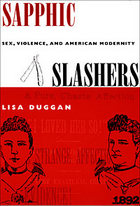 Sapphic Slashers: Sex, Violence, and American Modernity
Lisa Duggan
Duke University Press, 2000 On a winter day in 1892, in the broad daylight of downtown Memphis, Tennessee, a middle class woman named Alice Mitchell slashed the throat of her lover, Freda Ward, killing her instantly. Local, national, and international newspapers, medical and scientific publications, and popular fiction writers all clamored to cover the ensuing “girl lovers” murder trial. Lisa Duggan locates in this sensationalized event the emergence of the lesbian in U.S. mass culture and shows how newly “modern” notions of normality and morality that arose from such cases still haunt and distort lesbian and gay politics to the present day.
Situating this story alongside simultaneously circulating lynching narratives (and its resistant versions, such as those of Memphis antilynching activist Ida B. Wells) Duggan reveals how stories of sex and violence were crucial to the development of American modernity. While careful to point out the differences between the public reigns of terror that led to many lynchings and the rarer instances of the murder of one woman by another privately motivated woman, Duggan asserts that dominant versions of both sets of stories contributed to the marginalization of African Americans and women while solidifying a distinctly white, male, heterosexual form of American citizenship. Having explored the role of turn-of-the-century print media—and in particular their tendency toward sensationalism—Duggan moves next to a review of sexology literature and to novels, most notably Radclyffe Hall’s The Well of Loneliness. Sapphic Slashers concludes with two appendices, one of which presents a detailed summary of Ward’s murder, the trial, and Mitchell’s eventual institutionalization. The other presents transcriptions of letters exchanged between the two women prior to the crime.
Combining cultural history, feminist and queer theory, narrative analysis, and compelling storytelling, Sapphic Slashers provides the first history of the emergence of the lesbian in twentieth-century mass culture.
Sapphics and Uncertainties: Poems 1970-1986
Timothy Steele
University of Arkansas Press, 1995 “Desperately and delightfully unfashionable” was how reviewer Richmond Lattimore characterized Timothy Steele’s Uncertainties and Rest when it first appeared in 1979. Sapphics against Anger and Other Poems appeared in 1986 and solidified and extended Steele’s reputation as, in the words of Publishers Weekly, “one of the finest contemporary poets to write in meter and traditional forms.”
Sapphics and Uncertainties: Poems 1970–1986 draws together these two books into a single volume. This collection offers the most substantial gathering yet from a body of work widely praised for its tonal and thematic range and for its wit and warmth of feeling.
 Sappho in Early Modern England: Female Same-Sex Literary Erotics, 1550-1714
Harriette Andreadis
University of Chicago Press, 2001 In Sappho in Early Modern England, Harriette Andreadis examines public and private expressions of female same-sex sexuality in sixteenth- and seventeenth-century England. Before the language of modern sexual identities developed, a variety of discourses in both literary and extraliterary texts began to form a lexicon of female intimacy. Looking at accounts of non-normative female sexualities in travel narratives, anatomies, and even marital advice books, Andreadis outlines the vernacular through which a female same-sex erotics first entered verbal consciousness. She finds that "respectable" women of the middle classes and aristocracy who did not wish to identify themselves as sexually transgressive developed new vocabularies to describe their desires; women that we might call bisexual or lesbian, referred to in their day as tribades, fricatrices, or "rubsters," emerged in erotic discourses that allowed them to acknowledge their sexuality and still evade disapproval.
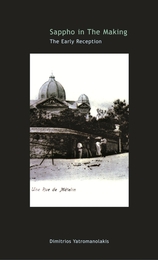 Sappho in the Making: The Early Reception
Dimitrios Yatromanolakis
Harvard University Press, 2007 This book offers the first interdisciplinary and in-depth study of the cultural practices and ideological paradigms that conditioned the politics of the "reading" of Sappho's songs in the early and most pivotal stages of her reception. In this wide-ranging synthesis, Dimitrios Yatromanolakis investigates visual representations and ancient texts in their synchronic and diachronic multilayeredness to trace the discursive nexuses that defined the making of "Sappho" in the late archaic, classical, and early Hellenistic periods. Offering a systematic analysis of the contextual cues provided by vase paintings and focusing on the sociocultural institution of the symposion, this book explores the intricate modes of the assimilation of Sappho's poetry into diverse social, aesthetic, and performative contexts. Drawing on a number of disciplines, including archaeology, papyrology, and anthropology, Sappho in the Making articulates a new methodological Problematik on the reception of archaic Greek socioaesthetic cultures.
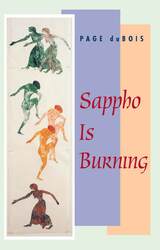 Sappho Is Burning
Page duBois
University of Chicago Press, 1995 To know all we know about Sappho is to know little. Her poetry, dating from the seventh century B.C.E., comes to us in fragments, her biography as speculation. How is it then, Page duBois asks, that this poet has come to signify so much? Sappho Is Burning offers a new reading of this archaic lesbian poet that acknowledges the poet's distance and difference from us and stresses Sappho's inassimilability into our narratives about the Greeks, literary history, philosophy, the history of sexuality, the psychoanalytic subject.
In Sappho is Burning, duBois reads Sappho as a disruptive figure at the very origin of our story of Western civilization. Sappho is beyond contemporary categories, inhabiting a space outside of reductively linear accounts of our common history. She is a woman, but also an aristocrat, a Greek, but one turned toward Asia, a poet who writes as a philosopher before philosophy, a writer who speaks of sexuality that can be identified neither with Michel Foucault's account of Greek sexuality, nor with many versions of contemporary lesbian sexuality. She is named as the tenth muse, yet the nine books of her poetry survive only in fragments. She disorients, troubles, undoes many certitudes in the history of poetry, the history of philosophy, the history of sexuality. DuBois argues that we need to read Sappho again.
Sappho to Valéry: Poems in Translation
John Frederick Nims
University of Arkansas Press, 1990 Revised and enlarged, the second edition of Sappho to Valéry includes both the originals and translations of ninety-eight poems from nine different languages. Nims offers new and lively interpretations of a number of poems that have been translated and others available in no other English translation. A former editor of Poetry, John Frederick Nims has published several volumes of his own poetry, poetry in translation, and essays on the form.
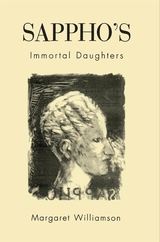 Sappho’s Immortal Daughters
Margaret Williamson
Harvard University Press, 1995 She lived on the island of Lesbos around 600 B.C.E. She composed lyric poetry, only fragments of which survive. And she was--and is--the most highly regarded woman poet of Greek and Roman antiquity.
Little more than this can be said with certainty about Sappho, and yet a great deal more is said. Her life, so little known, is the stuff of legends; her poetry, the source of endless speculation. This book is a search for Sappho through the poetry she wrote, the culture she inhabited, and the myths that have risen around her. It is an expert and thoroughly engaging introduction to one of the most enduring and enigmatic figures of antiquity.Margaret Williamson conducts us through ancient representations of Sappho, from vase paintings to appearances in Ovid, and traces the route by which her work has reached us, shaped along the way by excavators, editors, and interpreters. She goes back to the poet's world and time to explore perennial questions about Sappho: How could a woman have access to the public medium of song? What was the place of female sexuality in the public and religious symbolism of Greek culture? What is the sexual meaning of her poems? Williamson follows with a close look at the poems themselves, Sappho's "immortal daughters." Her book offers the clearest picture yet of a woman whose place in the history of Western culture has been at once assured and mysterious.
 Sara: My Whole Life Was a Struggle
Sakine Cansiz
Pluto Press, 2018 The bitter struggle of the Kurdistan Workers' Party, or PKK, against the Turkish state has delivered inspirational but often tragic stories. This memoir by Kurdish revolutionary Sakine Cansiz is one of them. Sakine, whose code name was 'Sara', co-founded the PKK in 1974 and dedicated her life to its cause. On the 9 January 2013 she was assassinated in Paris in circumstances that remain officially unresolved.
This is the first chapter of her iconic life, leading up to her arrest in 1979, penned as dramatic events unfolded against the backdrop of the Turkish revolutionary left. She writes about the excitement of entering the movement as a young woman, discovering she would have to challenge traditional gender roles as she rose amongst its ranks. She was one of the first to demand the recruitment and education of female revolutionaries, and demanded total gender equality within the PKK, which is now one of its central tenets.
Today, 'Sara' is an inspiration to women fighting for liberation across the world. This is her story in her own words, and is in turns shocking, violent and path-breaking.
Translated by Janet Biehl.
 Sara: Prison Memoir of a Kurdish Revolutionary
Sakine Cansiz
Pluto Press, 2019 The second instalment in a gripping memoir by Sakine Cansiz (codenamed 'Sara') chronicles the Kurdish revolutionary's harrowing years in a Turkish prison, following her arrest in 1979 at the age of 21. Jailed for more than a decade for her activities as a founder and leader of the Kurdish freedom movement, she faced brutal conditions and was subjected to interrogation and torture. Remarkably, the story she tells here is foremost one of resistance, with courageous episodes of collective struggle behind bars including hunger strikes and attempts at escape. Along the way she also presents vivid portraits of her fellow prisoners and militants, a snapshot of the Turkish left in the 1980s, a scathing indictment of Turkey's war on Kurdish people - and even an unlikely love story. The first prison memoir by a Kurdish woman to be published in English, this is an extraordinary document of an extraordinary life. Translated by Janet Biehl.
 Sara Teasdale: Woman and Poet
William Drake
University of Tennessee Press, 1989 "It would be nice to think that this comprehensive and thought provoking biography will do something to give Teasdale a permanent, if small, niche in the history of American poetry. She is a good poet, if not a great one—much better than her splashy contemporaries Vachel Lindsay and Carl Sandburg. . . . Teasdale herself could not have wished for a better biographer than William Drake." —Katha Pollitt, The New York Times Book Review
"William Drake's biography of Sara Teasdale is a sensitive, readable, intelligent perspective on a poet whose work influenced writers like John Berryman, Louise Bogan, and Sylvia Plath. Drake approaches his subject with candor and provides a very useful background in terms of attitudes toward woman poets during the 1910s and 1920s, illuminating the American poetic scene in wonderful new ways." —Cheryl Walker
"This is a profoundly moving biography of one of America's foremost lyric poets and women artists." —Rita Ingram Givens, San Francisco Examiner
Sara Teasdale was the best-loved poet in America in the 1920s. Today most people know little of her poetry beyond some highly popular early sentimental verse; they know even less about the poet herself. Now William Drake restores to American letters the unique contribution of Sara Teasdale, whose poetic craft and frequently tortured life interacted in important ways.
 Sarah Angelina Acland: First Lady of Colour Photography
Giles Hudson
Bodleian Library Publishing, 2012 Sarah Angelina Acland (1849–1930) is one of the most important photographers of the late Victorian and early Edwardian periods. Born to a preeminent English family, Acland first gained note as a portraitist whose illustrious subjects—among them two prime ministers, the physicist Lord Kelvin, and the noted art critic John Ruskin—were visitors to her family’s Oxford home. Yet it was through her work in the thenfledgling field of color photography that Acland achieved her greatest acclaim. When her color photographs were shown at the Royal Photographic Society in 1905, many considered them to be among the finest work produced in the new medium. An introduction to Acland’s entire body of work, this volume contains more than two hundred previously unpublished examples of her photographs, spanning portraiture, studies of Oxford architecture, and landscape and garden photographs captured in Madeira, Portugal. Additional images include four unrecorded portraits by Lewis Carroll of Acland and her brothers—shed light on the work of her contemporaries, including acquaintances and artistic influences like Carroll and Julia Margaret Cameron. A fascinating look at the earliest days of color photography, this book also offers a glimpse into the lives of an influential English family and its circle of friends.
 Sarah Orne Jewett: Reconstructing Gender
Margaret Roman
University of Alabama Press, 1992 In her book Sarah Orne Jewett: Reconstructing Gender, Margaret Roman argues that one theme colors almost every short story and novel by the turn-of-the-century American author: each person, regardless of sex, must break free of the restrictive, polar-opposite norms of behavior traditionally assigned to men and women by a patriarchal society. That society, as seen from Jewett’s perspective during the late Victorian era, was one in which a competitive, active man dominates a passive, emotional woman. Frequently referring to Jewett’s own New England upbringing at the hands of an unusually progressive father, Roman demonstrates how the writer, through her personal quest for freedom and through the various characters she created, strove to eliminate the necessity for rigid and narrowly defined male-female roles and relationships.
With the details of Jewett’s free-spirited life, Roman’s book represents a solid work of literary scholarship, which traces a gender-dissolving theme throughout Jewett’s writing. Whereas previous critics have focused primarily on her best-known works, including “A White Heron,” Deephaven, A Country Doctor, and The Country of the Pointed Firs, Roman encompasses within her own discussion virtually all of the stories found in the nineteen volumes Jewett published during her lifetime. And although much recent criticism has centered around Jewett’s strong female characters, Roman is the first to explore in depth Jewett’s male characters and married couples.
The book progresses through distinct phases that roughly correspond to Jewett’s psychological development as a writer. In general, the characters in her early works exhibit one of two modes of behavior. Youngsters, free as Jewett was to explore the natural world of woods and field, glimpse the possibility of escape from the confining standards that society has set, though some experience turbulent and confusing adolescences where those norms have become more pressing, more demanding. At the opposite extreme are those who have mindlessly accepted the roles in which they have been trapped since youth—greedy, selfish men, dutiful women who tend emotionally empty houses, young couples unable to communicate either between themselves or with others—in short, characters who are too alienated within their roles to function as whole human beings.
On the other hand, Jewett approaches the men and women of her later works with a higher degree of optimism, in that each person is free to live according to the dictates of his or her inherent personality—each character is able to measure life from within rather than from without. This group includes the self-confident men who are not reluctant to present a nurturing side, and the warm, giving women who are unafraid of displaying a decided inner strength. As Roman summarizes, “In her writings, Jewett attempts to shift society’s focus from a grasping power over people to the personal development of each member of society.”
Ahead of her time in many ways, Sarah Orne Jewett confronted the Victorian polarized gender system, presaging the modern view that men and women should be encouraged to develop along whatever paths are most comfortable and most natural for them.
 The Sarah Siddons Audio Files: Romanticism and the Lost Voice
Judith Pascoe
University of Michigan Press, 2013 “The theatre scholar’s daunting but irresistible quest to recover some echoes of performance of the past has never been more engagingly presented than in Pascoe’s account of tracing the long-silenced voice of Sarah Siddons. Her report is a warm, witty, and highly informative exploration of the methodology and the pleasures of historical research.”
—Marvin Carlson, author of The Haunted Stage: The Theatre as Memory Machine During her lifetime (1755–1831), English actress Sarah Siddons was an international celebrity acclaimed for her performances of tragic heroines. We know what she looked like—an endless number of artists asked her to sit for portraits and sculptures—but what of her famous voice, reported to cause audiences to hyperventilate or faint? In The Sarah Siddons Audio Files, Judith Pascoe takes readers on a journey to discover how the actor’s voice actually sounded. In lively and engaging prose, Pascoe retraces her quixotic search, which leads her to enroll in a “Voice for Actors” class, to collect Lady Macbeth voice prints, and to listen more carefully to the soundscape of her life. Bringing together archival discoveries, sound recording history, and media theory, Pascoe shows how romantic poets’ preoccupation with voices is linked to a larger cultural anxiety about the voice’s ephemerality. The Sarah Siddons Audio Files contributes to a growing body of work on the fascinating history of sound and will engage a broad audience interested in how recording technology has altered human experience.
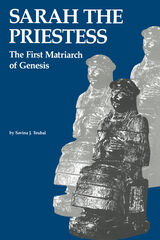 Sarah the Priestess: The First Matriarch of Genesis
Savina Teubal
Ohio University Press, 1984 The only source in which Sarah is mentioned is the Book of Genesis, which contains very few highly selective and rather enigmatic stories dealing with her. On the surface, these stories tell us very little about Sarah, and what they do tell is complicated and confused by the probability that it represents residue surviving from two different written sources based on two independent oral traditions. Nevertheless, the role which Sarah plays, in the Genesis narratives, apears to be a highly energetic one, a role so active, in fact, that it repeatedly overshadows that of her husband.
In a patriarchal environment such as the Canaan of Genesis, the situation is discordant and problematic. Dr. Teubal suggests that the difficulty is eliminated, however, if we understand that Sarah and the other matriarchs mentioned in the narratives acted within the established, traditional Mesopotamian role of priestess, of a class of women who retained a highly privileged position vis-a-vis their husbands.
Dr. Teubal shows that the “Sarah tradition” represents a nonpatriarchal system struggling for survival in isolation, in the patriarchal environment of what was for Sarah a foreign society. She further indicates that the insistence of Sarah and Rebekah that their sons and heirs marry wives from the old homeland had to do not so much with preference for endogamy and cousin marriage as with their intention of ensuring the continuation of their old kahina-tradition against the overwhelming odds represented by patriarchal Canaan.
Sarah's Choice
Eleanor Wilner
University of Chicago Press, 1989 In this, her third collection of poems, Eleanor Wilner revises a number of our culture's central myths; invoking figures as diverse as Briar Rose and Miriam the Prophet, she casts upon their stories, and choices, an enlivening feminist perspective.
"There is so much that is impressive in Wilner's mature poems. In an era which has been labelled 'The End of History,' she examines history's less obvious lessons. If the past is to teach us, she seems to say, then we must re-invent and re-shape it."—Poetry
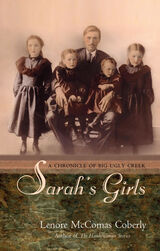 Sarah’s Girls: A Chronicle of Big Ugly Creek
Lenore McComas Coberly
Ohio University Press, 2006 Situated in a remote outpost in West Virginia at the turn of the last century, the story that Lenore McComas Coberly tells in Sarah’s Girls is one of place, people, and unquenchable spirit. In this fictionalized account of her recent ancestors, Coberly masterfully traces the journeys of their lives, their dreams, and their hardships over the course of the twentieth century. At its center is the story of Lena, who returns to care for her dead sister’s daughters, giving up the promise of a life that can spare her the adversity rural living guarantees. The author goes back to Big Ugly Creek, the place where her grandparents met—and the place whose memory she cannot leave. Using the stories she was told in her childhood as a bridge to the past, Coberly uncovers facts about her family history from documents that have made their way from one generation to another and the truth from the inherent understanding she has of these people who are so close to her. But Sarah’s Girls is not about the author; it is about the people and a place she loves. It is fiction written to tell the deeper truth about the hold West Virginia—its mountains and its valleys—has on its people.
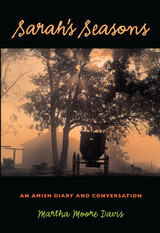 Sarah's Seasons: An Amish Diary and Conversation
Martha Moore Davis
University of Iowa Press, 1997 “Have you ever kept a diary?” With that question author Martha Davis sets out on her journey into the quietly remarkable life of an Old Order Amish woman know to us as Sarah Fisher. Sarah not only kept a diary but welcomed Martha to read it and to view the world through her eyes. The even, peaceful tenor of Sarah's diary entries and the closeness to nature of her life and work will make readers question the pace and values of their own lives, and the degree of social interconnectedness in Sarah's world will offer a model for many of us outside it.
Sarah's brief daily notations, recorded on a calendar throughout 1976 and 1977, reveal an ongoing account of her seasonal routine. In many ways the straightforward simplicity of her writing is a reflection of her life near rural Kalona, Iowa, a life filled with what Martha Davis calls look-easy tasks undertaken without the conveniences of electricity, phones, or automobiles. For Sarah, diaries are a record. “A diary can settle a question, a disagreement,” she tells Martha. “You look back and see what took place. That's history.”
Through their conversations, Martha soon discovered she had more in common with Sarah than diary writing. Though Davis lived in the mainstream culture, an “English” person as the Amish say, like Sarah she grew up on a farm in rural Iowa during the 1950s and 1960s. Like Martha, Sarah had spent several years as a teacher.
In Sarah's Seasons Martha Davis shares their common experiences and common interests—gardening, quilting, and cooking. Alongside Sarah's diary, Martha presents their shared recipes and conversations as well as reflections on her own more modern existence. Because of her friendship with Sarah, the author found a new sense of belonging to and purpose in the mainstream world. In the end, Sarah's diary becomes for Martha a meditation on time and community.
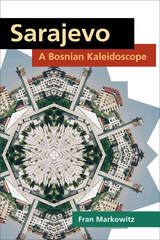 Sarajevo: A Bosnian Kaleidoscope
Fran Markowitz
University of Illinois Press, 2010 This fascinating urban anthropological analysis of Sarajevo and its cultural complexities examines contemporary issues of social divisiveness, pluralism, and intergroup dynamics in the context of national identity and state formation. Rather than seeing Bosnia-Herzegovina as a volatile postsocialist society, the book presents its capital city as a vibrant yet wounded center of multicultural diversity, where citizens live in mutual recognition of difference while asserting a lifestyle that transcends boundaries of ethnicity and religion. It further illuminates how Sarajevans negotiate group identity in the tumultuous context of history, authoritarian rule, and interactions with the built environment and one another. As she navigates the city, Fran Markowitz shares narratives of local citizenry played out against the larger dramas of nation and state building. She shows how Sarajevans' national identities have been forged in the crucible of power, culture, language, and politics. Sarajevo: A Bosnian Kaleidoscope acknowledges this Central European city's dramatic survival from the ravages of civil war as it advances into the present-day global arena.
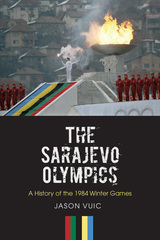 The Sarajevo Olympics: A History of the 1984 Winter Games
Jason Vuic
University of Massachusetts Press, 2015 To most observers, the 1984 Winter Olympics in Sarajevo, Yugoslavia, were an unmitigated success. That year, the unlikeliest of candidate cities in the unlikeliest of candidate countries did what many had thought impossible: it hosted an international sports competition at the highest level, housing and feeding hundreds of athletes and thousands of tourists while broadcasting a positive image of socialist Yugoslavia to the world.
The first Winter Games held in a communist country, Sarajevo also marked the first Olympic confrontation of Soviet and American athletes since the U.S. boycott of the 1980 Moscow Summer Games. And the competitions themselves were spectacular and memorable. This was the Olympics of British ice dancers Jayne Torvill and Christopher Dean, American skiers "Wild Bill" Johnson and Debbie Armstrong, and East German skaters Katarina Witt and Karin Enke, not to mention a Soviet hockey team that rebounded from its stunning loss to the Americans at Lake Placid four years earlier to win all seven of its matches.
Yet The Sarajevo Olympics is more than just a history of sport. Jason Vuic also retraces the history of the Olympic movement, analyzes the inner workings of the International Olympic Committee during the troubled 1970s and 1980s, and places the 1984 Winter Games in the context of Cold War geopolitics. The book begins and ends by reminding readers that less than a decade after it hosted the Olympics, the Bosnian city of Sarajevo found itself at the vortex of a bloody and brutal civil war that would end with the dissolution of the multiethnic Yugoslavian state.
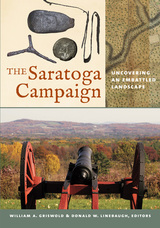 The Saratoga Campaign: Uncovering an Embattled Landscape
Edited by William A. Griswold and Donald W. Linebaugh
University Press of New England, 2016 The battles of Saratoga proved to be a turning point in the Revolutionary War when British forces under the command of General John Burgoyne surrendered to American forces led by General Horatio Gates. The Saratoga Campaign provides a new and greatly expanded understanding of the battles of Saratoga by drawing on the work of scholars in a broad range of academic disciplines. Presenting years of research by material culture scholars, archaeologists, historians, museum curators, military experts, and geophysicists, this definitive volume explores these important Revolutionary War battles and their aftermath, adding a physical and tangible dimension to the story of the Saratoga campaign. Presenting the latest hands-on research, The Saratoga Campaign is an original and multifaceted contribution to our understanding of this critical event in America’s birth.
 Sardinian Chronicles
Bernard Lortat-Jacob
University of Chicago Press, 1995 In Sardinian Chronicles Bernard Lortat-Jacob poetically evokes Sardinian music through a series of encounters with individual musicians and their families. Refusing to separate the music from the world in which it arises, Lortat-Jacob offers twelve vignettes focused on individuals such as Cocco, a chicken farmer who deciphers the shapes of his fowl and the layout of his henhouses in the constellations of a summer sky, and Pietro, a sleep-walking postman who divides his time between mail deliveries and impromptu serenades. These vignettes bring to life an art still very much alive: the music of villages with an oral tradition, sung or played in the company of others.
Through his sensitive portraits of music makers and their families, Lortat-Jacob overcomes some of the epistemological and methodological dilemmas facing his field today, while also giving the general reader a sense of the multiple and idiosyncratic ways that music is involved in everyday life. With a foreword by Michel Leiris and a compact disc containing samples of the music being discussed, this book constitutes a breakthrough in ethnomusicology that will also interest many in Mediterranean studies and European anthropology.
 Sardis from Prehistoric to Roman Times: Results of the Archaeological Exploration of Sardis, 1958–1975
George M. A. Hanfmann
Harvard University Press, 1983 A great metropolis of the ancient world, “golden” Sardis was the place where legendary Croesus ruled, where coinage was invented. Since 1958 an archaeological team has been working at the site to retrieve evidence of the rich Lydian culture as well as of the prehistoric Anatolian settlement and the Hellenistic and Roman civilizations that followed the Lydian kingdom. Here is a comprehensive and fully illustrated account of what the team has learned, presented by the eminent archaeologist who led the expedition.
George Hanfmann and his collaborators survey the environment of Sardis, the crops and animal life, the mineral resources, the industries for which the city was famed, and the pattern of settlement. The history of Sardis is then reconstructed, from the early Bronze Age to Late Antiquity. Archaeologists who have done the excavating contribute descriptions of shops and houses, graves, the precinct and Altar of Artemis, the Acropolis, gold-working installations and techniques, the bath and gymnasium complex, and the Synagogue. The material finds are studied in the context of other evidence, and there emerges an overall picture of the Lydian society, culture, and religion, the Greek and subsequently the Roman impact, the Jewish community, and the Christianization of Sardis. Historians of the ancient world will find this account invaluable.
 Sardis: Greek and Latin Inscriptions, Part II: Finds from 1958 to 2017
Georg Petzl
Harvard University Press, 2019 Ancient Sardis, the capital of Lydia, was of outstanding importance: in the Lydian period it held the residence of the kings and subsequently, under Persian rule, the satraps. Throughout antiquity it remained an administrative center. Travelers of modern times and archaeological excavations have revealed, from the city site and its surroundings, inscriptions written mostly in Greek, some in Latin. Their texts deal with all kinds of subjects: decrees, public honors, civil and sacred laws, letters, epitaphs, and more.
In the corpus “Sardis VII 1” (1932) W. H. Buckler and D. M. Robinson published all inscriptions (228 items) known up to 1922, after which year excavation at Sardis came to a halt because of the Greek-Turkish war. Since excavation resumed in 1958, a portion of the Greek and Latin inscriptions has been published in various, widely scattered places; another portion, containing important texts discovered during the last ten years, was until now unpublished. The aim of this monograph is to present in a comprehensive corpus the entire epigraphic harvest (485 items) made in Sardis and its territory since 1958. Each inscription is accompanied by a description of the monument, bibliography, translation, and commentary; indices, concordances, photographs, and maps complement the collection.
Sardonic Smile: Nonverbal Behavior in Homeric Epic
Donald Lateiner
University of Michigan Press, 1998 In Sardonic Smile, Donald Lateiner examines every major variety of Homeric nonverbal behavior, especially those found in the Odyssey. Noting differences from modern gestures and attending to variation that results from gender, age, and status, Lateiner explores the "silent language" and "what goes without saying" among the heroes Odysseus, Telemakhos, and Penelope--but also the savage Kyklops, the suitors, and the servants. No previous work has thoroughly analyzed nonverbal behavior in Homeric epic. Gesture and posture, conscious and unconscious manipulation of space and time, and involuntary "leakage," such as twitching and shivering, can intensify and underline--or contradict and ironize--the speech of characters and hexameter narrative.
A Choice Outstanding Academic Book for 1995.
Sargon II, King of Assyria
Josette Elayi
SBL Press, 2017 A critical resource that traces the reign of Sargon in context
Josette Elayi's book is the only existing biography of Sargon II, the famous Assyrian king, who was a megalomaniac and a warlord. Elayi addresses such important questions, including what was his precise role in the disappearance of the kingdom of Israel; how did Sargon II succeed in enlarging the borders of the Assyrian Empire by several successful campaigns; how did he organize his empire (administration, trade, agriculture, libraries), and what was the so-called sin of Sargon?
Features:
- Interpretations of decisive events during the life and reign of the Assyrian king
- An evaluation of Sargon II s reign
- Maps, tables, and illustrations
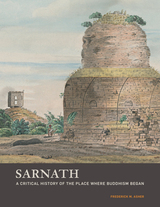 Sarnath: A Critical History of the Place Where Buddhism Began
Frederick M Asher
J. Paul Getty Trust, The, 2020 The first analytical history of Sarnath, the place where the Buddha preached his first sermon and established the Buddhist monastic order.
Sarnath has long been regarded as the place where the Buddha preached his first sermon and established the Buddhist monastic order. Excavations at Sarnath have yielded the foundations of temples and monastic dwellings, two Buddhist reliquary mounds (stupas), and some of the most important sculptures in the history of Indian art. This volume offers the first critical examination of the historic site.
Frederick M. Asher provides a longue durée (long-term) analysis of Sarnath—including the plunder, excavation, and display of antiquities and the Archaeological Survey of India’s presentation—and considers what lies beyond the fenced-in excavated area. His analytical history of Sarnath’s architectural and sculptural remains contains a significant study of the site’s sculptures, their uneven production, and their global distribution. Asher also examines modern Sarnath, which is a living establishment replete with new temples and monasteries that constitute a Buddhist presence on the outskirts of Varanasi, the most sacred Hindu city.
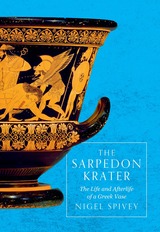 The Sarpedon Krater: The Life and Afterlife of a Greek Vase
Nigel Spivey
University of Chicago Press, 2019 Perhaps the most spectacular of all Greek vases, the Sarpedon krater depicts the body of Sarpedon, a hero of the Trojan War, being carried away to his homeland for burial. It was decorated some 2,500 years ago by Athenian artist Euphronios, and its subsequent history involves tomb raiding, intrigue, duplicity, litigation, international outrage, and possibly even homicide. How this came about is told by Nigel Spivey in a concise, stylish book that braids together the creation and adventures of this extraordinary object with an exploration of its abiding influence.
Spivey takes the reader on a dramatic journey, beginning with the krater’s looting from an Etruscan tomb in 1971 and its acquisition by the Metropolitan Museum of Art, New York, followed by a high-profile lawsuit over its status and its eventual return to Italy. He explains where, how, and why the vase was produced, retrieving what we know about the life and legend of Sarpedon. Spivey also pursues the figural motif of the slain Sarpedon portrayed on the vase and traces how this motif became a standard way of representing the dead and dying in Western art, especially during the Renaissance.
Fascinating and informative, The Sarpedon Krater is a multifaceted introduction to the enduring influence of Greek art on the world.
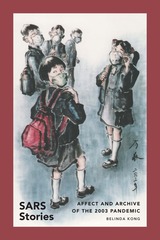 SARS Stories: Affect and Archive of the 2003 Pandemic
Belinda Kong
Duke University Press, 2024 In SARS Stories, Belinda Kong delves into the cultural archive of the 2003 SARS pandemic, examining Chinese-language creative works and social practices at the epicenters of the outbreak in China and Hong Kong. As the COVID-19 pandemic has highlighted issues of anti-Asian racism and sinophobia, Kong traces how Chinese people navigated the SARS pandemic and created meaning amid crisis through cultures of epidemic expression. From sentimental romances and Cantopop songs to raunchy sex comedies and crowdsourced ghost tales, unexpected and minor genres and creators of Chinese popular culture highlight the resilience and humanity of those living through the pandemic. Rather than narrating pandemic life in terms of crisis and catastrophe, Kong argues that these works highlight Chinese practices of community, care, and love amid disease. She also highlights the persistence of orientalism in anglophone accounts of SARS index patients and global reporting on COVID-era China. Kong shows how the Chinese experiences of living with SARS can reshape global feelings toward pandemic social life and foster greater fellowship in the face of pandemics.
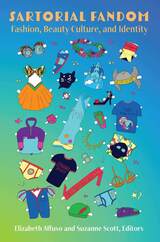 Sartorial Fandom: Fashion, Beauty Culture, and Identity
Elizabeth Affuso and Suzanne Scott, Editors
University of Michigan Press, 2023 In recent years, geeks have become chic, and the fashion and beauty industries have responded to this trend with a plethora of fashion-forward merchandise aimed at the increasingly lucrative fan demographic. This mainstreaming of fan identity is reflected in the glut of pop culture T-shirts lining the aisles of big box retailers as well as the proliferation of fan-focused lifestyle brands and digital retailers over the past decade. While fashion and beauty have long been integrated into the media industry with tie-in lines, franchise products, and other forms of merchandise, there has been limited study of fans’ relationship to these items and industries.
Sartorial Fandom shines a spotlight on the fashion and beauty cultures that undergird fandoms, considering the retailers, branded products, and fan-made objects that serve as forms of identity expression. This collection is invested in the subcultural and mainstream expression of style and in the spaces where the two intersect. Fan culture is, in many respects, an optimal space to situate a study of style because fandom itself is often situated between the subcultural and the mainstream. Collectively, the chapters in this anthology explore how various axes of lived identity interact with a growing movement to consider fandom as a lifestyle category, ultimately contending that sartorial practices are central to fan expression but also indicative of the primacy of fandom in contemporary taste cultures.
Sartorial Politics in Early Modern Europe: Fashioning Women
Erin Griffey
Amsterdam University Press, 2019 For women at the early modern courts, clothing and jewellery were essential elements in their political arsenal, enabling them to signal their dynastic value, to promote loyalty to their marital court and to advance political agendas. This is the first collection of essays to examine how elite women in early modern Europe marshalled clothing and jewellery for political ends. With essays encompassing women who traversed courts in Denmark, England, France, Germany, Habsburg Austria, Italy, Portugal, Spain and Sweden, the contributions cover a broad range of elite women from different courts and religious backgrounds as well as varying noble ranks.
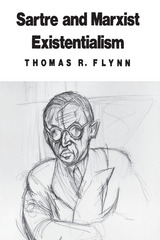 Sartre and Marxist Existentialism: The Test Case of Collective Responsibility
Thomas R. Flynn
University of Chicago Press, 1986 In this important book, Thomas R. Flynn reinterprets and evaluates Sartre's social and political philosophy, arguing that the existential ethics of Sartre's early phase is consistent with the Marxist-inspired views of his later writings. Displaying his mastery of Sartre's entire corpus, Flynn reconstructs Sartre's social ontology with its sensitive balance of the existentialist's respect for moral responsibility and the Marxist's sense of social causation. Flynn focuses on the issue of collective responsibility as a particularly apt test-case for assessing any proposed union of existentialist and Marxist perspectives.
The study begins with an examination of the uses of "responsibility" in Being and Nothingness and in several postwar essays. Flynn then concentrates on the Critique of Dialectical Reason, offering a thorough analysis of the remarkable social theory Sartre constructs there. A masterful contribution to Sartre scholarship, Sartre and Marxist Existentialism will be of great interest to social and political philosophers involved in the debate over collective responsibility.
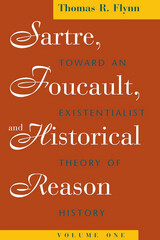 Sartre, Foucault, and Historical Reason, Volume One: Toward an Existentialist Theory of History
Thomas R. Flynn
University of Chicago Press, 1997 Sartre and Foucault were two of the most prominent and at times mutually antagonistic philosophical figures of the twentieth century. And nowhere are the antithetical natures of their existentialist and poststructuralist philosophies more apparent than in their disparate approaches to historical understanding.
A history, thought Foucault, should be a kind of map, a comparative charting of structural transformations and displacements. But for Sartre, authentic historical understanding demanded a much more personal and committed narrative, a kind of interpretive diary of moral choices and risks compelled by critical necessity and an exacting reality. Sartre's history, a rational history of individual lives and their intrinsic social worlds, was in essence immersed in biography.
In Volume One of this authoritative two-volume work, Thomas R. Flynn conducts a pivotal and comprehensive reconstruction of Sartrean historical theory, and provocatively anticipates the Foucauldian counterpoint to come in Volume Two.
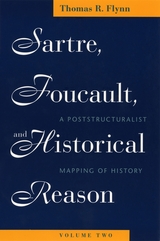 Sartre, Foucault, and Historical Reason, Volume Two: A Poststructuralist Mapping of History
Thomas R. Flynn
University of Chicago Press, 2005 Sartre and Foucault were two of the most prominent and at times mutually antagonistic philosophical figures of the twentieth century. And nowhere are the antithetical natures of their existentialist and poststructuralist philosophies more apparent than in their disparate approaches to historical understanding. In Volume One of this authoritative two-volume study, Thomas R. Flynn conducted a pivotal and comprehensive reconstruction of Sartrean historical theory. This long-awaited second volume offers a comprehensive and critical reading of the Foucauldian counterpoint.
A history, theorized Foucault, should be a kind of map, a comprehensive charting of structural transformations and displacements over time. Contrary to other Foucault scholars, Flynn proposes an "axial" rather than a developmental reading of Foucault's work. This allows aspects of Foucault's famous triad of knowledge, power, and the subject to emerge in each of his major works. Flynn maps existentialist categories across Foucault's "quadrilateral," the model that Foucault proposes as defining modernist conceptions of knowledge. At stake is the degree to which Sartre's thought is fully captured by this mapping, whether he was, as Foucault claimed, "a man of the nineteenth century trying to think in the twentieth."
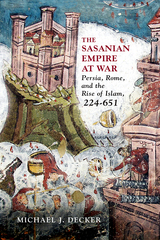 The Sasanian Empire at War: Persia, Rome, and the Rise of Islam, 224–651
Michael J. Decker
Westholme Publishing, 2025 A comprehensive military history of one of the most important empires of Late Antiquity The Sasanian Empire at War: Persia, Rome, and the Rise of Islam, 224–651 is the first comprehensive study in English examining war and society in one of the most important empires in world history: the Persian Empire of 224-651 AD, ruled by the Sasanian clan. At its height the Sasanians governed lands from the Indus River in the east to Egypt and the Mediterranean in the west. Adversaries of Rome, they also faced grave challenges from nomadic powers from Central Asia, notably the Huns and Turks. The Sasanians were able to maintain their empire for hundreds of years through nearly constant warfare, but when their expansion was checked in the north by the Byzantines at Constantinople in 626, and with the Muslim invasions to their south and west beginning in the 630s, the empire could no longer be sustained, and it finally collapsed. In this book, Michael J. Decker examines Sasanian warfare, including military capabilities, major confrontations, organization and weapons of the Persian army. In addition to providing a comprehensive overview of the conflicts that marked this vital period in the history of Eurasia, The Sasanian Empire at War challenges long cherished notions of the inferiority of Sasanian military capabilities and renders a new image of a sophisticated, confident culture astride the heart of Eurasia at the end of the ancient world and birth of the Silk Road. Persian arms were among the many features of their culture that drew widespread admiration and was one of the keys to the survival of Iranian culture beyond the Arab Conquest and into the present day.
Sasanian Remains from Qasr-i Abu Nasr: Seals, Sealings, and Coins
Richard N. Frye
Harvard University Press, 1973 This volume, the first in a new Harvard Iranian Series, brings together some of the objects uncovered at Qasr-i Abu Nasr. Including contributions by Joseph Upton, Prudence Harper, and George Miles, the study begins with a brief geographical orientation to the area and the site. Following are comprehensive analyses of the objects found, with primary emphasis placed on the seals, sealings, and coins. Maps, photographs, and extensive cross-reference lists of the seal impressions are provided. Highlighting this important work are more than 450 seal impressions by Charles Wilkinson.
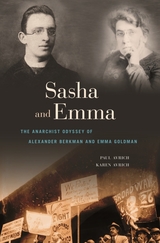 Sasha and Emma: The Anarchist Odyssey of Alexander Berkman and Emma Goldman
Paul Avrich and Karen Avrich
Harvard University Press, 2012 In 1889 two Russian immigrants, Emma Goldman and Alexander Berkman, met in a coffee shop on the Lower East Side. Over the next fifty years Emma and Sasha would be fast friends, fleeting lovers, and loyal comrades. This dual biography offers an unprecedented glimpse into their intertwined lives, the lasting influence of the anarchist movement they shaped, and their unyielding commitment to equality and justice.
Berkman shocked the country in 1892 with "the first terrorist act in America," the failed assassination of the industrialist Henry Clay Frick for his crimes against workers. Passionate and pitiless, gloomy yet gentle, Berkman remained Goldman's closest confidant though the two were often separated-by his fourteen-year imprisonment and by Emma's growing fame as the champion of a multitude of causes, from sexual liberation to freedom of speech. The blazing sun to Sasha's morose moon, Emma became known as "the most dangerous woman in America." Through an attempted prison breakout, multiple bombing plots, and a dramatic deportation from America, these two unrelenting activists insisted on the improbable ideal of a socially just, self-governing utopia, a vision that has shaped movements across the past century, most recently Occupy Wall Street.
Sasha and Emma is the culminating work of acclaimed historian of anarchism Paul Avrich. Before his death, Avrich asked his daughter to complete his magnum opus. The resulting collaboration, epic in scope, intimate in detail, examines the possibilities and perils of political faith and protest, through a pair who both terrified and dazzled the world.
 Sassetta: The Borgo San Sepolcro Altarpiece
Machtelt Israëls
Harvard University Press, 2009 Sassetta, the subtle genius from Siena, revolutionized Italian painting with an altarpiece for the small Tuscan town of Borgo San Sepolcro in 1437–1444. Originally standing some six yards high, double-sided, with a splendid gilt frame over the main altar of the local Franciscan church, it was the Rolls Royce of early Renaissance painting. But its myriad figures and scenes tempted the collectors of the nineteenth and twentieth centuries, and today its disassembled panels can be found in twelve museums throughout Europe and the United States.
To produce this landmark volume, experts in art and general history, painting technique and conservation, woodworking, architecture, and liturgy have joined forces across the boundaries of eight different nations. A model of collaboration, it opens new windows onto the creative process of the artist as he confronted a late-medieval church at a crossroad of cultures, the miracle-working body of a holy man, and a community of Franciscan friars breathing the exhilarating air of reform. To confront such challenges, Sassetta raised the most spiritual school of early Italian art, the Sienese, to a higher level of understanding, grace, and splendor.
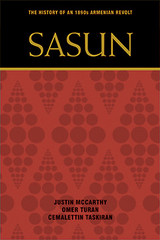 Sasun: The History of an 1890s Armenian Revolt
Justin McCarthy
University of Utah Press, 2014 Sasun, a region of Anatolia formerly under Ottoman rule and today part of eastern Turkey, is frequently recounted in history books as the site where, in 1894, the Turks murdered anywhere from 3,000 to 10,000 Armenian Christians. News reports at the time detailed that gruesome acts, including torture, had occurred at Sasun at the hands of the Ottoman army. The Ottoman Empire denied these allegations. A commission of European delegates sent to investigate the matter concluded that the news reports were highly exaggerated, yet the original stories of atrocities have persisted. This volume provides a close examination of the historical evidence to shed light on what really happened at Sasun. The authors’ research indicates that the stories circulated by the media of torture and murder in Sasun don’t hold up against the findings of the European investigators though they were motivated by sympathy with Armenian Christians. Evidence instead showed that an Armenian revolt had led to fights with local Kurds and much smaller numbers of deaths, on both sides. The conflict had largely subsided before the arrival of the Ottoman army on the scene.
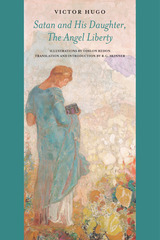 Satan and His Daughter, the Angel Liberty: Selected Verses
Victor Hugo
Swan Isle Press, 2018 Victor Hugo spent years in political exile off the coast of Normandy. While there, he produced his masterpiece, Les Misérables—but that wasn’t all: he also wrote a book-length poem, La Fin de Satan, left unfinished and not published until after his death.
Satan and his Daughter, the Angel Liberty, drawn from this larger poem, tells the story of Satan and his daughter, the angel created by God from a feather left behind following his banishment. Hugo details Satan’s fall, and through a despairing soliloquy, reveals him intent on revenge, yet desiring God’s forgiveness. The angel Liberty, meanwhile, is presented by Hugo as the embodiment of good, working to convince her father to return to Heaven.
This new translation by Richard Skinner presents Hugo’s verse in a unique prose approach to the poet’s poignant work, and is accompanied by the Symbolist artist Odilon Redon’s haunting illustrations. No adventurous reader will want to miss this beautiful mingling of the epic and familial, religious and political.
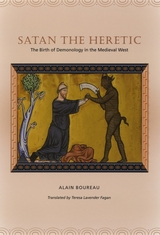 Satan the Heretic: The Birth of Demonology in the Medieval West
Alain Boureau
University of Chicago Press, 2006 Before the end of the thirteenth century, theologians had little interest in demons, but with Thomas Aquinas and his formidable “Treatise on Evil” in 1272, everything changed. In Satan the Heretic, Alain Boureau trains his skeptical eye not on Satan or Satanism, but on the birth of demonology and the sudden belief in the power of demons who inhabited Satan’s Court, setting out to understand not why people believed in demons, but why theologians—especially Pope John XXII—became so interested in the subject.
Depicting this new demonology, Satan the Heretic considers the period between the mid-thirteenth and mid-fourteenth centuries when demons, in the eyes of Church authorities, suddenly burst forth, more real and more terrifying than ever before in the history of Christianity. Boureau argues that the rise in this obsession with demons occurs at the crossroads of the rise of sovereignties and of the individual, a rise that, tellingly, also coincides with the emergence of the modern legal system in the European West.
Teeming with original insights and lively anecdotes, Satan the Heretic is a significant contribution to the history of Christian demonology from one of the most original minds in the field of medieval studies today.
Satanism and Feminism in Popular Culture: Not Today Satan
Miranda Corcoran
Amsterdam University Press, 2025 This book constitutes a timely and necessary intervention in the academic study of Satanism. At the same time, the book also constitutes a vital addition to the field of Gothic and Horror Studies. Although recent years have witnessed a revival of interest in figures such as the witch, the zombie and the vampire, Satan and his acolytes have been largely ignored (aside from where they overlap with the witch). This volume seeks to address this lacuna in Gothic Studies by examining how Satanism—particularly as it relates to issues of gender and sexuality—has shaped both the aesthetic and thematic content of horror media over the past half century.
Satanism and Feminism in Popular Culture: Not Today Satan
Miranda Corcoran
Amsterdam University Press, 2025 This book constitutes a timely and necessary intervention in the academic study of Satanism. At the same time, the book also constitutes a vital addition to the field of Gothic and Horror Studies. Although recent years have witnessed a revival of interest in figures such as the witch, the zombie and the vampire, Satan and his acolytes have been largely ignored (aside from where they overlap with the witch). This volume seeks to address this lacuna in Gothic Studies by examining how Satanism—particularly as it relates to issues of gender and sexuality—has shaped both the aesthetic and thematic content of horror media over the past half century.
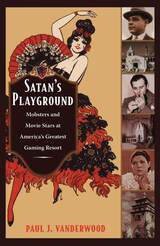 Satan's Playground: Mobsters and Movie Stars at America's Greatest Gaming Resort
Paul J. Vanderwood
Duke University Press, 2010 Satan’s Playground chronicles the rise and fall of the tumultuous and lucrative gambling industry that developed just south of the U.S.-Mexico border in the early twentieth century. As prohibitions against liquor, horse racing, gambling, and prostitution swept the United States, the vice industry flourished in and around Tijuana, to the extent that reformers came to call the town “Satan’s Playground,” unintentionally increasing its licentious allure. The area was dominated by Agua Caliente, a large, elegant gaming resort opened by four entrepreneurial Border Barons (three Americans and one Mexican) in 1928. Diplomats, royalty, film stars, sports celebrities, politicians, patricians, and nouveau-riche capitalists flocked to Agua Caliente’s luxurious complex of casinos, hotels, cabarets, and sports extravaganzas, and to its world-renowned thoroughbred racetrack. Clark Gable, Jean Harlow, Louis B. Mayer, the Marx Brothers, Bing Crosby, Charlie Chaplin, Gloria Swanson, and the boxer Jack Dempsey were among the regular visitors. So were mobsters such as Bugsy Siegel, who later cited Agua Caliente as his inspiration for building the first such resort on what became the Las Vegas Strip. Less than a year after Agua Caliente opened, gangsters held up its money-car in transit to a bank in San Diego, killing the courier and a guard and stealing the company money pouch. Paul J. Vanderwood weaves the story of this heist gone wrong, the search for the killers, and their sensational trial into the overall history of the often-chaotic development of Agua Caliente, Tijuana, and Southern California. Drawing on newspaper accounts, police files, court records, personal memoirs, oral histories, and “true detective” magazines, he presents a fascinating portrait of vice and society in the Jazz Age, and he makes a significant contribution to the history of the U.S.-Mexico border.
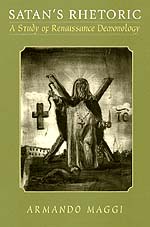 Satan's Rhetoric: A Study of Renaissance Demonology
Armando Maggi
University of Chicago Press, 2001 According to Christian theology, fallen angels share key similarities with human beings because they share our outcast condition. Cast to Earth and wandering in search of respite, their chief activity is their engagement and dialogue with humanity.
With this probing new contribution to the study of Christianity, Armando Maggi examines this dialogue, exploring how evil spirits interacted with mankind during the early modern period. Reading innumerable treatises on demonology written during the Renaissance, including Thesaurus exorcismorum, the most important record of early modern exorcisms, Maggi finds repeated attempts to define the language exchanged between the fallen progeny of Adam, and the most notorious fallen angel of them all, Satan. Using points of departure taken from de Certeau and Lacan, Maggi shows that Satan articulates his language first and foremost in the mind. More than speaking, the devil tries to make human beings understand his language and speak it themselves. Through sodomites, infidels, and witches, then, the devil is able to infect humanity as it appropriates his seductive rhetoric.
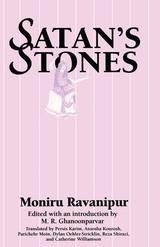 Satan's Stones
By Moniru Ravanipur
University of Texas Press, 1996 Women writers occupy prominent positions in late 20th century Iranian literature, despite the increased legal and cultural restrictions placed upon women since the 1978-1979 Islamic Revolution. One of these writers is Moniru Ravanipur, author of the critically acclaimed The Drowned and Heart of Steel. Satan's Stones is the first English translation of her 1991 short story collection Sangha-ye Sheytan. Often set in the remote regions of Iran, these stories explore many facets of contemporary Iranian life, particularly the ever-shifting relations between women and men. Their bold literary experimentation marks a new style in Persian fiction akin to "magical realism." Reports from Iran indicated that Satan's Stones had been banned there by government authorities. While its frank explorations of Iranian society may have offended Islamic leaders, they offer Western readers fresh perspectives on Iranian culture from one of the country's most distinguished writers.
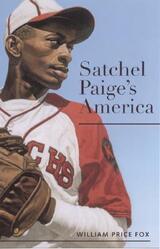 Satchel Paige's America
William Price Fox
University of Alabama Press, 2005 Captures the sometimes outrageous, often humorous, and always bigger-than-life spirit of the World's Greatest Pitcher, Leroy Satchel Paige This book began when the author met "the Satch" for the first time at the Twilight Zone Lounge of the Rhythm Lanes Bowling Alley in Kansas City. What started as a simple interview for Holiday magazine quickly grew into an animated conversation that lasted nearly a week as Paige and Fox moved from bar to club to restaurant to auto repair shop and from one topic to the next. Fox describes, with amazement, the reception the legendary baseball player received at Gates' Place, a famous barbecue restaurant, and The Flamingo, a big dance club. Over the course of the week, Paige shared stories about his start in the Negro leagues, his time with the Kansas City Monarchs, and barnstorming around the country, sleeping on the ground because there were no hotels for blacks. He also tells of his breakthrough to the big leagues when he signed with the Cleveland Indians and later pitched two shutouts against the Chicago White Sox. In addition to his baseball career, Paige tells Fox about his childhood in Mobile, Alabama, catching fish during the Jubilee, throwing rocks at white boys, hustling bags at the train station, and working in the Depression era medicine shows. In contrast to these humble beginnings, Satchel recounts his later connections with film and music celebrities like Orson Welles, Jelly Roll Morton, Billie Holliday, and Cab Calloway. He also expounds on his friendships with other sports greats, including Goose Tatum, Meadowlark Lemon, and Sugar Ray Robinson. The ironic intersections between oppression and fame, and between poverty and wealth, that emerge from Paige's narrative memoir exemplify the affliction of talent and genius in an era of racial discrimination and segregation.
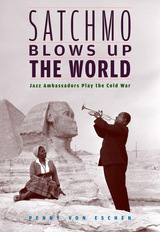 Satchmo Blows Up the World: Jazz Ambassadors Play the Cold War
Penny M. Von Eschen
Harvard University Press, 2006 At the height of the ideological antagonism of the Cold War, the U.S. State Department unleashed an unexpected tool in its battle against Communism: jazz. From 1956 through the late 1970s, America dispatched its finest jazz musicians to the far corners of the earth, from Iraq to India, from the Congo to the Soviet Union, in order to win the hearts and minds of the Third World and to counter perceptions of American racism.
Penny Von Eschen escorts us across the globe, backstage and onstage, as Dizzy Gillespie, Louis Armstrong, Duke Ellington, and other jazz luminaries spread their music and their ideas further than the State Department anticipated. Both in concert and after hours, through political statements and romantic liaisons, these musicians broke through the government's official narrative and gave their audiences an unprecedented vision of the black American experience. In the process, new collaborations developed between Americans and the formerly colonized peoples of Africa, Asia, and the Middle East--collaborations that fostered greater racial pride and solidarity.
Though intended as a color-blind promotion of democracy, this unique Cold War strategy unintentionally demonstrated the essential role of African Americans in U.S. national culture. Through the tales of these tours, Von Eschen captures the fascinating interplay between the efforts of the State Department and the progressive agendas of the artists themselves, as all struggled to redefine a more inclusive and integrated American nation on the world stage.
 Satellite Communication Systems
B.G. Evans
The Institution of Engineering and Technology, 1999 This updated and extended new edition has been compiled from the course material of the highly successful IEE Vacation School of the same name. The vacation school was designed to give a broad introduction to the subject of satellite communications and provide the background knowledge and tools of the trade for those entering the field. The 3rd edition of the book continues this theme and up-to-date information on mobile and personal satellite constellations, navigation and positioning, and military and small satellite systems has been added, as well as a look to future Ka-band multimedia systems. We have also included updated ITU information and sections on history, organisation and the satellite business. The book differs from others on the subject in its pragmatic and engineering-oriented approach. The contributors are all current practitioners from industry or academics specialising in the field.
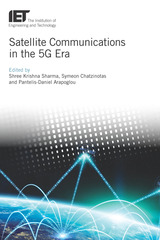 Satellite Communications in the 5G Era
Shree Krishna Sharma
The Institution of Engineering and Technology, 2018 Satellite communications (SatCom) plays a vital role in ensuring seamless access to telecommunications services anytime, and is a viable option for delivering telecommunication services in a wide range of sectors such as aeronautical, military, maritime, rescue and disaster relief. It should be an important component of 5G-and-beyond wireless architectures as it can complement terrestrial telecommunication solutions in various scenarios to provide highly reliable and secure connectivity over a wide geographical area. This book explores promising scenarios for 5G SatCom, novel paradigms for hybrid/integrated satellite-terrestrial integration, and emerging technologies for the next generation of SatCom systems. Topics covered include: Role of SatCom in the 5G Era; 5G satellite use cases and scenarios; SDN-enabled networks, NFV-based scenarios and on-board processing for satellite-terrestrial integration; EHF broadband aeronautical SatCom systems; Next-generation NGSO SatCom systems; Diversity combining and handover techniques for MEO satellites; Non-linear countermeasures for multicarrier satellites; SDN demonstrator for multi-beam satellite precoding; Beam-hopping SatCom systems; Optical on-off keying data links for LEO downlink applications; Ultra-high speed data relay systems; On-board interference detection and localization; Advanced random access schemes for SatCom systems; Interference avoidance, mitigation and dynamic spectrum sharing for hybrid satellite-terrestrial systems; and Two-way satellite relaying.
Satellites
Edited by Joseph A. Burns and Mildred Shapley Mathews
University of Arizona Press, 1986 "This is the 12th book in the University of Arizona Space Science Series, a burgeoning library destined to stand as the consummate literary legacy of our era's revolution in Solar System exploration. . . . Satellite science has matured rapidly since its rebirth in March 1979, and its vitality radiates from the pages of this fine volume."—Icarus
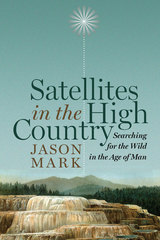 Satellites in the High Country: Searching for the Wild in the Age of Man
Jason Mark
Island Press, 2015 In New Mexico's Gila Wilderness, 106 Mexican gray wolves may be some of the most monitored wildlife on the planet. Collared, microchipped, and transported by helicopter, the wolves are protected and confined in an attempt to appease ranchers and conservationists alike. Once a symbol of the wild, these wolves have come to illustrate the demise of wilderness in this Human Age, where man's efforts shape life in even the most remote corners of the earth. And yet, the howl of an unregistered wolf—half of a rogue pair—splits the night. If you know where to look, you'll find that much remains untamed, and even today, wildness can remain a touchstone for our relationship with the rest of nature.
In Satellites in the High Country, journalist and adventurer Jason Mark travels beyond the bright lights and certainties of our cities to seek wildness wherever it survives. In California's Point Reyes National Seashore, a battle over oyster farming and designated wilderness pits former allies against one another, as locals wonder whether wilderness should be untouched, farmed, or something in between. In Washington's Cascade Mountains, a modern-day wild woman and her students learn to tan hides and start fires without matches, attempting to connect with a primal past out of reach for the rest of society. And in Colorado's High Country, dark skies and clear air reveal a breathtaking expanse of stars, flawed only by the arc of a satellite passing—beauty interrupted by the traffic of a million conversations. These expeditions to the edges of civilization's grid show us that, although our notions of pristine nature may be shattering, the mystery of the wild still exists — and in fact, it is more crucial than ever.
But wildness is wily as a coyote: you have to be willing to track it to understand the least thing about it. Satellites in the High Country is an epic journey on the trail of the wild, a poetic and incisive exploration of its meaning and enduring power in our Human Age.
Satellites of Jupiter
David Morrison
University of Arizona Press, 1982 Originally published in 1982
From the original publication:
The findings of Voyager have brought Jupiter's moons out from the shadows. Now as much of interest to geologists as to astronomers, these satellites are brought under closer scrutiny by more than 50 international authorities in this volume. Included is research on thermal evolution, surface composition, cratering time scales, and other subjects; but also key chapters focusing on the satellite Io's volcanic eruptions, thermodynamics, phase composition and more. These 24 contributions constitute a reference that will stand as the decade's definitive work on Jupiter's satellites and a springboard to further hypotheses.
Satellite-to-Ground Radiowave Propagation
J.E. Allnutt
The Institution of Engineering and Technology, 2011 This book is a follow-up to the award-winning first edition and is written as a comprehensive guide for those who need to obtain a working knowledge of radiowave propagation on satellite-to-ground links at frequencies above 1 GHz and as a reference book for experts in the field. To accomplish this, expanded sections of explanatory text, copiously illustrated, enable an undergraduate or non-specialist to grasp the fundamentals involved. An extensive reference list permits the expert to go to the source material should the level of enquiry go beyond the level of this book.
Satire and the Correspondence of Swift
Craig Hawkins Ulman
Harvard University Press, 1973 Since the first secret publication, in 1740, of part of his correspondence with Alexander Pope, Jonathan Swift's letters have become a standard source for his biographers and critics. Craig Ulman argues that the letters are not entirely reliable for biographical fact and have often been taken too literally. In this readable essay, Ulman surveys the satiric material in Swift's correspondence, highlighting his wit. The author views Swift's epistolary writing as very much a literary endeavor. He examines the pose and the persona and discusses the satiric methods the letters share with Swift's other published works.
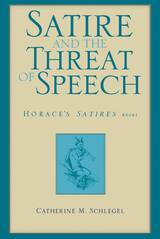 Satire and the Threat of Speech: Horace's Satires, Book 1
Catherine M. Schlegel
University of Wisconsin Press, 2006 In his first book of Satires, written in the late, violent days of the Roman republic, Horace exposes satiric speech as a tool of power and domination. Using critical theories from classics, speech act theory, and others, Catherine Schlegel argues that Horace's acute poetic observation of hostile speech provides insights into the operations of verbal control that are relevant to his time and to ours. She demonstrates that though Horace is forced by his political circumstances to develop a new, unthreatening style of satire, his poems contain a challenge to our most profound habits of violence, hierarchy, and domination. Focusing on the relationships between speaker and audience and between old and new style, Schlegel examines the internal conflicts of a notoriously difficult text. This exciting contribution to the field of Horatian studies will be of interest to classicists as well as other scholars interested in the genre of satire.
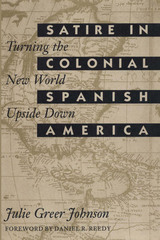 Satire in Colonial Spanish America: Turning the New World Upside Down
By Julie Greer Johnson
University of Texas Press, 1993 Satire, the use of criticism cloaked in wit, has been employed since classical times to challenge the established order of society. In colonial Spanish America during the sixteenth through the eighteenth centuries, many writers used satire to resist Spanish-imposed social and literary forms and find an authentic Latin American voice. This study explores the work of eight satirists of the colonial period and shows how their literary innovations had a formative influence on the development of the modern Latin American novel, essay, and autobiography. The writers studied here include Sor Juana Inés de la Cruz, Juan del Valle y Caviedes, Cristóbal de Llerena, and Eugenio Espejo. Johnson chronicles how they used satire to challenge the "New World as Utopia" myth propagated by Spanish authorities and criticize the Catholic church for its role in fulfilling imperialistic designs. She also shows how their marginalized status as Creoles without the rights and privileges of their Spanish heritage made them effective satirists. From their writings, she asserts, emerges the first self-awareness and national consciousness of Spanish America. By linking the two great periods of Latin American literarure—the colonial writers and the modern generation—Satire in Colonial Spanish America makes an important contribution to Latin American literature and culture studies. It will also be of interest to all literary scholars who study satire.
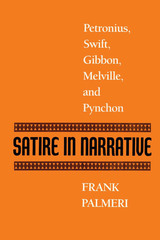 Satire in Narrative: Petronius, Swift, Gibbon, Melville, & Pynchon
By Frank Palmeri
University of Texas Press, 1990 Virtually all theories of satire define it as a criticism of contemporary society. Some argue that satire criticizes the present in favor of a standard of values that has been superseded, and thus that satire is generally backward-looking and conservative. While this is often true of poetic satire, in this study Frank Palmeri asserts that narrative satire performs a different function, that it parodies both the established view of the world and that of its opponents, offering its own distinctive critical perspective. This theory of satire builds on the idea of dialogical parody in the work of Russian theorist Mikhail Bakhtin, while revising Bakhtin's estimate of carnival. In Palmeri's view, the carnivalesque offers only an inverted mirror image of authoritative discourse, while parodic narrative satire suggests an alternative to both the official world and its inverted opposite. Palmeri applies this theory of narrative satire to five works of world literature, each of which has generated sharp controversy about the genre to which it rightly belongs: Petronius' Satyricon, Jonathan Swift's A Tale of a Tub, Edward Gibbon's Decline and Fall of the Roman Empire, Herman Melville's The Confidence-Man, and Thomas Pynchon's The Crying of Lot 49. He analyzes the features that link these works and shows how the changing pairs of alternatives that are parodied in these satires reflect changes in the terms of social and cultural oppositions. Satire in Narrative will appeal to comparatists, specialists in eighteenth-century and American literature, and others interested in theories of genre and the relations between literary forms and social history.
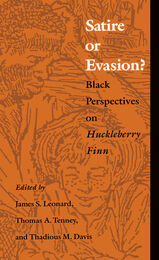 Satire or Evasion?: Black Perspectives on Huckleberry Finn
James S. Leonard, Thomas A. Tenney and Thadious M. Davis, eds.
Duke University Press, 1992 Though one of America’s best known and loved novels, Mark Twain’s Adventures of Huckleberry Finn has often been the object of fierce controversy because of its racist language and reliance on racial stereotypes. This collection of fifteen essays by prominent African American scholars and critics examines the novel’s racist elements and assesses the degree to which Twain’s ironies succeed or fail to turn those elements into a satirical attack on racism. Ranging from the laudatory to the openly hostile, these essays include personal impressions of Huckleberry Finn, descriptions of classroom experience with the book, evaluations of its ironic and allegorical aspects, explorations of its nineteenth-century context, and appraisal of its effects on twentieth-century African American writers. Among the issues the authors contend with are Twain’s pervasive use of the word “nigger,” his portrayal of the slave Jim according to the conventions of the minstrel show “darky,” and the thematic chaos created by the “evasion” depicted in the novel’s final chapters. Sure to provoke thought and stir debate, Satire or Evasion? provides a variety of new perspectives on one of this country’s most troubling classics. Contributors. Richard K. Barksdale, Bernard W. Bell, Mary Kemp Davis, Peaches M. Henry, Betty Harris Jones, Rhett S. Jones, Julius Lester, Donnarae MacCann, Charles H. Nichols, Charles H. Nilon, Arnold Rampersad, David L. Smith, Carmen Dubryan, John H. Wallace, Kenny Jackson Williams, Fredrick Woodard
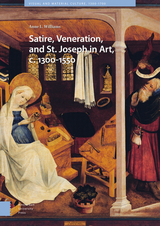 Satire, Veneration, and St. Joseph in Art, c. 1300-1550
Anne L. Williams
Amsterdam University Press, 2019 Satire, Veneration, and St. Joseph in Art, c. 1300.1550 is the first book to reclaim satire as a central component of Catholic altarpieces, devotional art, and veneration, moving beyond humor's relegation to the medieval margins or to the profane arts alone. The book challenges humor's perception as a mere teaching tool for the laity and the antithesis of 'high' veneration and theology, a divide perpetuated by Counter-Reformation thought and the inheritance of Mikhail Bakhtin (Rabelais and His World, 1965). It reveals how humor, laughter, and material culture played a critical role in establishing St. Joseph as an exemplar in western Europe as early as the thirteenth century. Its goal is to open a new line of interpretation in medieval and early modern cultural studies by revealing the functions of humor in sacred scenes, the role of laughter as veneration, and the importance of play for pre-Reformation religious experiences.
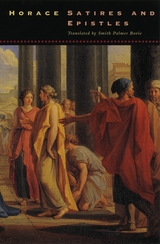 Satires and Epistles
Horace
University of Chicago Press, 1959 The writings of Horace have exerted strong and continuing influence on writers from his day to our own. Sophisticated and intellectual, witty and frank, he speaks to the cultivated and civilized world of today with the same astringent candor and sprightliness that appeared so fresh at the height of Rome's wealthy and glory.
The Satires and Epistles spans the poet's career as a satirist, critic, and master of lyric poetry, as man of the world, friend of the great, and relentless enemy of the mediocre. "Horace," writes translator Smith Palmer Bovie, "is the best antidote in the world for anxiety. His Satires and Epistles demonstrate the good-humored freedom of a man who has cheerfully assumed the responsibility for making his own life not so much a 'success' as the occasion for a true enjoyment of virtue and knowledge." Bovie's impeccable translation, along with Clancy's edition of the Odes and Epodes, offers the reader a complete and modern Horace.
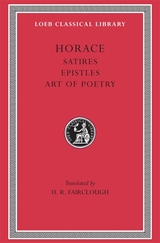 Satires. Epistles. Art of Poetry
Horace
Harvard University Press Artful hexameters.
Horace (Quintus Horatius Flaccus, 65–8 BC) was born at Venusia, son of a freedman clerk who had him well educated at Rome and Athens. Horace supported the ill-fated killers of Caesar, lost his property, became a secretary in the Treasury, and began to write poetry. Maecenas, lover of literature, to whom Virgil and Varius introduced Horace in 39, became his friend and made him largely independent by giving him a farm. After 30 Horace knew and aided with his pen the emperor Augustus, who after Virgil’s death in 19 engaged him to celebrate imperial affairs in poetry. Horace refused to become Augustus’ private secretary and died a few months after Maecenas. Both lyric (in various metres) and other work (in hexameters) was spread over the period 40–10 or 9 BC. It is Roman in spirit, Greek in technique.
In the two books of Satires Horace is a moderate social critic and commentator; the two books of Epistles are more intimate and polished, the second book being literary criticism as is also the Ars Poetica. The Epodes in various (mostly iambic) metres are akin to the ‘discourses’ (as Horace called his satires and epistles) but also look towards the famous Odes, in four books, in the old Greek lyric metres used with much skill. Some are national odes about public affairs; some are pleasant poems of love and wine; some are moral letters; all have a rare perfection. The Odes and Epodes are found in LCL 33.
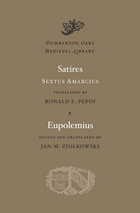 Satires. Eupolemius
Sextus Amarcius
Harvard University Press, 2011 Composed in Germany by a monastic poet steeped in classical lore and letters, the Satires of Amarcius (Sextus Amarcius Gallus Piosistratus) unrelentingly attack both secular vices and ecclesiastical abuses of the late eleventh century. The verses echo Horace and Prudentius, are laced with proverbs and polemic, and portray vividly aspects of contemporary life—the foppery of young nobles, the vainglory of the nouveaux riches, the fastidiousness of debauched gluttons. This is the first English translation of the Satires.
The Eupolemius is a late-eleventh-century Latin epic that recasts salvation history, from Lucifer’s fall through Christ’s resurrection. The poem fuses Greek and Hebrew components within a uniquely medieval framework. At once biblical, heroic, and allegorical, it complements the so-called Bible epics in Latin from late antiquity and the refashionings of biblical narrative in Old English verse. It emulates classical Latin epics by Virgil, Lucan, and Statius and responds creatively to the foundational personification allegory by the Christian poet Prudentius. The poem was composed by an anonymous German monk, possibly the author who used the pseudonym Amarcius. Although it focuses on events of both the Hebrew Bible and New Testament, it is also rooted in its own momentous times.
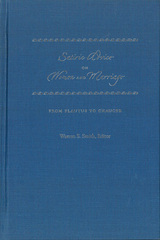 Satiric Advice on Women and Marriage: From Plautus to Chaucer
Warren S. Smith, Editor
University of Michigan Press, 2005 Advice on sex and marriage in the literature of antiquity and the middle ages typically stressed the negative: from stereotypes of nagging wives and cheating husbands to nightmarish visions of women empowered through marriage. Satiric Advice on Women and Marriage brings together the leading scholars of this fascinating body of literature. Their essays examine a variety of ancient and early medieval writers' cautionary and often eccentric marital satire beginning with Plautus in the third century B.C.E. through Chaucer (the only non-Latin author studied). The volume demonstrates the continuity in the Latin tradition which taps into the fear of marriage and intimacy shared by ancient ascetics (Lucretius), satirists (Juvenal), comic novelists (Apuleius), and by subsequent Christian writers starting with Tertullian and Jerome, who freely used these ancient sources for their own purposes, including propaganda for recruiting a celibate clergy and the promotion of detachment and asceticism as Christian ideals. Warren S. Smith is Professor of Classical Languages at the University of New Mexico.
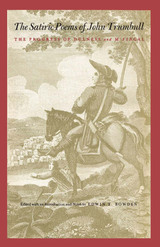 The Satiric Poems of John Trumbull: The Progress of Dulness and M'Fingal
Edited with an introduction and notes by Edwin T. Bowden
University of Texas Press, 1962 John Trumbull, the colonial American satiric poet, is one of the most readable, and certainly one of the most amusing, of our early men of letters. His poems, with all their wit and bite, bring back to life again the days of the Revolutionary War—powdered wigs, flirting belles, political quarrels, town meetings, brawling mobs, inept generals, flaming national purpose, and all. And if the colonial period seems a long way back in time, his satiric poem on the Progress of Dulness in education will show that time—or at least time in the colleges—has not moved so fast after all. Trumbull's two long poems, so important to the beginnings of America's national poetry and to an understanding of America's literary heritage, were out of print for a number of years and had, in fact, never before been accurately reprinted from the original versions. Here they are available, complete with the original biting prefaces, in a dependable text for the scholar, annotated for the general reader interested in the literature and history of the American eighteenth century. The annotation is inclusive but kept to a minimum.
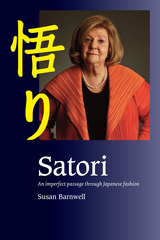 Satori: An Imperfect Passage Through Japanese Fashion
Susan Barnwell
Sussex Academic Press, 2022 Satori: An imperfect passage through Japanese fashion, offers an inclusive overview of Japanese fashion design that crosses disciplinary boundaries and helps define the next phase of global fashion design. It chronicles a personal forty-year passage by Susan Barnwell, sadly deceased in January 2019. Sue experienced the fantasy of theatre and television costume production in England, worked as a fashion editor of a daily newspaper in Hong Kong, and taught at Universities in Asia and North America. She worked with museums on costume reconstruction and with hospital research teams designing clothing and accessories for breast cancer survivors with lymphedema. Her multifaceted approach to design and research included exploring cultural space with aging populations in Tokyo and empowerment for sex trade workers in Toronto.
With some 50 colour illustrations, Satori presents a unique record of Japanese fashion design in a book that has been keenly anticipated by scholars, students and Asian fashion stylists. And it does so in a wide cultural context moving from the political realities of Hiroshima to emerging design philosophies Kenzo Tange, Issey Miyake, Isamu Noguchi, Rei Kawakub
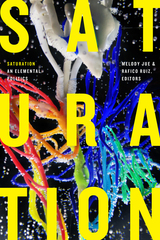 Saturation: An Elemental Politics
Melody Jue and Rafico Ruiz, editors
Duke University Press, 2021 Bringing together media studies and environmental humanities, the contributors to Saturation develop saturation as a heuristic to analyze phenomena in which the elements involved are difficult or impossible to separate. In ordinary language, saturation describes the condition of being thoroughly soaked, while in chemistry it is the threshold at which something can be maximally dissolved or absorbed in a solution. Contributors to this collection expand notions of saturation beyond water to consider saturation in sound, infrastructure, media, Big Data, capitalism, and visual culture. Essays include analyses of the thresholds of HIV detectability in bloodwork, militarism's saturation of oceans, and the deleterious effects of the saturation of cellphone and wi-fi signals into the human body. By channeling saturation to explore the relationship between media, the environment, technology, capital, and the legacies of settler colonialism, Saturation illuminates how elements, the natural world, and anthropogenic infrastructures, politics, and processes exist in and through each other.
Contributors. Marija Cetinić, Jeff Diamanti, Bishnupriya Ghosh, Lisa Yin Han, Stefan Helmreich, Mél Hogan, Melody Jue, Rahul Mukherjee, Max Ritts, Rafico Ruiz, Bhaskar Sarkar, John Shiga, Avery Slater, Janet Walker, Joanna Zylinska
 Saturday Is for Funerals
Unity Dow and Max Essex
Harvard University Press, 2011 In the year 2000 the World Health Organization estimated that 85 percent of fifteen-year-olds in Botswana would eventually die of AIDS. In Saturday Is for Funerals we learn why that won’t happen.
Unity Dow and Max Essex tell the true story of lives ravaged by AIDS—of orphans, bereaved parents, and widows; of families who devote most Saturdays to the burial of relatives and friends. We witness the actions of community leaders, medical professionals, research scientists, and educators of all types to see how an unprecedented epidemic of death and destruction is being stopped in its tracks.
This book describes how a country responded in a time of crisis. In the true-life stories of loss and quiet heroism, activism and scientific initiatives, we learn of new techniques that dramatically reduce rates of transmission from mother to child, new therapies that can save lives of many infected with AIDS, and intricate knowledge about the spread of HIV, as well as issues of confidentiality, distributive justice, and human rights. The experiences of Botswana offer practical lessons along with the critical element of hope.
 Saturday Morning Censors: Television Regulation before the V-Chip
Heather Hendershot
Duke University Press, 1999 Many parents, politicians, and activists agree that there’s too much violence and not enough education on children’s television. Current solutions range from the legislative (the Children’s Television Act of 1990) to the technological (the V-chip). Saturday Morning Censors examines the history of adults’ attempts to safeguard children from the violence, sexism, racism, and commercialism on television since the 1950s. By focusing on what censorship and regulation are and how they work—rather than on whether they should exist—Heather Hendershot shows how adults use these processes to reinforce their own ideas about childhood innocence. Drawing on archival studio material, interviews with censors and animators, and social science research, Hendershot analyzes media activist strategies, sexism and racism at the level of cartoon manufacture, and the product-linked cartoons of the 1980s, such as Strawberry Shortcake and Transformers. But in order to more fully examine adult reception of children’s TV, she also discusses “good” programs like Sesame Street and Fat Albert and the Cosby Kids. Providing valuable historical context for debates surrounding such current issues as the V-chip and the banning of Power Rangers toys in elementary schools, Saturday Morning Censors demonstrates how censorship can reveal more fears than it hides. Saturday Morning Censors will appeal to educators, parents, and media activists, as well as to those in cultural studies, television studies, gender studies, and American social history.
Saturn
Tom Gehrels
University of Arizona Press, 1984 Originally published in 1984
From the original publication:
The Saturn system is the most complex in the solar system, and this book is to summarize it all: the planet, rings, satellites, the magnetospheres, and the interaction with the interplanetary medium. The effective date of the material is approximately November 1983.
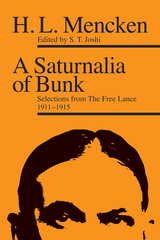 A Saturnalia of Bunk: Selections from The Free Lance, 1911–1915
H. L. Mencken
Ohio University Press, 2017 H. L. Mencken’s reputation as a journalist and cultural critic of the twentieth century has endured well into the twenty-first. His early contributions as a writer, however, are not very well known. He began his journalistic career as early as 1899 and in 1910 cofounded the Baltimore Evening Sun. The next year he initiated a column—The Free Lance—that ran six days a week for four and a half years, until the Sun discontinued it, partially in response to Mencken’s controversial defense of Germany during World War One. In this early forum for his renowned wit, Mencken broached many of the issues to which he would return again and again over his career, establishing himself as a fearless iconoclast willing to tackle the most divisive subjects and apply a heady mix of observation, satire, and repartee to clear away what he regarded as the “saturnalia of bunk” that clouded American thinking. The Free Lance reveals Mencken at his scintillating best as a journalist, polemicist, and satirist. These columns are collected here for the first time, edited and annotated by Mencken expert and critic S. T. Joshi. This extraordinary collection is an invaluable resource for Mencken scholars and fans and provides an entertaining immersion into the early twentieth-century American zeitgeist.
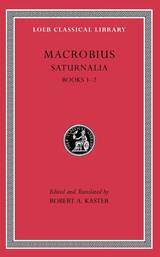 Saturnalia, Volume I: Books 1–2
Macrobius
Harvard University Press, 2011 An antiquarian’s festival.
The Saturnalia, Macrobius’ encyclopedic celebration of Roman culture written in the early fifth century AD, has been prized since the Renaissance as a treasure trove of otherwise unattested lore. Cast in the form of a dialogue, the Saturnalia treats subjects as diverse as the divinity of the Sun and the quirks of human digestion while showcasing Virgil as the master of all human knowledge from diction and rhetoric to philosophy and religion.
The new Latin text is based on a refined understanding of the medieval tradition and improves on Willis’ standard edition in nearly three hundred places. The accompanying translation—only the second in English and the only one now in print—offers a clear and sprightly rendition of Macrobius’ ornate Latin and is supplemented by ample annotation. A full introduction places the work in its cultural context and analyzes its construction, while indexes of names, ancient works cited in both text and notes, and topics make the work more readily accessible than ever before.
 Saturnalia, Volume II: Books 3–5
Macrobius
Harvard University Press, 2011 An antiquarian’s festival.
The Saturnalia, Macrobius’ encyclopedic celebration of Roman culture written in the early fifth century AD, has been prized since the Renaissance as a treasure trove of otherwise unattested lore. Cast in the form of a dialogue, the Saturnalia treats subjects as diverse as the divinity of the Sun and the quirks of human digestion while showcasing Virgil as the master of all human knowledge from diction and rhetoric to philosophy and religion.
The new Latin text is based on a refined understanding of the medieval tradition and improves on Willis’ standard edition in nearly three hundred places. The accompanying translation—only the second in English and the only one now in print—offers a clear and sprightly rendition of Macrobius’ ornate Latin and is supplemented by ample annotation. A full introduction places the work in its cultural context and analyzes its construction, while indexes of names, ancient works cited in both text and notes, and topics make the work more readily accessible than ever before.
 Saturnalia, Volume III: Books 6–7
Macrobius
Harvard University Press, 2011 An antiquarian’s festival.
The Saturnalia, Macrobius’ encyclopedic celebration of Roman culture written in the early fifth century AD, has been prized since the Renaissance as a treasure trove of otherwise unattested lore. Cast in the form of a dialogue, the Saturnalia treats subjects as diverse as the divinity of the Sun and the quirks of human digestion while showcasing Virgil as the master of all human knowledge from diction and rhetoric to philosophy and religion.
The new Latin text is based on a refined understanding of the medieval tradition and improves on Willis’ standard edition in nearly three hundred places. The accompanying translation—only the second in English and the only one now in print—offers a clear and sprightly rendition of Macrobius’ ornate Latin and is supplemented by ample annotation. A full introduction places the work in its cultural context and analyzes its construction, while indexes of names, ancient works cited in both text and notes, and topics make the work more readily accessible than ever before.
Saturnin
Zdenek Jirotka
Karolinum Press, 2016 On its initial publication in Czech in 1942, Saturnin was a best seller, its gentle satire offering an unexpected—if temporary—reprieve from the grim reality of the German occupation. In the years since, the novel has been hailed as a classic of Czech literature, and this translation makes it available to English-language readers for the first time—which is entirely appropriate, for author Zdeněk Jirotka clearly modeled his light comedy on the English masters Jerome K. Jerome and P. G. Wodehouse. The novel’s main character, Saturnin, a “gentleman’s gentleman” who obviously owes a debt to Wodehouse’s beloved Jeeves, wages a constant battle to protect his master from romantic disaster and intrusive relatives, such as Aunt Catherine, the “Prancing Dictionary of Slavic Proverbs.” Saturnin will warm the heart of any fan of literary comedy.
Saturnin
Zdenek Jirotka
Karolinum Press, 2013
On its initial publication in Czech in 1942, Saturnin was a best seller, its gentle satire offering an unexpected—if temporary—reprieve from the grim reality of the German occupation. In the years since, the novel has been hailed as a classic of Czech literature, and this translation makes it available to English-language readers for the first time—which is entirely appropriate, for author Zdeněk Jirotka clearly modeled his light comedy on the English masters Jerome K. Jerome and P. G. Wodehouse. The novel’s main character, Saturnin, a “gentleman’s gentleman” who obviously owes a debt to Wodehouse’s beloved Jeeves, wages a constant battle to protect his master from romantic disaster and intrusive relatives, such as Aunt Catherine, the “Prancing Dictionary of Slavic Proverbs.” Saturnin will warm the heart of any fan of literary comedy.
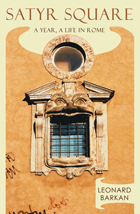 Satyr Square: A Year, a Life in Rome
Leonard Barkan
Northwestern University Press, 2008 Part memoir, part literary criticism, part culinary and aesthetic travelogue, this loving reflection is a poignant, funny narrative about an American professor spending a year in Rome. A scarred veteran of academic culture wars retreating to a cradle of culture, Barkan is at first hungry, lonely, and uncertain of his intellectual mission. But soon he is appointed unofficial mascot of an eccentric community of gastronomes, becomes virtually bilingual, and falls in love. As the year progresses, he finds his voice as a writer, loses his lover, and definitively returns to America with heart, mind, and body. His memoir is the celebration of a life lived in the uncanny spaces where art and real people intersect. Barkan’s reminiscence is not just about the Renaissance and ancient statuary, or Shakespeare and Mozart, Charles Bukowski and Paul de Man, eggplant antipasto and Brunello di Montalcino, foot fetishism and sulfur baths. At the heart of the narrative—beneath that beguiling surface of irony, humor, and misdirection—is a man of genuine ardor, struggling with what it means to be a homosexual and a Jew, trying to rediscover or reinvent his own intellectual passions. Hilarious, erudite, and lusciously rendered, Satyr Square gives us the whole of a life made up from fragments of Italy, art, food, and longing.
 Satyricon. Apocolocyntosis
Petronius and Seneca
Harvard University Press, 2020 Two rollicking Roman satires.
The Satyrica (Satyricon liber), a comic-picaresque fiction in prose and verse traditionally attributed to the Neronian Petronius (d. AD 66) but possibly of Flavian or Trajanic date, survives only as fragments of a much larger whole. It takes the form of a first-person narrative by the endearing ne’er-do-well Encolpius, a brilliant storyteller, parodist, and mimic who recalls episodes from his past life as a wandering bohemian, living by his wits on the margins of society in Greek southern Italy and encountering a vividly realized array of characters from the early imperial demimonde, including the wealthy freedman Trimalchio, one of the most unforgettable characters in all of Latin literature.
Paired with the Satyrica, and likewise in prose and verse, is the Apocolocyntosis (Pumpkinification), a short satirical pamphlet lampooning the death, apotheosis, and attempt to enter heaven of the emperor Claudius (reigned 41–54). If the work of Lucius Annaeus Seneca (4 BC–AD 65), better known for his austere Stoic moralism, its sarcastic wit and rollicking humor were no doubt inspired by bitterness over his exile at Claudius’ hands in 41–49.
For this Loeb edition the Latin texts have been freshly edited and translated, with ample introductions and explanatory notes.
 Satyricon. Apocolocyntosis
Petronius and Seneca
Harvard University Press Petronius (C. or T. Petronius Arbiter), who is reasonably identified with the author of this famous satyric and satiric novel, was a man of pleasure and of good literary taste who flourished in the times of Claudius (4154 CE) and Nero (5468). As Tacitus describes him, he used to sleep by day, and attend to official duties or to his amusements by night. At one time he was governor of the province of Bithynia in Asia Minor and was also a consul, showing himself a man of vigour when this was required. Later he lapsed into indulgence (or assumed the mask of vice) and became a close friend of Nero. Accused by jealous Tigellinus of disloyalty and condemned, with self-opened veins he conversed lightly with friends, dined, drowsed, sent to Nero a survey of Nero's sexual deeds, and so died, 66 CE.
The surviving parts of Petronius's romance Satyricon mix philosophy and real life, prose and verse, in a tale of the disreputable adventures of Encolpius and two companions, Ascyltus and Giton. In the course of their wanderings they attend a showy and wildly extravagant dinner given by a rich freedman, Trimalchio, whose guests talk about themselves and life in general. Other incidents are a shipwreck and somewhat lurid proceedings in South Italy. The work is written partly in pure Latin, but sometimes purposely in a more vulgar style. It parodies and otherwise attacks bad taste in literature, pedantry and hollow society.
Apocolocyntosis, "Pumpkinification" (instead of deification), is probably by Seneca the wealthy philosopher and courtier (ca. 4 BCE65 CE). It is a medley of prose and verse and a political satire on the Emperor Claudius written soon after he died in 54 CE and was deified.
 Saud al-Sanousi’s Saaq al-Bambuu: The Authorized Abridged Edition for Students of Arabic
Laila Familiar and Tanit Assaf, Editors
Georgetown University Press Saaq al-Bambuu (The Bamboo Stalk) by Kuwaiti novelist Saud al-Sanousi provides students at the intermediate-advanced Arabic language level the opportunity to engage with an award-winning work of contemporary fiction. This abridged version has been approved by the author, authenticating the richness of a text that offers students the means to develop vocabulary and reading fluency while sensitizing them to the stylistics of the language.
The novel is a coming-of-age story of a half-Filippino, half-Kuwaiti teen who returns to his father's Kuwait. There, he explores his own identity as a poor Filipino in a culture he does not know well and receives a mixed welcome from his own wealthy relatives. Universal concepts of identity, faith, belonging, poverty/wealth, and otherness are explored through a poetic narrative and engaging plot that will keep students captivated from the first line to the very last page. Included within the book are chapter exercises that develop linguistic and cultural competencies, a short biography of the author, and glossaries of literary terms and devices. As with Laila Familiar's Sayyidi wa Habibi, this authorized version of the abridged text by a contemporary Arabic author will be warmly embraced by college and university students of Arabic as well as by independent learners.
Saudade in Brazilian Cinema: The History of an Emotion on Film
Jack A. Draper III
Intellect Books, 2017 The Brazilian Portuguese idea of saudade is often translated as a powerful relative of nostalgia, which brings together love and grief, a melancholia and a longing focused on a memory, an absence. Saudade in Brazilian Cinema looks specifically at how this emotion is imagined on the screen. Analyzing over sixty years of Brazilian cinema, Jack A. Draper III uses the idea of saudade to create an analytical framework within the field of emotion studies. Draper places insights on saudade on screen in dialogue with theoretical studies of emotion and affect as well as film theory. The result is a new way of understanding saudade and the representation of emotion in twentieth and twenty-first century Brazilian cinema.
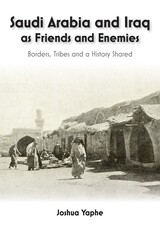 Saudi Arabia and Iraq as Friends and Enemies: Borders, Tribes and a Shared History
Joshua Yaphe
Sussex Academic Press, 2022 Saudi Arabia and Iraq have a shared history, as both friends and enemies at one and the same time, and their growth as modern nation-states must be understood in that joint context. This book establishes a new narrative and timeline for bilateral relations between the two countries, while examining the work of other Arab and Western scholars, in order to excavate the biases underlying so much previous work on this topic. In doing so, it proposes a new way of looking at state formation and boundaries in the Middle East, by showing how the interactions of regional neighbors left an indelible imprint on the domestic politics of one another.
The two different visions for managing the border that Saudi Arabia and Iraq developed in the 1920s generated mistrust on both sides, leading to a gradual process of estrangement that lasted through the 1950s and beyond. Ibn Saud made strenuous efforts to preserve the socio-economic ties that united the communities of southern Iraq with the Najd and, in turn, those efforts helped encourage a wave of Sunni Arab migrants from Iraq who helped build the Saudi state.
 Sa'udi Policies towards Migrants and Refugees: A Sacred Duty
Joseph A. Kéchichian
Sussex Academic Press, 2022 A Sacred Duty; sets out the Kingdom's policy toward the global issue of migrants and refugees, with special emphasis directed toward Muslim societies. Discussion focuses on refugee communities currently living in Sa'udi Arabia, some of which migrated due to war, forced displacement, environmental catastrophe, and economic hardship. Some migrants have come from bordering countries such as Iraq and Yemen; others reached the Arabian Peninsula from Africa and Asia. All have been welcomed and cared for, though settlement conditions, repatriation, and deportation circumstances were not always ideal. Inevitably, and mirroring experience elsewhere in the world, there are undeniable gulfs between policies and practices. Policy shortcomings are measured against the substantive assistance planks that Riyadh espouses, including providing financial aid to refugees in third countries, over and above United Nations' appeals. These acts are done without prejudice and mostly without publicity. Aid to the needy is justified by religious obligations, as well as on humanitarian grounds. Sa'udi Arabia's aid contributions have generally been either overlooked or dismissed, and the religious foundations of their commitment to displaced populations has been negatively contrasted against human-rights based commitments espoused by Western states and institutions. Sa'udi Policies towards Migrants and Refugees; addresses these concerns, filling a key gap in the literature on a vital policy topic. The book refutes notions that the country discourages open research on sensitive topics and further dispels the prejudiced idea of a society closed to any kind of external influence. Sa'udi Arabia's granting of hospitality to refugees reinforces historic, tribal, and universal norms in contrast to misplaced notions of hostility toward Western standards, which in the case of migrants and refugees has seen the application of confused and alarming standards of behavior by a plethora of Western states.
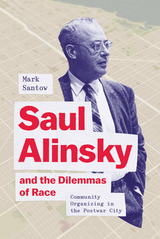 Saul Alinsky and the Dilemmas of Race: Community Organizing in the Postwar City
Mark Santow
University of Chicago Press, 2023 A groundbreaking examination of Saul Alinsky's organizing work as it relates to race.
Saul Alinsky is the most famous—even infamous—community organizer in American history. Almost single-handedly, he invented a new political form: community federations, which used the power of a neighborhood’s residents to define and fight for their own interests. Across a long and controversial career spanning more than three decades, Alinsky and his Industrial Areas Foundation organized Eastern European meatpackers in Chicago, Kansas City, Buffalo, and St. Paul; Mexican Americans in California and Arizona; white middle-class homeowners on the edge of Chicago’s South Side black ghetto; and African Americans in Rochester, Buffalo, Chicago, and other cities.
Mark Santow focuses on Alinsky’s attempts to grapple with the biggest moral dilemma of his age: race. As Santow shows, Alinsky was one of the few activists of the period to take on issues of race on paper and in the streets, on both sides of the color line, in the halls of power, and at the grassroots, in Chicago and in Washington, DC. Alinsky’s ideas, actions, and organizations thus provide us with a unique and comprehensive viewpoint on the politics of race, poverty, and social geography in the United States in the decades after World War II. Through Alinsky’s organizing and writing, we can see how the metropolitan color line was constructed, contested, and maintained—on the street, at the national level, and among white and black alike. In doing so, Santow offers new insight into an epochal figure and the society he worked to change.
 Saul Alinsky and the Dilemmas of Race: Community Organizing in the Postwar City
Mark Santow
University of Chicago Press, 2023 This is an auto-narrated audiobook edition of this book.
A groundbreaking examination of Saul Alinsky's organizing work as it relates to race.
Saul Alinsky is the most famous—even infamous—community organizer in American history. Almost single-handedly, he invented a new political form: community federations, which used the power of a neighborhood’s residents to define and fight for their own interests. Across a long and controversial career spanning more than three decades, Alinsky and his Industrial Areas Foundation organized Eastern European meatpackers in Chicago, Kansas City, Buffalo, and St. Paul; Mexican Americans in California and Arizona; white middle-class homeowners on the edge of Chicago’s South Side black ghetto; and African Americans in Rochester, Buffalo, Chicago, and other cities.
Mark Santow focuses on Alinsky’s attempts to grapple with the biggest moral dilemma of his age: race. As Santow shows, Alinsky was one of the few activists of the period to take on issues of race on paper and in the streets, on both sides of the color line, in the halls of power, and at the grassroots, in Chicago and in Washington, DC. Alinsky’s ideas, actions, and organizations thus provide us with a unique and comprehensive viewpoint on the politics of race, poverty, and social geography in the United States in the decades after World War II. Through Alinsky’s organizing and writing, we can see how the metropolitan color line was constructed, contested, and maintained—on the street, at the national level, and among white and black alike. In doing so, Santow offers new insight into an epochal figure and the society he worked to change.
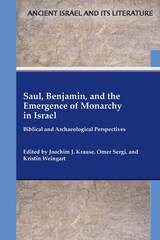 Saul, Benjamin, and the Emergence of Monarchy in Israel: Biblical and Archaeological Perspectives
Joachim J. Krause
SBL Press, 2020 Ponder questions of the united monarchy under Saul and David in light of current historical and archaeological evidence
Reconstructing the emergence of the Israelite monarchy involves interpreting historical research, approaching questions of ancient state formation, synthesizing archaeological research from sites in the southern Levant, and reexamining the biblical traditions of the early monarchy embedded in the books of Samuel and Kings. Integrating these approaches allows for a nuanced and differentiated picture of one of the most crucial periods in the history of ancient Israel. Rather than attempting to harmonize archaeological data and biblical texts or to supplement the respective approach by integrating only a portion of data stemming from the other, both perspectives come into their own in this volume presenting the results of an interdisciplinary Tübingen–Tel Aviv Research Colloquium.
Features:
- Essays on Israel's monarchy by experts in biblical archaeology and biblical studies
- Methods for integrating archaeology and biblical traditions in reconstructing ancient Israel's history
- New research on the sociopolitical process of state formation in Israel and Judah
Saul Lieberman and the Orthodox
Marc B. Shapiro
University of Scranton Press, 2006 One of the foremost scholars of the Talmud in the last century, Saul Lieberman (1898–1983) is also an intriguing and controversial figure. Highly influential in Orthodox society, he left Israel in 1940 to accept an appointment at the Jewish Theological Seminary, a Conservative institution. During his forty years at the Seminary, Lieberman served in the Rabbinical Assembly as one of the most important arbiters of Jewish law, though his decisions were often too progressive to be recognized by the Orthodox. Marc B. Shapiro here considers Lieberman’s experiences to examine the conflict between Jewish Orthodoxy and Conservatism in the mid-1900s. This invaluable scholarly resource also includes a Hebrew appendix and previously unpublished letters from Lieberman.
Saunakiya Caturadhyayika: A Pratisakhya of the Saunakiya Atharvaveda
Madhav M. Deshpande
Harvard University Press A detailed discussion by the editor complements this critical edition and translation of the phonetical treatise (Pratisakhya) of the Saunaka Samhita, one of two versions of the second oldest Indian text, the Saunaka Atharvaveda.
The 19th century edition of the text by W.D. Whitney has long been out of date; this reevaluation provides insights into early grammatical thought and helps to re-establish the textual tradition of the Atharvaveda. The book deals with the phonetically correct pronunciation of that text which has received only preliminary treatment thus far. It is also one of the few in its genre.
Savage Anomaly: The Power of Spinoza’s Metaphysics and Politics
Antonio Negri
University of Minnesota Press, 1999 A fresh take on this critical philosopher. In this essential rereading of Spinoza’s (1632-1677) philosophical and political writings, Negri positions this thinker within the historical context of the development of the modern state and its attendant political economy. Through a close examination of Spinoza, Negri reveals him as unique among his contemporaries for his nondialectical approach to social organization in a bourgeois age.
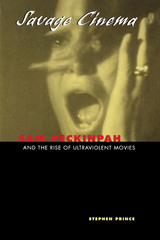 Savage Cinema: Sam Peckinpah and the Rise of Ultraviolent Movies
By Stephen Prince
University of Texas Press, 1998 More than any other filmmaker, Sam Peckinpah opened the door for graphic violence in movies. In this book, Stephen Prince explains the rise of explicit violence in the American cinema, its social effects, and the relation of contemporary ultraviolence to the radical, humanistic filmmaking that Peckinpah practiced. Prince demonstrates Peckinpah's complex approach to screen violence and shows him as a serious artist whose work was tied to the social and political upheavals of the 1960s. He explains how the director's commitment to showing the horror and pain of violence compelled him to use a complex style that aimed to control the viewer's response. Prince offers an unprecedented portrait of Peckinpah the filmmaker. Drawing on primary research materials—Peckinpah's unpublished correspondence, scripts, production memos, and editing notes—he provides a wealth of new information about the making of the films and Peckinpah's critical shaping of their content and violent imagery. This material shows Peckinpah as a filmmaker of intelligence, a keen observer of American society, and a tragic artist disturbed by the images he created. Prince's account establishes, for the first time, Peckinpah's place as a major filmmaker. This book is essential reading for those interested in Peckinpah, the problem of movie violence, and contemporary American cinema.
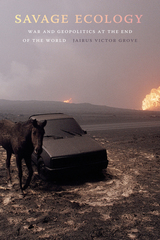 Savage Ecology: War and Geopolitics at the End of the World
Jairus Victor Grove
Duke University Press, 2019 Jairus Victor Grove contends that we live in a world made by war. In Savage Ecology he offers an ecological theory of geopolitics that argues that contemporary global crises are better understood when considered within the larger history of international politics. Infusing international relations with the theoretical interventions of fields ranging from new materialism to political theory, Grove shows how political violence is the principal force behind climate change, mass extinction, slavery, genocide, extractive capitalism, and other catastrophes. Grove analyzes a variety of subjects—from improvised explosive devices and drones to artificial intelligence and brain science—to outline how geopolitics is the violent pursuit of a way of living that comes at the expense of others. Pointing out that much of the damage being done to the earth and its inhabitants stems from colonialism, Grove suggests that the Anthropocene may be better described by the term Eurocene. The key to changing the planet's trajectory, Grove proposes, begins by acknowledging both the earth-shaping force of geopolitical violence and the demands apocalypses make for fashioning new ways of living.
 Savage Economy: The Returns of Middle English Romance
Walter Wadiak
University of Notre Dame Press, 2016 In Savage Economy: The Returns of Middle English Romance, Walter Wadiak traces the evolution of the medieval English romance from its thirteenth-century origins to 1500, and from a genre that affirmed aristocratic identity to one that appealed more broadly to an array of late medieval communities. Essential to this literary evolution is the concept and practice of “noble” gift-giving, which binds together knights and commoners in ways that both echo and displace the notorious violence of many of these stories.
Wadiak begins with the assumption that “romance” names a particular kind of chivalric fantasy to which violence is central, just as violence was instrumental to the formation and identity of the medieval warrior aristocracy. A traditional view is that the violence of romance stories is an expression of aristocratic privilege wielded by a military caste in its relations with one another as well as with those lower on the social scale. In this sense, violence is the aristocratic gift that underwrites and reaffirms the feudal power of a privileged group, with the noble gift performing the symbolic violence on which romance depends in order to present itself as both a coded threat and an expression of chivalric values. Well-known examples of romance in Middle English, such as Sir Gawain and the Green Knight and Chaucer’s Knight’s Tale, are considered alongside more “popular” examples of the genre to demonstrate a surprising continuity of function across a range of social contexts. Wadiak charts a trajectory from violence aimed directly at securing feudal domination to the subtler and more diffuse modes of coercion that later English romances explore. Ultimately, this is a book about the ways in which romance lives on as an idea, even as the genre itself begins to lose ground at the close of the Middle Ages.
"With his Savage Economy: The Returns of Middle English Romance, Walter Wadiak delivers a dynamically written and intellectually sparkling study of medieval romance. Treating his materials with deftness, acuity, and theoretical sophistication, he engages the medieval texts with penetrating uses of theory in a way that will stimulate a number of important advances in work on medieval 'romance' and 'ballad' and, no doubt, medieval literature generally." --Andrew Galloway, Cornell University
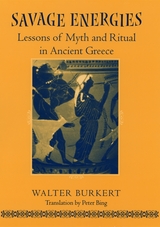 Savage Energies: Lessons of Myth and Ritual in Ancient Greece
Walter Burkert
University of Chicago Press, 2001 We often think of classical Greek society as a model of rationality and order. Yet as Walter Burkert demonstrates in these influential essays on the history of Greek religion, there were archaic, savage forces surging beneath the outwardly calm face of classical Greece, whose potentially violent and destructive energies, Burkert argues, were harnessed to constructive ends through the interlinked uses of myth and ritual.
For example, in a much-cited essay on the Athenian religious festival of the Arrephoria, Burkert uncovers deep connections between this strange nocturnal ritual, in which two virgin girls carried sacred offerings into a cave and later returned with something given to them there, and tribal puberty initiations by linking the festival with the myth of the daughters of Kekrops. Other chapters explore the origins of tragedy in blood sacrifice; the role of myth in the ritual of the new fire on Lemnos; the ties between violence, the Athenian courts, and the annual purification of the divine image; and how failed political propaganda entered the realm of myth at the time of the Persian Wars.
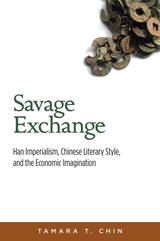 Savage Exchange: Han Imperialism, Chinese Literary Style, and the Economic Imagination
Tamara T. Chin
Harvard University Press, 2014 Savage Exchange explores the politics of representation during the Han dynasty (206 BCE–220 CE) at a pivotal moment when China was asserting imperialist power on the Eurasian continent and expanding its local and long-distance (“Silk Road”) markets. Tamara T. Chin explains why rival political groups introduced new literary forms with which to represent these expanded markets. To promote a radically quantitative approach to the market, some thinkers developed innovative forms of fiction and genre. In opposition, traditionalists reasserted the authority of classical texts and advocated a return to the historical, ethics-centered, marriage-based, agricultural economy that these texts described. The discussion of frontiers and markets thus became part of a larger debate over the relationship between the world and the written word. These Han debates helped to shape the ways in which we now define and appreciate early Chinese literature and produced the foundational texts of Chinese economic thought. Each chapter in the book examines a key genre or symbolic practice (philosophy, fu-rhapsody, historiography, money, kinship) through which different groups sought to reshape the political economy. By juxtaposing well-known texts with recently excavated literary and visual materials, Chin elaborates a new literary and cultural approach to Chinese economic thought.
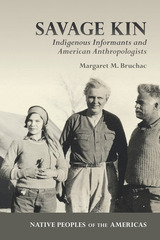 Savage Kin: Indigenous Informants and American Anthropologists
Margaret M. Bruchac
University of Arizona Press, 2018 In this provocative new book, Margaret M. Bruchac, an Indigenous anthropologist, turns the word savage on its head. Savage Kin explores the nature of the relationships between Indigenous informants, such as Gladys Tantaquidgeon (Mohegan), Jesse Cornplanter (Seneca), and George Hunt (Tlingit), and early twentieth-century anthropological collectors, such as Frank Speck, Arthur C. Parker, William N. Fenton, and Franz Boas.
This book reconceptualizes the intimate details of encounters with Native interlocutors who by turns inspired, facilitated, and resisted the anthropological enterprise. Like other texts focused on this era, Savage Kin features some of the elite white men credited with salvaging material that might otherwise have been lost. Unlike other texts, this book highlights the intellectual contributions and cultural strategies of unsung Indigenous informants without whom this research could never have taken place.
These bicultural partnerships transgressed social divides and blurred the roles of anthropologist/informant, relative/stranger, and collector/collected. Yet these stories were obscured by collecting practices that separated people from objects, objects from communities, and communities from stories. Bruchac’s decolonizing efforts include “reverse ethnography”—painstakingly tracking seemingly unidentifiable objects, misconstrued social relations, unpublished correspondence, and unattributed field notes—to recover this evidence. Those early encounters generated foundational knowledges that still affect Indigenous communities today.
Savage Kin also contains unexpected narratives of human and other-than-human encounters—brilliant discoveries, lessons from ancestral spirits, prophetic warnings, powerful gifts, and personal tragedies—that will move Native and non-Native readers alike.
 The Savage Library of Roberto Bolaño: Radical Readings
Benjamin Loy
Bucknell University Press, 2026 Visionary Chilean writer Roberto Bolaño was known for his darkly poetic prose and postmodern narratives, exemplified in his novel The Savage Detectives. His work is also deeply infused with references to the Western literary canon—from French and Spanish baroque texts to American and German modernism, as well as postmodern literature from Latin America and France. Taking Bolaño’s notion of “savage” reading as a point of departure, this study explores the key authors and literary traditions that underpin his oeuvre. Blending close textual analysis with insights from the history of literature and ideas, Loy offers fresh perspectives on some of Bolaño’s most significant works, including Distant Star, By Night in Chile, and 2666. The intertextual dialogues Loy traces—with figures such as Blaise Pascal, Sor Juana Inés de la Cruz, Charles Baudelaire, William Carlos Williams, Ernst Jünger, Nicanor Parra, and Georges Perec—illuminate the aesthetic universe of an author now regarded as a central figure in twenty-first-century world literature. Published by Bucknell University Press. Distributed worldwide by Rutgers University Press.
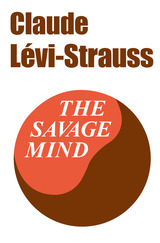 The Savage Mind
Claude Lévi-Strauss
University of Chicago Press, 1968 "Every word, like a sacred object, has its place. No précis is possible. This extraordinary book must be read."—Edmund Carpenter, New York Times Book Review
"No outline is possible; I can only say that reading this book is a most exciting intellectual exercise in which dialectic, wit, and imagination combine to stimulate and provoke at every page."—Edmund Leach, Man
"Lévi-Strauss's books are tough: very scholarly, very dense, very rapid in argument. But once you have mastered him, human history can never be the same, nor indeed can one's view of contemporary society. And his latest book, The Savage Mind, is his most comprehensive and certainly his most profound. Everyone interested in the history of ideas must read it; everyone interested in human institutions should read it."—J. H. Plumb, Saturday Review
"A constantly stimulating, informative and suggestive intellectual challenge."—Geoffrey Gorer, The Observer, London
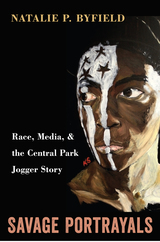 Savage Portrayals: Race, Media and the Central Park Jogger Story
Natalie Byfield
Temple University Press, 2014 In 1989, the rape and beating of a white female jogger in Central Park made international headlines. Many accounts reported the incident as an example of “wilding”—episodes of poor, minority youths roaming the streets looking for trouble. Police intent on immediate justice for the victim coerced five African-American and Latino boys to plead guilty. The teenage boys were quickly convicted and imprisoned. Natalie Byfield, who covered the case for the New York Daily News, now revisits the story of the Central Park Five from her perspective as a black female reporter in Savage Portrayals. Byfield illuminates the race, class, and gender bias in the massive media coverage of the crime and the prosecution of the now-exonerated defendants. Her sociological analysis and first-person account persuasively argue that the racialized reportage of the case buttressed efforts to try juveniles as adults across the nation. Savage Portrayals casts new light on this famous crime and its far-reaching consequences for the wrongly accused and the justice system.
 Savage Theory: Cinema as Modern Magic
Rachel O. Moore
Duke University Press, 2000 Savage Theory articulates the powerful mythology of cinema as the premier medium for magic in modern times. Envisioning the cinema as a form of magical ritual that possesses the power to enliven, heal, and enchant, Rachel O. Moore explores modernity’s relationship to the primitive by analyzing understandings of primitive belief and ritual in early film theory alongside illustrative scenes from popular as well as avant-garde film.
Moore mines the theories of language, spectatorship, and cinematic expression in the writings of Vachel Lindsay, Sergei Eisenstein, Siegfried Kracauer, and Walter Benjamin, among others. Illuminating the links between these theorists’ preoccupations with cinema as a form of primal communication and the numbing effects of modernity, she demonstrates how movies are uniquely able to negotiate the fragmentary and isolating nature of a modern world. In constructing an alternative to cognitive, psychoanalytic, and ideological approaches to film analysis, Moore provides eye-opening discussions of films such as Kenneth Anger’s Scorpio Rising, Hollis Frampton’s Nostalgia, and Robert Bresson’s l’Argent. Drawing from Marx’s theory of the commodity and Lukács’s work on second nature, she outlines the fetish character of the film image and reveals the emergence of the camera as a magical tool replete with animistic powers otherwise lost in the storm of progress.
Bound to influence the way future scholars think about the connection between modernism and primitivism, as well as the role of cinema therein during the early twentieth century, Savage Theory will be welcomed by scholars of film theory and anthropology and will also appeal to a wider cultural studies audience.
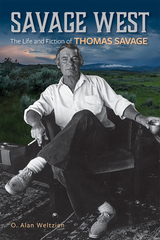 Savage West: The Life and Fiction of Thomas Savage
O. Alan Weltzien
University of Nevada Press, 2022 Thomas Savage (1915—2003) was one of the intermountain West's best novelists. His thirteen novels received high critical praise, yet he remained largely unknown by readers. Although Savage spent much of his later life in the Northeast, his formative years were spent in southwestern Montana, where the mountain West and his ranching family formed the setting for much of his work.
O. Alan Weltzien's insightful and detailed literary biography chronicles the life and work of this neglected but deeply talented novelist. Savage, a closeted gay family man, was both an outsider and an insider, navigating an intense conflict between his sexual identity and the claustrophobic social restraints of the rural West. Unlike many other Western writers, Savage avoided the formula westerns— so popular in his time— and offered instead a realistic, often subversive version of the region. His novels tell a hard, harsh story about dysfunctional families, loneliness, and stifling provincialism in the small towns and ranches of the northern Rockies, and his minority interpretation of the West provides a unique vision and caustic counternarrative contrary to the triumphant settler-colonialism themes that have shaped most Western literature. Savage West seeks to claim Thomas Savage's well-deserved position in American literature and to reintroduce twenty-first-century readers to a major Montana writer.
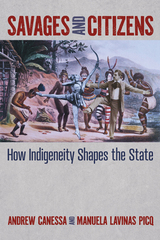 Savages and Citizens: How Indigeneity Shapes the State
Andrew Canessa and Manuela Lavinas Picq; Foreword by Jeff Ganohalidoh Corntassel
University of Arizona Press, 2024 Although Indigenous peoples are often perceived as standing outside political modernity, Savages and Citizens takes the provocative view that Indigenous people have been fundamental to how contemporary state sovereignty was imagined, theorized, and practiced.
Delving into European political philosophy, comparative politics, and contemporary international law, the book shows how the concept of indigeneity has shaped the development of the modern state. The exclusion of Indigenous people was not a collateral byproduct; it was a political project in its own right. The book argues that indigeneity is a political identity relational to modern nation-states and that Indigenous politics, although marking the boundary of the state, are co-constitutive of colonial processes of state-making. In showing how indigeneity is central to how the international system of states operates, the book forefronts Indigenous peoples as political actors to reject essentializing views that reduce them to cultural “survivors” rooted in the past.
With insights drawn from diverse global contexts and empirical research from Bolivia and Ecuador, this work advocates for the relevance of Indigenous studies within political science and argues for an ethnography of sovereignty in anthropology. Savages and Citizens makes a compelling case for the centrality of Indigenous perspectives to understand the modern state from political theory to international studies.
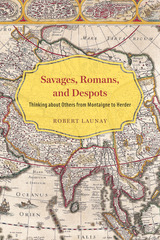 Savages, Romans, and Despots: Thinking about Others from Montaigne to Herder
Robert Launay
University of Chicago Press, 2018 From the sixteenth to the eighteenth centuries, Europeans struggled to understand their identity in the same way we do as individuals: by comparing themselves to others. In Savages, Romans, and Despots, Robert Launay takes us on a fascinating tour of early modern and modern history in an attempt to untangle how various depictions of “foreign” cultures and civilizations saturated debates about religion, morality, politics, and art.
Beginning with Mandeville and Montaigne, and working through Montesquieu, Diderot, Gibbon, Herder, and others, Launay traces how Europeans both admired and disdained unfamiliar societies in their attempts to work through the inner conflicts of their own social worlds. Some of these writers drew caricatures of “savages,” “Oriental despots,” and “ancient” Greeks and Romans. Others earnestly attempted to understand them. But, throughout this history, comparative thinking opened a space for critical reflection. At its worst, such space could give rise to a sense of European superiority. At its best, however, it could prompt awareness of the value of other ways of being in the world. Launay’s masterful survey of some of the Western tradition’s finest minds offers a keen exploration of the genesis of the notion of “civilization,” as well as an engaging portrait of the promises and perils of cross-cultural comparison.
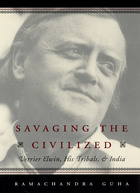 Savaging the Civilized: Verrier Elwin, His Tribals, and India
Ramachandra Guha
University of Chicago Press, 1999 Verrier Elwin (1902-1964) was unquestionably the most colorful and influential non-official Englishman to live and work in twentieth-century India. A prolific writer, Elwin's ethnographic studies and popular works on India's tribal customs, art, myth and folklore continue to generate controversy.
Described by his contemporaries as a cross between Albert Schweitzer and Paul Gauguin, Elwin was a man of contradictions, at times taking on the role of evangelist, social worker, political activist, poet, government worker, and more. He rubbed elbows with the elite of both Britain and India, yet found himself equally at home among the impoverished and destitute. Intensely political, the Oxford-trained scholar tirelessly defended the rights of the indigenous and, despite the deep religious influences of St. Francis and Mahatma Gandhi on his early career, staunchly opposed Hindu and Christian puritans in the debate over the future of India's tribals. Although he was ordained as an Anglican priest, Elwin was married twice to tribal women and enthusiastically (and publicly) extolled the tribals' practice of free sex. Later, as prime minister Nehru's friend and advisor in independent India, his compelling defense of tribal hedonism made him at once hugely influential, extremely controversial, and the polemical focal point of heated discussions on tribal policy and economic development.
Savaging the Civilized is both biography and history, an exploration through Elwin's life of some of the great debates of the twentieth century: the future of development, cultural assimilation versus cultural difference, the political practice of postcolonial as opposed to colonial governments, and the moral practice of writers and intellectuals.
The Savannah River Chiefdoms: Political Change in the Late Prehistoric Southeast
David G. Anderson
University of Alabama Press, 1994 This volume explores political change in chiefdoms, specifically how complex chiefdoms emerge and collapse, and how this process—called cycling—can be examined using archaeological, ethnohistoric, paleoclimatic, paleosubsistence, and physical anthropological data. The focus for the research is the prehistoric and initial contact-era Mississippian chiefdoms of the Southeastern United States, specifically the societies occupying the Savannah River basin from ca. A.D. 1000 to 1600. This regional focus and the multidisciplinary nature of the investigation provide a solid introduction to the Southeastern Mississippian archaeological record and the study of cultural evolution in general.
 Save Venice Inc.: American Philanthropy and Art Conservation in Italy, 1966-2021
Christopher Carlsmith
University of Massachusetts Press, 2022 In 1966, the most destructive flood in the history of Venice temporarily submerged the city and threatened its extraordinary art and architecture. Among the organizations that mobilized to protect this fragile heritage was Save Venice Inc. Founded in Boston and now headquartered in New York City, this nonprofit has become the largest and most active committee dedicated to preserving the artistic legacy of Venice. Christopher Carlsmith tells the fascinating story of Save Venice Inc., from its origins to its fiftieth anniversary. It continues to provide an influential model for philanthropy in the cultural sector, raising substantial funds to conserve and restore paintings, sculptures, books, mosaics, and entire buildings at risk from human and environmental impacts. Employing extensive archival research, oral interviews, and newspaper accounts, Save Venice Inc. explores a range of topics, including leadership, conservation projects, fundraising, and educational outreach. Using a range of methodologies from cultural history and art history, Carlsmith traces the achievements and challenges faced by this and other historic preservation organizations and by this unique city on the sea.
Save Yourself If You Can: Six Plays
Thomas Bernhard
Seagull Books, 2023 A collection of six Bernhard plays, all in English for the first time.
Save Yourself if You Can is a collection of six plays that span the entirety of Thomas Bernhard’s career as a dramatist. The plays collected in this long-awaited addition to Bernhard’s oeuvre in English—The Ignoramus and the Madman, The Celebrities, Immanuel Kant, The Goal Attained, Simply Complicated, and Elizabeth II—traverse somber lyricism and misanthropy to biting satire and glorious slapstick. They explore themes that will be familiar to longtime readers of Bernhardt, but here they are presented in a subtly different register, attuned to the needs of the stage.
 Saved for a Purpose: A Journey from Private Virtues to Public Values
James A. Joseph
Duke University Press, 2015 The son of a minister, James A. Joseph grew up in Louisiana’s Cajun country, where his parents taught him the value of education and the importance of serving others. These lessons inspired him to follow a career path that came to include working in senior executive or advisory positions for four U. S. Presidents and with the legendary Nelson Mandela to build a new democracy in South Africa. Saved for a Purpose is Joseph’s ethical autobiography, in which he shares his moral philosophy and his insights on leadership.
In an engaging and personal style, Joseph shows how his commitment to applying moral and ethical principles to large groups and institutions played out in his work in the civil rights movement in Alabama and as a college chaplain in California in the turbulent 1960s. His time later as vice president of the Cummins Engine Company provided an opportunity to promote corporate ethics, and his tenure as Under Secretary of the Interior in the Carter Administration underscored the difficulty and weight of making the right decisions while balancing good policy analysis with transcendent moral principles.
In 1996 President Clinton selected Joseph to become the United States Ambassador to South Africa. His recollections of working with Nelson Mandela, whom he describes as a noble and practical politician, and his observations about what he learned from Desmond Tutu and others about reconciliation contain some of the book’s most poignant passages.
Saved for a Purpose is unique, as Joseph combines his insights from working to integrate values into America’s public and private sectors with his long engagement with ethics as an academic discipline and as a practical guide for social behavior. Ultimately, it reflects Joseph’s passionate search for values that go beyond the personal to include the ethical imperatives that should be applied to the communal.
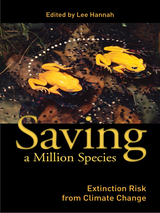 Saving a Million Species: Extinction Risk from Climate Change
Edited by Lee Hannah
Island Press, 2010 The research paper "Extinction Risk from Climate Change" published in the journal Nature in January 2004 created front-page headlines around the world. The notion that climate change could drive more than a million species to extinction captured both the popular imagination and the attention of policy-makers, and provoked an unprecedented round of scientific critique.
Saving a Million Species reconsiders the central question of that paper: How many species may perish as a result of climate change and associated threats? Leaders from a range of disciplines synthesize the literature, refine the original estimates, and elaborate the conservation and policy implications.
The book: - examines the initial extinction risk estimates of the original paper, subsequent critiques, and the media and policy impact of this unique study
- presents evidence of extinctions from climate change from different time frames in the past
- explores extinctions documented in the contemporary record
- sets forth new risk estimates for future climate change
- considers the conservation and policy implications of the estimates.
Saving a Million Species offers a clear explanation of the science behind the headline-grabbing estimates for conservationists, researchers, teachers, students, and policy-makers. It is a critical resource for helping those working to conserve biodiversity take on the rapidly advancing and evolving global stressor of climate change-the most important issue in conservation biology today, and the one for which we are least prepared.
Saving All the Parts: Reconciling Economics And The Endangered Species Act
Rocky Barker
Island Press, 1993 Saving All the Parts is a journalist's exploration of the intertwining of endangered species protection and the economic future of resource dependent communities -- those with local economies based on fishing, logging, ranching, mining, and other resource intensive industries. Rocky Barker presents an insightful overview of current endangered species controversies and a comprehensive look at the wide-ranging implications of human activities. The book analyzes trends in natural resource management, land use planning, and economic development that can lead to a future where economic activity can be sustained without the loss of essential natural values. Throughout, Barker provides a thorough and balanced analysis of both the ecological and economic forces that affect the lives and livelihoods of the nation's inhabitants -- both human and animal.
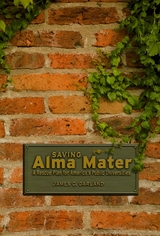 Saving Alma Mater: A Rescue Plan for America's Public Universities
James C. Garland
University of Chicago Press, 2009 America’s public universities educate 80% of our nation’s college students. But in the wake of rising demands on state treasuries, changing demographics, growing income inequality, and legislative indifference, many of these institutions have fallen into decline. Tuition costs have skyrocketed, class sizes have gone up, the number of courses offered has gone down, and the overall quality of education has decreased significantly. Here James C. Garland draws on more than thirty years of experience as a professor, administrator, and university president to argue that a new compact between state government and public universities is needed to make these schools more affordable and financially secure. Saving Alma Mater challenges a change-resistant culture in academia that places too low a premium on efficiency and productivity. Seeing a crisis of campus leadership, Garland takes state legislators to task for perpetuating the decay of their public university systems and calls for reforms in the way university presidents and governing boards are selected. He concludes that the era is long past when state appropriations can enable public universities to keep their fees low and affordable. Saving Alma Mater thus calls for the partial deregulation of public universities and a phase-out of their state appropriations. Garland’s plan would tie university revenues to their performance and exploit the competitive pressures of the academic marketplace to control costs, rein in tuition, and make schools more responsive to student needs. A much-needed blueprint for reform based on Garland’s real-life successes as the head of Miami University of Ohio, Saving Alma Mater will be essential for anyone concerned with the costs and quality of higher education in America today.
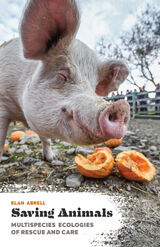 Saving Animals: Multispecies Ecologies of Rescue and Care
Elan Abrell
University of Minnesota Press, 2021 A fascinating and unprecedented ethnography of animal sanctuaries in the United States
In the past three decades, animal rights advocates have established everything from elephant sanctuaries in Africa to shelters that rehabilitate animals used in medical testing, to homes for farmed animals, abandoned pets, and entertainment animals that have outlived their “usefulness.” Saving Animals is the first major ethnography to focus on the ethical issues animating the establishment of such places, where animals who have been mistreated or destined for slaughter are allowed to live out their lives simply being animals. Based on fieldwork at animal rescue facilities across the United States, Elan Abrell asks what “saving,” “caring for,” and “sanctuary” actually mean. He considers sanctuaries as laboratories where caregivers conceive and implement new models of caring for and relating to animals. He explores the ethical decision making around sanctuary efforts to unmake property-based human–animal relations by creating spaces in which humans interact with animals as autonomous subjects. Saving Animals illustrates how caregivers and animals respond by cocreating new human–animal ecologies adapted to the material and social conditions of the Anthropocene. Bridging anthropology with animal studies and political philosophy, Saving Animals asks us to imagine less harmful modes of existence in a troubled world where both animals and humans seek sanctuary.
 Saving Babies?: The Consequences of Newborn Genetic Screening
Stefan Timmermans and Mara Buchbinder
University of Chicago Press, 2012 It has been close to six decades since Watson and Crick discovered the structure of DNA and more than ten years since the human genome was decoded. Today, through the collection and analysis of a small blood sample, every baby born in the United States is screened for more than fifty genetic disorders. Though the early detection of these abnormalities can potentially save lives, the test also has a high percentage of false positives—inaccurate results that can take a brutal emotional toll on parents before they are corrected. Now some doctors are questioning whether the benefits of these screenings outweigh the stress and pain they sometimes produce. In Saving Babies?, Stefan Timmermans and Mara Buchbinder evaluate the consequences and benefits of state-mandated newborn screening—and the larger policy questions they raise about the inherent inequalities in American medical care that limit the effectiveness of this potentially lifesaving technology. Drawing on observations and interviews with families, doctors, and policy actors, Timmermans and Buchbinder have given us the first ethnographic study of how parents and geneticists resolve the many uncertainties in screening newborns. Ideal for scholars of medicine, public health, and public policy, this book is destined to become a classic in its field.
 Saving Buddhism: The Impermanence of Religion in Colonial Burma
Alicia Turner
University of Hawaii Press, 2014 Saving Buddhism explores the dissonance between the goals of the colonial state and the Buddhist worldview that animated Burmese Buddhism at the turn of the twentieth century. For many Burmese, the salient and ordering discourse was not nation or modernity but sāsana, the life of the Buddha’s teachings. Burmese Buddhists interpreted the political and social changes between 1890 and 1920 as signs that the Buddha’s sāsana was deteriorating. This fear of decline drove waves of activity and organizing to prevent the loss of the Buddha’s teachings. Burmese set out to save Buddhism, but achieved much more: they took advantage of the indeterminacy of the moment to challenge the colonial frameworks that were beginning to shape their world.
Author Alicia Turner has examined thousands of rarely used sources-- newspapers and Buddhist journals, donation lists, and colonial reports—to trace three discourses set in motion by the colonial encounter: the evolving understanding of sāsana as an orienting framework for change, the adaptive modes of identity made possible in the moral community, and the ongoing definition of religion as a site of conflict and negotiation of autonomy. Beginning from an understanding that defining and redefining the boundaries of religion operated as a key technique of colonial power—shaping subjects through European categories and authorizing projects of colonial governmentality—she explores how Burmese Buddhists became actively engaged in defining and inflecting religion to shape their colonial situation and forward their own local projects.
Saving Buddhism intervenes not just in scholarly conversations about religion and colonialism, but in theoretical work in religious studies on the categories of “religion” and “secular.” It contributes to ongoing studies of colonialism, nation, and identity in Southeast Asian studies by working to denaturalize nationalist histories. It also engages conversations on millennialism and the construction of identity in Buddhist studies by tracing the fluid nature of sāsana as a discourse. The layers of Buddhist history that emerge challenge us to see multiple modes of identity in colonial modernity and offer insights into the instabilities of categories we too often take for granted.
 Saving Face: The Emotional Costs of the Asian Immigrant Family Myth
Angie Y. Chung
Rutgers University Press, 2016 Tiger Mom. Asian patriarchy. Model minority children. Generation gap. The many images used to describe the prototypical Asian family have given rise to two versions of the Asian immigrant family myth. The first celebrates Asian families for upholding the traditional heteronormative ideal of the “normal (white) American family” based on a hard-working male breadwinner and a devoted wife and mother who raises obedient children. The other demonizes Asian families around these very same cultural values by highlighting the dangers of excessive parenting, oppressive hierarchies, and emotionless pragmatism in Asian cultures. Saving Face cuts through these myths, offering a more nuanced portrait of Asian immigrant families in a changing world as recalled by the people who lived them first-hand: the grown children of Chinese and Korean immigrants. Drawing on extensive interviews, sociologist Angie Y. Chung examines how these second-generation children negotiate the complex and conflicted feelings they have toward their family responsibilities and upbringing. Although they know little about their parents’ lives, she reveals how Korean and Chinese Americans assemble fragments of their childhood memories, kinship narratives, and racial myths to make sense of their family experiences. However, Chung also finds that these adaptive strategies come at a considerable social and psychological cost and do less to reconcile the social stresses that minority immigrant families endure today. Saving Face not only gives readers a new appreciation for the often painful generation gap between immigrants and their children, it also reveals the love, empathy, and communication strategies families use to help bridge those rifts.
 Saving Grand Canyon: Dams, Deals, and a Noble Myth
Byron E. Pearson
University of Nevada Press, 2019 2020 Winner of the Southwest Book Awards
2020 Spur Awards Finalist Contemporary Nonfiction, Western Writers of America
The Grand Canyon has been saved from dams three times in the last century. Unthinkable as it may seem today, many people promoted damming the Colorado River in the canyon during the early twentieth century as the most feasible solution to the water and power needs of the Pacific Southwest. These efforts reached their climax during the 1960s when the federal government tried to build two massive hydroelectric dams in the Grand Canyon. Although not located within the Grand Canyon National Park or Monument, they would have flooded lengthy, unprotected reaches of the canyon and along thirteen miles of the park boundary.
Saving Grand Canyon tells the remarkable true story of the attempts to build dams in one of America’s most spectacular natural wonders. Based on twenty-five years of research, this fascinating ride through history chronicles a hundred years of Colorado River water development, demonstrates how the National Environmental Policy Act came to be, and challenges the myth that the Sierra Club saved the Grand Canyon. It also shows how the Sierra Club parlayed public perception as the canyon’s savior into the leadership of the modern environmental movement after the National Environmental Policy Act became law.
The tale of the Sierra Club stopping the dams has become so entrenched—and so embellished—that many historians, popular writers, and filmmakers have ignored the documented historical record. This epic story puts the events from 1963–1968 into the broader context of Colorado River water development and debunks fifty years of Colorado River and Grand Canyon myths.
 Saving International Adoption: An Argument from Economics and Personal Experience
Mark Montgomery
Vanderbilt University Press, 2018 Choice Outstanding Academic Title of 2018
International adoption is in a state of virtual collapse, rates having fallen by more than half since 2004 and continuing to fall. Yet around the world millions of orphaned and vulnerable children need permanent homes, and thousands of American and European families are eager to take them in. Many government officials, international bureaucrats, and social commentators claim these adoptions are not "in the best interests" of the child. They claim that adoption deprives children of their "birth culture," threatens their racial identities, and even encourages widespread child trafficking. Celebrity adopters are publicly excoriated for stealing children from their birth families.
This book argues that opposition to adoption ostensibly based on the well-being of the child is often a smokescreen for protecting national pride. Concerns about the harm done by transracial adoption are largely inconsistent with empirical evidence. As for trafficking, opponents of international adoption want to shut it down because it is too much like a market for children. But this book offers a radical challenge to this view—that is, what if instead of trying to suppress market forces in international adoption, we embraced them so they could be properly regulated? What if the international system functioned more like open adoption in the United States, where birth and adoptive parents can meet and privately negotiate the exchange of parental rights? This arrangement, the authors argue, could eliminate the abuses that currently haunt international adoption.
The authors challenge the prevailing wisdom with their economic analyses and provocative analogies from other policy realms. Based on their own family's experience with the adoption process, they also write frankly about how that process feels for parents and children.
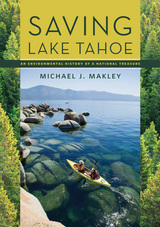 Saving Lake Tahoe: An Environmental History of a National Treasure
Michael J. Makley
University of Nevada Press, 2014 The history of Lake Tahoe begins with the Washoe Indians who resided on its shores for thousands of years, with minimal impact on the landscape. The relatively brief American history at Lake Tahoe began in the mid-nineteenth century. Though awestruck by its beauty, the new arrivals were also intent on harvesting its abundant resources. In a mere half century, the basin’s forests and fisheries were destroyed, the lake’s pristine clarity dramatically reduced.
Left alone, nature healed itself, and by the 1960s mature forests once again surrounded the lake and its water clarity improved, with visibility more than one hundred feet deep. However, Tahoe’s wonders brought a new kind of threat: millions of annual visitors and incessant development, including ski resorts and casinos. Saving Lake Tahoe looks at the interaction through the years between human activities and Tahoe’s natural ecosystems. It is a dramatic story of ecological disasters and near misses, political successes and failures. Utilizing primary sources and interviews with key figures, Makley provides a meticulously researched account of the battles surrounding the management of the Tahoe basin.
Makley takes the story up to the present, describing the formation and evolution of a new type of governing body, the bistate Tahoe Regional Planning Agency, and groundbreaking efforts to utilize science in establishing policy. He depicts the passionate fights between those who seek to preserve the environment and advocates of individual property rights. Although Tahoe remains unique in its splendor, readers will understand why, with continued pressure for development, reversing environmental deterioration and improving the lake water’s clarity remain elusive goals.
 The Saving Lie: Harold Bloom and Deconstruction
Agata Bielik-Robson
Northwestern University Press, 2011 Harold Bloom is our greatest living literary critic. His wide-ranging critical writings have plumbed the depths of Romanticism (The Visionary Company), explored the anxiety caused by the influence of one generation of poets on another (Agon, The Anxiety of Influence), wrestled with the idea of a literary canon (The Western Canon), introduced Jacques Derrida and deconstruction to America (Deconstruction and Criticism), and explored the relationship between religion, especially Judaism, and literature (Kabbalah and Criticism, The Book of J).
Bloom is indeed a party of one, a truly strong poet of his own mode of religious-literary criticism, who, in a typically Emersonian manner, makes his own circumstances and sheds influences by incorporating them into his idiosyncratic theory.In this unprecedented full-length study on Harold Bloom, Agata Bielik-Robson explores the many facets of Bloom’s critical writings and career. In his work, she argues, Bloom draws on a variety of disparate traditions—Judaism, gnosis, Romanticism, American pragmatism, and Freudianism, but also, especially recently, Victorian aestheticism—that comprise a dialectical, difficult whole in a constant quarrel with itself. Yet, this is precisely the image of "life-in-antithesis," which constitutes Bloom’s highest speculative achievement, she observes. The Saving Lie brings all these "Blooms" together and, despite their own tendencies toward dissociation, lets them speak unisono: in one almost harmonious voice that will clearly utter the principles of a new speculative position—Bloom’s antithetical vitalism. This study of Bloom and his contributions will not soon be surpassed.
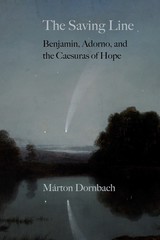 The Saving Line: Benjamin, Adorno, and the Caesuras of Hope
Márton Dornbach
Northwestern University Press, 2021 Walter Benjamin and Theodor Adorno both turned to canonical literary narratives to determine why the Enlightenment project was derailed and how this failure might be remedied. The resultant works, Benjamin’s major essay on Goethe’s Elective Affinities and Adorno’s meditation on the Odyssey in Dialectic of Enlightenment, are centrally concerned with the very act of narration. Márton Dornbach’s groundbreaking book reconstructs a hitherto unnoticed, wide-ranging dialogue between these foundational texts of the Frankfurt School. At the heart of Dornbach’s argument is a critical model that Benjamin built around the concept of caesura, a model Adorno subsequently reworked. Countering an obscurantism that would become complicit in the rise of fascism, the two theorists aligned moments of arrest in narratives mired in unreason. Although this model responded to a specific historical emergency, it can be adapted to identify utopian impulses in a variety of works. The Saving Line throws fresh light on the intellectual exchange and disagreements between Benjamin and Adorno, the problematic conjunction of secular reason and negative theology in their thinking, and their appropriations of ancient and modern legacies. It will interest scholars of philosophy and literature, critical theory, German Jewish thought, classical reception studies, and narratology.
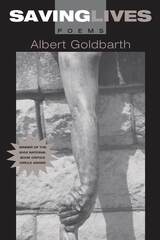 SAVING LIVES: POEMS
Albert Goldbarth
Ohio State University Press, 2001 Albert Goldbarth "just may be the American poet of his generation for the ages," says Judith Kitchen in a recent feature on him in the Georgia Review. "Often humorous but always serious, Goldbarth combines erudite research, pop-culture fanaticism, and personal anecdote in ways that make his writings among the most stylistically recognizable in the literary world." This new volume, Saving Lives, both consolidates and extends his passions and their presentations. The poems range from a few tight, resonant lines to works of long storytelling drive, from sequences that encompass the most flexible of free verse to an homage to the sestina. Some center on familiar cultural icons (Rembrandt, Houdini, Barnum, the Hardy Boys), others on little-known fringe players in subculture's oddest unlit corners, and yet others on family histories. But always they examine an essential subject: the ways we try to "save lives"—whether through a transplanted lung, the archeological remnant, the conserved book. As ever, Goldbarth dazzles, displaying an energetic mind eager to share his arcane learning, oddball musings, and observations of intimate moments, joys, and despairs. A zany wit and a generous sense of humanity reign equally. Saving Lives only enhances this writer's grand signature tradition.
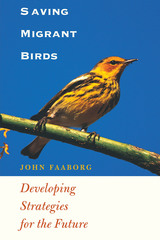 Saving Migrant Birds: Developing Strategies for the Future
By John Faaborg
University of Texas Press, 2002 In the 1980s, numerous scientific surveys documented both declining bird populations, especially among Neotropical songbirds that winter in the tropics, and the loss of tropical rain forest habitat. Drawing the seemingly obvious conclusion, scientists and environmental activists linked songbird declines to loss of tropical habitats and alerted the world to an impending ecological catastrophe. Their warnings led to the establishment of the Neotropical Migratory Bird Conservation Program, also known as Partners in Flight, the self-proclaimed largest conservation effort in history. Looking back over more than a decade of efforts to save migrant birds, John Faaborg offers the first serious evaluation of the state of songbird populations today, the effectiveness of conservation programs such as Partners in Flight, and the reliability and completeness of scientific research on migrant birds. Taking neither an alarmist nor a complacent approach, he shows that many factors besides habitat loss affect bird populations and that Neotropical migrants as a group are not declining dramatically, though some species adapt to habitat alteration more successfully than others. Faaborg's state-of-the-art survey thus clarifies the kinds of information we will need and the conservation efforts we should undertake to ensure the long-term survival of Neotropical migrant birds.
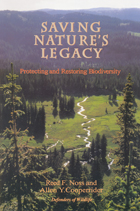 Saving Nature's Legacy: Protecting And Restoring Biodiversity
Reed F. Noss and Allen Y. Cooperrider; Foreword by Rodger Schlickeisen; Defenders of Wildlife
Island Press, 1994 Written by two leading conservation biologists, Saving Nature's Legacy is a thorough and readable introduction to issues of land management and conservation biology. It presents a broad, land-based approach to biodiversity conservation in the United States, with the authors succinctly translating principles, techniques, and findings of the ecological sciences into an accessible and practical plan for action. After laying the groundwork for biodiversity conservation -- what biodiversity is, why it is important, its status in North America -- Noss and Cooperrider consider the strengths and limitations of past and current approaches to land management. They then present the framework for a bold new strategy, with explicit guidelines on: - inventorying biodiversity
- selecting areas for protection
- designing regional and continental reserve networks
- establishing monitoring programs
- setting priorities for getting the job done
Throughout the volume, the authors provide in-depth assessments of what must be done to protect and restore the full spectrum of native biodiversity to the North American continent.
 Saving New Sounds: Podcast Preservation and Historiography
Jeremy Wade Morris and Eric Hoyt, editors
University of Michigan Press, 2021 Over seventy-five million Americans listen to podcasts every month, and the average weekly listener spends over six hours tuning into podcasts from the more than thirty million podcast episodes currently available. Yet despite the excitement over podcasting, the sounds of podcasting’s nascent history are vulnerable and they remain mystifyingly difficult to research and preserve. Podcast feeds end abruptly, cease to be maintained, or become housed in proprietary databases, which are difficult to search with any rigor. Podcasts might seem to be highly available everywhere, but it’s necessary to preserve and analyze these resources now, or scholars will find themselves writing, researching, and thinking about a past they can’t fully see or hear. This collection gathers the expertise of leading and emerging scholars in podcasting and digital audio in order to take stock of podcasting’s recent history and imagine future directions for the format. Essays trace some of the less amplified histories of the format and offer discussions of some of the hurdles podcasting faces nearly twenty years into its existence. Using their experiences building and using the PodcastRE database—one of the largest publicly accessible databases for searching and researching podcasts—the volume editors and contributors reflect on how they, as media historians and cultural researchers, can best preserve podcasting’s booming audio cultures and the countless voices and perspectives podcasting adds to our collective soundscape.
 Saving Orchids: Stories of Species Survival in a Changing World
Philip Seaton and Lawrence W. Zettler
University of Chicago Press, 2025 A gorgeously illustrated ode to the beauty and significance of orchids—and to those fighting to save these unique plants across the globe. Until recently, a myriad of lifeforms enriched our lives. In some places, listening to a nighttime chorus of frogs in the neighborhood marsh was an archetypal touchstone of childhood. Children would search for tadpoles, just steps away from native Lady’s Tresses orchids. Year by year, the chorus became quieter. Today, only a few frogs and orchids remain. Is this the world we want our children to inherit? Do we want orchids to slip through our fingers and, eventually, to vanish? For biologists Philip Seaton and Lawrence W. Zettler, and the intrepid orchid defenders they introduce in this book, the answer is no. Seaton and Zettler have traveled the world over the past three decades, studying orchids—flagship species for plant conservation. Stunningly illustrated, this book is a culmination of stories about the people—young and old alike—dedicated to protecting these remarkable plants from extinction. In the 19th century, collectors removed, shipped, and sold vast numbers of orchids from the wild. Today, scientists strive to reverse this harm—to protect and rebuild remnants of orchids’ original habitats against human disruption, including climate change. Seaton and Zettler reveal these plants’ bizarre pollination partners, risky liaisons with fungi, and adaptation to human domestication to show that learning orchids’ scientific secrets—and finding human helpers—is key to these plants’ survival.
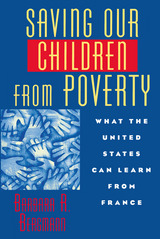 Saving Our Children From Poverty: What the United States Can Learn From France
Barbara R. Bergmann
Russell Sage Foundation, 1996 More than one in five American children live below the poverty line, a proportion that exceeds that of any other advanced nation. Although large numbers of Western European children live with single or unemployed parents, or belong to disadvantaged minorities, they are better shielded from severe deprivation by carefully designed public assistance programs. Saving Our Children from Poverty describes one of the most successful European systems of assistance for families, that of France, and through comparison with American programs offers a valuable guide to improving our own safety net for children and reforming our dysfunctional welfare system. Saving Our Children from Poverty details the array of benefits available to both high- and low-income families in France. Government-run nursery schools provide free, high-quality care for almost all children between the ages of three and six. Children also receive guaranteed medical care under a national health insurance plan. The French system offers married couples most of the same benefits as single parents, and creates strong incentives to seek and hold jobs rather than remain on welfare. A French single mother who chooses to work still receives substantial income supplements, housing assistance, subsidized health care, and access to public child care facilities. In stark contrast, her American counterpart loses most of her cash benefits if she takes a job and receives no government assistance with child care. Because American policies focus disproportionately on aiding the poorest non-working families, parents forced to rely on low-wage jobs are frequently left without the resources to provide their children with an adequate standard of living. As the public debate on welfare reform continues to rage, ever more American children fall into poverty. Why does the nation remain so unresponsive to their plight? Saving Our Children from Poverty probes the American aversion to national assistance programs, citing the negative attitudes that have seeped into the current political discourse. A lack of faith in the federal government's administrative abilities has bolstered a trend toward decentralization of programs, as well as a growing resistance to taxation. Racial antipathies and a belief that financial support encourages irresponsibility further undermine the development of programs for those in need. Saving Our Children from Poverty illustrates what a nation no wealthier than ours can realistically accomplish and afford, and concludes with a viable blueprint for successfully applying aspects of France's system to the United States.
 Saving Our Sturgeon: Protecting Wisconsin's Ancient Fish
Rebecca Hogue Wojahn
Wisconsin Historical Society Press, 2025 The story of a fascinating fish and the forward-thinking people who saved them in Wisconsin
For millennia, sturgeon swam the waterways of Wisconsin. Before the 1800s, an estimated eleven million sturgeon lived in Lake Michigan alone. Menominee and Ojibwe people depended on the fish for food and harvested them sustainably. But in the early 1900s, the lake sturgeon was near extinction. Saving Our Sturgeon tells the remarkable story of lake sturgeon in Wisconsin, the conservation efforts to save the species, and what is being done to keep the population healthy and thriving today. Readers will learn about the natural history of the lake sturgeon—its anatomy, behavior, and habitat—and the factors that threatened its survival, from overharvesting to the building of dams that prevented sturgeon from reaching spawning areas. The book, written for young readers aged eleven and up, explains how government agencies, conservationists, and citizen groups worked together to save the sturgeon population in Wisconsin. Saving Our Sturgeon includes a chapter about the Menominee Nation’s work to revitalize cultural traditions focused on the sturgeon and restore access to the fish on their reservation. The book also highlights how young people can get involved with sturgeon conservation efforts. A great resource for classroom use, Saving Our Sturgeon contains maps, photos, and diagrams, plus a glossary of terms, a timeline of events, a Who’s Who list of individuals and groups featured in the book, and a bibliography that highlights kid-friendly sources to learn more. Young readers will learn basic facts about sturgeon biology, what it means for a species to be threatened or endangered, and how scientists use data to support repopulation. This inspiring book shares a conservation success story about one remarkable (and plenty peculiar) species of fish and shows young readers how they, too, can help protect these incredible creatures. Ages 11 - 14; Grade level 6 - 9; Lexile® measure 1060L
 Saving Persuasion: A Defense of Rhetoric and Judgment
Bryan Garsten
Harvard University Press, 2009 In today's increasingly polarized political landscape it seems that fewer and fewer citizens hold out hope of persuading one another. Even among those who have not given up on persuasion, few will admit to practicing the art of persuasion known as rhetoric. To describe political speech as "rhetoric" today is to accuse it of being superficial or manipulative. In Saving Persuasion, Bryan Garsten uncovers the early modern origins of this suspicious attitude toward rhetoric and seeks to loosen its grip on contemporary political theory. Revealing how deeply concerns about rhetorical speech shaped both ancient and modern political thought, he argues that the artful practice of persuasion ought to be viewed as a crucial part of democratic politics. He provocatively suggests that the aspects of rhetoric that seem most dangerous--the appeals to emotion, religious values, and the concrete commitments and identities of particular communities--are also those which can draw out citizens' capacity for good judgment. Against theorists who advocate a rationalized ideal of deliberation aimed at consensus, Garsten argues that a controversial politics of partiality and passion can produce a more engaged and more deliberative kind of democratic discourse.
 The Saving Remnant: RELIGION AND THE SETTLING OF NEW ENGLAND
Cedric B. Cowing
University of Illinois Press, 1995 The great flight that brought colonists in the 1600s to what would become New England was a resettlement that had not only a geographical and spiritual impact, but an important historical impact as well. The influences of the settlers' English origins, and the fact that various religious groups inhabited specific areas of New England, strongly shaped American history through the 1800s and beyond.
Cedric Cowing demonstrates that there were two Englands, one evangelistic and one rationalistic. In the northwest of the British Isles was a society that was pastoral, westering, otherworldly, and revivalist--in the southeast was another, more established and mercantile. These two strains set the stage and powered the action for the biggest religious event of the eighteenth century--the Great Awakening.
The leaders of the New Light in the Great Awakening were the Saving Remnant, mostly ministers with liberal education who retained their evangelical and seeker religiosity. The clearly identifiable regional religious parallels between old England and New are still discernable today and give a new slant to heretofore unresolved historiographical issues. Cowing shows how regionalism influenced the nature of New England Puritanism and how the presence of a strong and persistent link between regional origins and religious behavior led to the inevitability of the Salem witch trials.
Saving San Francisco: Relief and Recovery after the 1906 Disaster
Andrea Rees Davies
Temple University Press, 2011 Combining the experiences of ordinary people with urban politics and history, Saving San Francisco challenges the long-lived myth that the 1906 disaster erased social differences as it leveled the city. Highlighting new evidence from San Francisco’s relief camps, Andrea Rees Davies shows that as policy makers directed various forms of aid to groups and projects that enjoyed high social status before the disaster, the widespread need and dislocation created opportunities for some groups to challenge biased relief policy. Poor and working-class refugees organized successful protests, while Chinatown business leaders and middle-class white women mobilized resources for the less privileged. Ultimately, however, the political and financial elite shaped relief and reconstruction efforts and cemented social differences in San Francisco.
 Saving Schools: From Horace Mann to Virtual Learning
Paul E. Peterson
Harvard University Press, 2011 Saving Schools traces the story of the rise, decline, and potential resurrection of American public schools through the lives and ideas of six mission-driven reformers: Horace Mann, John Dewey, Martin Luther King Jr., Albert Shanker, William Bennett, and James Coleman. Yet schools did not become the efficient, egalitarian, and high-quality educational institutions these reformers envisioned. Indeed, the unintended consequences of their legacies shaped today’s flawed educational system, in which political control of stagnant American schools has shifted away from families and communities to larger, more centralized entities—initially to bigger districts and eventually to control by states, courts, and the federal government.
Peterson’s tales help to explain how nation building, progressive education, the civil rights movement, unionization, legalization, special education, bilingual teaching, accountability, vouchers, charters, and homeschooling have, each in a different way, set the stage for a new era in American education.
Now, under the impact of rising cost, coupled with the possibilities unleashed by technological innovation, schooling may be transformed through virtual learning. The result could be a personalized, customized system of education in which families have greater choice and control over their children’s education than at any time since our nation was founded.
 Saving Seeds, Preserving Taste: Heirloom Seed Savers in Appalachia
Bill Best
Ohio University Press The Brown Goose, the White Case Knife, Ora’s Speckled Bean, Radiator Charlie’s Mortgage Lifter — these are just a few of the heirloom fruits and vegetables you’ll encounter in Bill Best’s remarkable history of seed saving and the people who preserve both unique flavors and the Appalachian culture associated with them. As one of the people at the forefront of seed saving and trading for over fifty years, Best has helped preserve numerous varieties of beans, tomatoes, corn, squashes, and other fruits and vegetables, along with the family stories and experiences that are a fundamental part of this world. While corporate agriculture privileges a few flavorless but hardy varieties of daily vegetables, seed savers have worked tirelessly to preserve genetic diversity and the flavors rooted in the Southern Appalachian Mountains — referred to by plant scientists as one of the vegetative wonders of the world.
Saving Seeds, Preserving Taste will introduce readers to the cultural traditions associated with seed saving, as well as the remarkable people who have used grafting practices and hand-by-hand trading to keep alive varieties that would otherwise have been lost. As local efforts to preserve heirloom seeds have become part of a growing national food movement, Appalachian seed savers play a crucial role in providing alternatives to large-scale agriculture and corporate food culture. Part flavor guide, part people’s history, Saving Seeds, Preserving Taste will introduce you to a world you’ve never known — or perhaps remind you of one you remember well from your childhood.
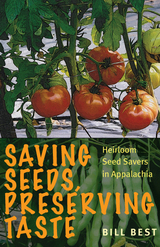 Saving Seeds, Preserving Taste: Heirloom Seed Savers in Appalachia
Bill Best
Ohio University Press, 2013 The Brown Goose, the White Case Knife, Ora’s Speckled Bean, Radiator Charlie’s Mortgage Lifter—these are just a few of the heirloom fruits and vegetables you’ll encounter in Bill Best’s remarkable history of seed saving and the people who preserve both unique flavors and the Appalachian culture associated with them. As one of the people at the forefront of seed saving and trading for over fifty years, Best has helped preserve numerous varieties of beans, tomatoes, corn, squashes, and other fruits and vegetables, along with the family stories and experiences that are a fundamental part of this world. While corporate agriculture privileges a few flavorless but hardy varieties of daily vegetables, seed savers have worked tirelessly to preserve genetic diversity and the flavors rooted in the Southern Appalachian Mountains—referred to by plant scientists as one of the vegetative wonders of the world. Saving Seeds, Preserving Taste will introduce readers to the cultural traditions associated with seed saving, as well as the remarkable people who have used grafting practices and hand-by-hand trading to keep alive varieties that would otherwise have been lost. As local efforts to preserve heirloom seeds have become part of a growing national food movement, Appalachian seed savers play a crucial role in providing alternatives to large-scale agriculture and corporate food culture. Part flavor guide, part people’s history, Saving Seeds, Preserving Taste will introduce you to a world you’ve never known—or perhaps remind you of one you remember well from your childhood.
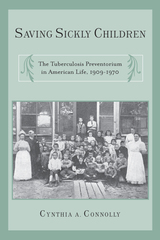 Saving Sickly Children: The Tuberculosis Preventorium in American Life, 1909-1970
Connolly, Cynthia A
Rutgers University Press, 2008 Known as "The Great Killer" and "The White Plague," few diseases influenced American life as much as tuberculosis. Sufferers migrated to mountain or desert climates believed to ameliorate symptoms. Architects designed homes with sleeping porches and verandas so sufferers could spend time in the open air. The disease even developed its own consumer culture complete with invalid beds, spittoons, sputum collection devices, and disinfectants. The "preventorium," an institution designed to protect children from the ravages of the disease, emerged in this era of Progressive ideals in public health.
In this book, Cynthia A. Connolly provides a provocative analysis of public health and family welfare through the lens of the tuberculosis preventorium. This unique facility was intended to prevent TB in indigent children from families labeled irresponsible or at risk for developing the disease. Yet, it also held deeply rooted assumptions about class, race, and ethnicity. Connolly goes further to explain how the child-saving themes embedded in the preventorium movement continue to shape children's health care delivery and family policy in the United States.
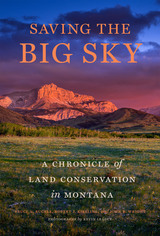 Saving the Big Sky: A Chronicle of Land Conservation in Montana
Bruce A. Bugbee
Oregon State University Press, 2025 “The essential purpose of Saving the Big Sky is to inspire the reader to help conserve even more of Montana,” write Bruce Bugbee, Robert Kiesling, and John Wright in this compelling study of how six million acres of biodiverse land were conserved in Montana over the past fifty years. Indigenous and non-Indigenous knowledge about land stewardship has evolved and since the 1970s tribes, nonprofit organizations, land trusts, and government agencies have conserved land in many creative ways. Beautifully illustrated with more than ninety color photographs and thirty detailed maps, Saving the Big Sky showcases land conservation achievements across eight regions of the state: the Rocky Mountain Front, the Blackfoot Valley, the Greater Yellowstone, the Missoula Region, the Helena Region, Northwest Montana, the Flathead Indian Reservation, and the American Prairie. Land protection is shown to work best when large, intact, connected landscapes can be conserved, rather than small, fragmented, isolated parcels. Conservationists have found that landowners in Montana more widely accept conservation easements and other voluntary, financially compensating tools that respect private property rights. The brilliant images and striking before-and-after maps featured here celebrate the ranches, farms, wildlife habitats, and scenic open spaces that are forever safeguarded. In documenting conservation accomplishments and suggesting what more can be done, Saving the Big Sky invites readers to participate in conserving Montana—or whatever cherished landscape they call home.
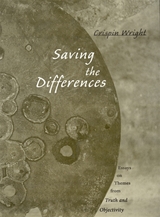 Saving the Differences: Essays on Themes from Truth and Objectivity
Crispin Wright
Harvard University Press, 2003 Crispin Wright's Truth and Objectivity brought about a far-reaching reorientation of the metaphysical debates concerning realism and truth. The essays in this companion volume prefigure, elaborate, or defend the proposals put forward in that landmark work.
The collection includes the Gareth Evans memorial lecture in which the program of Truth and Objectivity was first announced, as well as all of Wright's published reactions to the extensive commentary his study provoked; it presents substantial new developments and applications of the pluralistic outlook on the realism debates proposed in Truth and Objectivity, and further pursues its distinctive minimalist conceptions of truth and of truth-aptitude. Among the papers are important discussions of coherence conceptions of truth, of Hilary Putnam's most recent views on truth, and of the classical debate between correspondence, coherence, pragmatism, and deflationary conceptions of the notion. Others are concerned with Kripke's famous argument against physicalist conceptions of sensation; the distinction between minimal truth-aptitude and cognitive command; a novel prospectus for a philosophy of vagueness; and a new proposal about the most resilient interpretation of relativism.
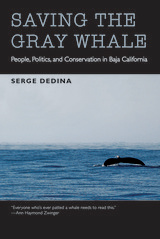 Saving the Gray Whale: People, Politics, and Conservation in Baja California
Serge Dedina
University of Arizona Press, 2000 Once hunted by whalers and now the darling of ecotourists, the gray whale has become part of the culture, history, politics, and geography of Mexico's most isolated region. After the harvesting of gray whales was banned by international law in 1946, their populations rebounded; but while they are no longer hunted for their oil, these creatures are now chased up and down the lagoons of southern Baja California by whalewatchers. This book uses the biology and politics associated with gray whales in Mexican waters to present an unusual case study in conservation and politics. It provides an inside look at how gray whale conservation decisions are made in Mexico City and examines how those policies and programs are carried out in the calving grounds of San Ignacio Lagoon and Magdalena Bay, where catering to ecotourists is now an integral part of the local economy.
More than a study of conservation politics, Dedina's book puts a human face on wildlife conservation. The author lived for two years with residents of Baja communities to understand their attitudes about wildlife conservation and Mexican politics, and he accompanied many in daily activities to show the extent to which the local economy depends on whalewatching. "It is ironic," observes Dedina, "that residents of some of the most isolated fishing villages in North America are helping to redefine our relationship with wild animals. Americans and Europeans brought the gray whale population to the brink of extinction. The inhabitants of San Ignacio Lagoon and Magdalena Bay are helping us to celebrate the whales' survival." By showing us how these animals have helped shape the lifeways of the people with whom they share the lagoons, Saving the Gray Whale demonstrates that gray whales represent both a destructive past and a future with hope.
 Saving the Media: Capitalism, Crowdfunding, and Democracy
Julia Cagé
Harvard University Press, 2016 The media are in crisis. Confronted by growing competition and sagging advertising revenue, news operations in print, on radio and TV, and even online are struggling to reinvent themselves. Many have gone under. For too many others, the answer has been to lay off reporters, join conglomerates, and lean more heavily on generic content. The result: in a world awash with information, news organizations provide citizens with less and less in-depth reporting and a narrowing range of viewpoints. If democracy requires an informed citizenry, this trend spells trouble.
Julia Cagé explains the economics and history of the media crisis in Europe and America, and she presents a bold solution. The answer, she says, is a new business model: a nonprofit media organization, midway between a foundation and a joint stock company. Cagé shows how this model would enable the media to operate independent of outside shareholders, advertisers, and government, relying instead on readers, employees, and innovative methods of financing, including crowdfunding.
Cagé’s prototype is designed to offer new ways to share and transmit power. It meets the challenges of the digital revolution and the realities of the twenty-first century, inspired by a central idea: that news, like education, is a public good. Saving the Media will be a key document in a debate whose stakes are nothing less crucial than the vitality of democracy.
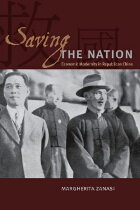 Saving the Nation: Economic Modernity in Republican China
Margherita Zanasi
University of Chicago Press, 2006 Economic modernity is so closely associated with nationhood that it is impossible to imagine a modern state without an equally modern economy. Even so, most people would have difficulty defining a modern economy and its connection to nationhood. In Saving the Nation, Margherita Zanasi explores this connection by examining the first nation-building attempt in China after the fall of the empire in 1911.
Challenging the assumption that nations are products of technological and socioeconomic forces, Zanasi argues that it was notions of what constituted a modern nation that led the Nationalist nation-builders to shape China’s institutions and economy. In their reform effort, they confronted several questions: What characterized a modern economy? What role would a modern economy play in the overall nation-building effort? And how could China pursue economic modernization while maintaining its distinctive identity? Zanasi expertly shows how these questions were negotiated and contested within the Nationalist Party. Silenced in the Mao years, these dilemmas are reemerging today as a new leadership once again redefines the economic foundation of the nation.
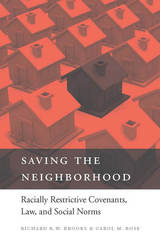 Saving the Neighborhood: Racially Restrictive Covenants, Law, and Social Norms
Richard R. W. Brooks and Carol M. Rose
Harvard University Press, 2013 Saving the Neighborhood tells the charged, still controversial story of the rise and fall of racially restrictive covenants in America, and offers rare insight into the ways legal and social norms reinforce one another, acting with pernicious efficacy to codify and perpetuate intolerance.
The early 1900s saw an unprecedented migration of African Americans leaving the rural South in search of better work and equal citizenship. In reaction, many white communities instituted property agreements—covenants—designed to limit ownership and residency according to race. Restrictive covenants quickly became a powerful legal guarantor of segregation, their authority facing serious challenge only in 1948, when the Supreme Court declared them legally unenforceable in Shelley v. Kraemer. Although the ruling was a shock to courts that had upheld covenants for decades, it failed to end their influence. In this incisive study, Richard Brooks and Carol Rose unpack why.
At root, covenants were social signals. Their greatest use lay in reassuring the white residents that they shared the same goal, while sending a warning to would-be minority entrants: keep out. The authors uncover how loosely knit urban and suburban communities, fearing ethnic mixing or even “tipping,” were fair game to a new class of entrepreneurs who catered to their fears while exacerbating the message encoded in covenants: that black residents threatened white property values. Legal racial covenants expressed and bestowed an aura of legitimacy upon the wish of many white neighborhoods to exclude minorities. Sadly for American race relations, their legacy still lingers.
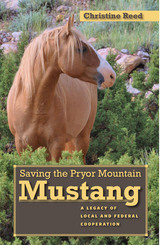 Saving the Pryor Mountain Mustang: A Legacy of Local and Federal Cooperation
Chrstine Reed
University of Nevada Press, 2015 In 1968 the residents of Lovell, Wyoming, began the work of saving the Pryor Mountain Mustang, a breed of horse with a genetic link dating back to the sixteenth-century Spanish conquistadores’ horses. In this moving case study, Christine Reed shows how, through a grassroots campaign, these residents championed the creation of the first federal public wild horse range. Crucial to this provocative analysis of local-federal cooperation is the relationship that grew between the Lovell advocates, the Bureau of Land Management, and the National Park Service. Long before there were federal laws passed to protect wild horse herds across the western states, the Pryor Mountain Mustang was preserved through the cooperative efforts of local residents and federal officials.
Saving the Pryor Mountain Mustang explores the unique and ongoing relationship between locals and the federal government, highlighting the Lovell citizens’ philosophy of cooperation instead of the typical mistrust that exists between wild horse advocates and federal agencies. The book provides a rich analysis of how a determined group of people saved an endangered wild horse herd. The book will have wide appeal to wild horse activists, scholars of local and federal governance, and western history enthusiasts.
 Saving the Security State: Exceptional Citizens in Twenty-First-Century America
Inderpal Grewal
Duke University Press, 2017 In Saving the Security State Inderpal Grewal traces the changing relations between the US state and its citizens in an era she calls advanced neoliberalism. Marked by the decline of US geopolitical power, endless war, and increasing surveillance, advanced neoliberalism militarizes everyday life while producing the “exceptional citizens”—primarily white Christian men who reinforce the security state as they claim responsibility for protecting the country from racialized others. Under advanced neoliberalism, Grewal shows, others in the United States strive to become exceptional by participating in humanitarian projects that compensate for the security state's inability to provide for the welfare of its citizens. In her analyses of microfinance programs in the global South, security moms, the murders at a Sikh temple in Wisconsin, and the post-9/11 crackdown on Muslim charities, Grewal exposes the fissures and contradictions at the heart of the US neoliberal empire and the centrality of race, gender, and religion to the securitized state.
Saving the Tropical Forests
Judith Gradwohl and Russell Greenberg
Island Press, 1988 Saving the Tropical Forests is a source book on the causes and effects of tropical deforestation.
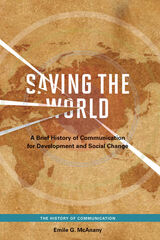 Saving the World: A Brief History of Communication for Devleopment and Social Change
Emile G. McAnany
University of Illinois Press, 2012 This far-reaching and long overdue chronicle of communication for development from a leading scholar in the field presents in-depth policy analyses to outline a vision for how communication technologies can impact social change and improve human lives. Drawing on the pioneering works of Daniel Lerner, Everett Rogers, and Wilbur Schramm as well as his own personal experiences in the field, Emile G. McAnany builds a new, historically cognizant paradigm for the future that supplements technology with social entrepreneurship. McAnany summarizes the history of the field of communication for development and social change from Truman's Marshall Plan for the Third World to the United Nations' Millennium Development Goals. Part history and part policy analysis, Saving the World argues that the communication field can renew its role in development by recognizing large aid-giving institutions have a difficult time promoting genuine transformation. McAnany suggests an agenda for improving and strengthening the work of academics, policy makers, development funders, and any others who use communication in all of its forms to foster social change.
 Saving the World in Five Hundred Words: Perspectives on Nationally Competitive Scholarships
Suzanne McCray
University of Arkansas Press, 2024 Thousands of students compete each year for a relatively small number of nationally competitive awards. Though receiving an award is not in itself an end goal, it can help launch a talented and dedicated student on a career path where they address important social or political issues, assist communities in need, or pursue research questions of global significance. The potential rewards are high for students, the institutions that support them, and the communities that will benefit from their hard work.
The ninth collection of essays produced by the National Association of Fellowships Advisors, Saving the World in Five Hundred Words offers a unique set of resources for advisors negotiating the complex world of nationally competitive awards. The essays here focus on three main aspects of fellowships advising—serving students, ensuring access, and developing the profession—and range from practical advice on how to assist students with applications, to recommendations for recruiting a broad range of students more effectively, to innovative teaching and advising practices. This volume will prove invaluable to anyone who advises students through this sometimes daunting application process.
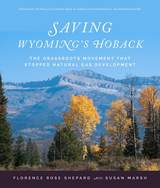 Saving Wyoming's Hoback: The Grassroots Movement that Stopped Natural Gas Development
Florence R. Shepard and Susan L. Marsh
University of Utah Press, 2016 Winner of the Wallace Stegner Prize in Environmental Humanities
In late 2012, more than one hundred people gathered to hear a long-awaited announcement: the Trust for Public Land had succeeded in preventing natural gas development in the remote Hoback Basin of Wyoming. This landmark agreement—purchasing leases from Plains Exploration Company—would not have come to pass without the extraordinary will and expertise of local citizens. Unchallenged, the proposed natural gas development in the national forest near the hamlet of Bondurant, Wyoming, would have brought roads, pipelines, water and air pollution, and a complete change in the character of the landscape and its communities.
Saving Wyoming's Hoback tells the story of the Hoback and Noble Basins in northwestern Wyoming and of the citizens who worked together to protect the land that they loved. Retired schoolteachers, mine workers, big game hunting outfitters, and other stakeholders brought together their knowledge of the area to achieve a single goal: to prevent the industrialization of the wild country that was their home. While some disagreed about specifics, their work as individuals and as coalitions is an inspiring example of how determined citizens can make a difference.
 Savings in the Modern Economy: A Symposium
Walter Heller
University of Minnesota Press, 1953
Savings in the Modern Economy was first published in 1953. Minnesota Archive Editions uses digital technology to make long-unavailable books once again accessible, and are published unaltered from the original University of Minnesota Press editions.How will savings affect the future economy of the United States and other parts of the world? Will savings continue to aid economy expansion or will they lead, sooner or later, to difficult problems? What are the motivations that cause people to save? How has the pattern of saving changed in recent times? What is the effect of retirement and pension funds? What is the role of savings in periods of inflation? In economy depression? How can savings foster economy progress in underdeveloped countries?To provide a scholarly yet thoroughly practical basis for answers to questions like these, a group of distinguished economists pool their thinking in this volume. The series of 28 papers bring to the problem varied backgrounds and different viewpoints. Professors, bankers, government officials, and industrialists, representing national and international organizations and business enterprises, contribute papers and related comments. There is not always agreement in the discussion, and no quick and easy solutions are offered, but the resulting analysis is realistic and timely, yet long-range in approach and value.The material covers four broad topics: savings and economic policy; savings concepts, data, and behavior; the savings problem in underdeveloped countries (with specific reference to the Far East and Latin America); and savings and inflation.The volume is based on papers given at a conference on Savings, Inflation, and Economy Progress held at the University of Minnesota through the cooperation of the university’s School of Business Administration and a number of sponsoring business firms.
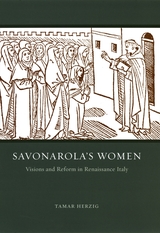 Savonarola's Women: Visions and Reform in Renaissance Italy
Tamar Herzig
University of Chicago Press, 2007 Girolamo Savonarola (1452–1498), the religious reformer, preacher, and Florentine civic leader, was burned at the stake as a false prophet by the order of Pope Alexander VI. Tamar Herzig here explores the networks of Savonarola’s female followers that proliferated in the two generations following his death. Drawing on sources from the fifteenth and sixteenth centuries, many never before studied, transcribed, or contextualized in Savonarolan scholarship and religious history, Herzig shows how powerful public figures and clerics continued to ally themselves with these holy women long after the prophet’s death.
In their quest to stay true to their leader’s teachings, Savonarola’s female followers faced hostile superiors within their orders, local political pressures, and the deep-rooted misogynistic assumptions of the Church establishment. This unprecedented volume demonstrates how reform circles throughout the Italian peninsula each tailored Savonarola’s life and works to their particular communities’ regionally specific needs. Savonarola’s Women is an important reconstruction of women’s influence on one of the most important and controversial religious movements in premodern Europe.
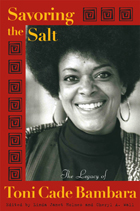 Savoring the Salt: The Legacy of Toni Cade Bambara
edited by Linda Janet Holmes and Cheryl A. Wall
Temple University Press, 2007 The extraordinary spirit of Toni Cade Bambara lives on in Savoring the Salt, a vibrant and appreciative recollection of the work and legacy of the multi-talented African American writer, teacher, filmmaker, and activist. Among the contributors who remember Bambara, reflect on her work, and examine its meaning today are Toni Morrison, Amiri Baraka, Pearl Cleage, Ruby Dee, Beverly Guy-Sheftall, Nikki Giovanni, Avery Gordon, Audre Lorde, and Sonia Sanchez.
Admiring readers have kept Bambara's fiction in print since her first collection of stories, Gorilla, My Love, was published in 1972. She continued to write -- and her audience and reputation continued to grow -- until her untimely death in 1995. Savoring the Salt includes excerpts from her published and unpublished writings, along with interviews and photos of Bambara. The mix of poets and scholars, novelists and critics, political activists and filmmakers represented here testifies to the ongoing importance and enduring appeal of her work.
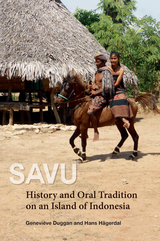 Savu: History and Oral Tradition on an Island of Indonesia
Geneviève Duggan and Hans Hägerdal
National University of Singapore Press, 2018 The book focuses on the historical trajectories of Savu, an island in the Nusa Tenggara Timur province, eastern Indonesia. While Savu is a relatively small island, aspects of its society, as well as this study’s blend of anthropology and historical method, makes this book of fundamental relevance to the ongoing comparative examination of Austronesian-speaking populations from Madagascar to Hawaii and from Taiwan to Timor. This book brings together Duggan’s detailed understanding of Savunese society and genealogies with Hägerdal’s deep knowledge of the Dutch and Portuguese archives to understand the overlap between these perspectives on Savu’s past. The text discusses the precolonial period up to the sixteenth century, and then examines how early-colonial encounters with the Portuguese and Dutch (VOC) changed the system of governance. In the nineteenth century, the Savunese embarked on minor colonial enterprises in Timor and Sumba, and were still largely autonomous vis-à-vis the colonial state. Protestant missionaries gained foothold after 1870, though Christianization was a slow process. Colonial rule via a Dutch-appointed raja was introduced in the early twentieth century. The text follows the fate of Savu during the struggle for independence and the postcolonial era, discussing the dilemmas of modernization and the resilience of the unique local culture.
Saw
Steve Katz
University of Alabama Press, 1998 The first work of fiction ever to hide a hippopotamus
Saw is a milestone novel of the seventies. For the first time what has come to be recognized as a common modern neurosis, astronaut angst, gets full play in the fictional universe. For the first time anywhere in the history of fiction, in one of the most passionate encounters ever written, Eileen mates with a Sphere. Solid geometry finally has a face. The Cylinder is a nemesis, and its terrifying accomplishments rill on like a nightmare for this astronaut. This is a work of science fiction, geometric fiction, irrefutable fact, and gourmand fantasies.
Steve Katz, whose Swanny's Way won the American Award in fiction in 1995 was acclaimed for this novel by the New York Times Book Review as a "...witty fantasist who can homogenize pop detritus, campy slang and halluncination to achieve inspired chaos."
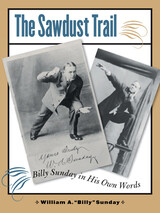 The Sawdust Trail: Billy Sunday in His Own Words
William A. Sunday
University of Iowa Press, 2005 Billy Sunday (1862-1935) was the best-known evangelist in America in the first half of the 20th century. Impoverished midwestern farm kid, professional baseball player, showman extraordinaire, unabashed patriot, and foe of the demon rum, this self-styled muscular Christian brought his brand of manly gospel to millions of Americans nationwide. Sunday connected with his fans through a combination of theatrics, conservative theology, and fervent patriotism; the circumstances of his life and work were consistent with a Horatio Alger-like myth of success that resonated with the millions of Americans of his time who had been transplanted from the farm to the city.
Published serially in the Ladies’ Home Journal in 1932 and 1933 and now in book form for the first time, The Sawdust Trail is the only autobiography that this hugely popular and hugely controversial preacher ever wrote. From his childhood days in Iowa to the early days of his conversion in Illinois, from his baseball career with the National League teams in Chicago, Pittsburgh, and Philadelphia to the challenges of preaching in New York City during his heyday, the sections of Sunday’s autobiography roll out like so many exuberant sermons, yet the sympathetic reader can hear echoes of the loneliness and misery of his early years.
In The Sawdust Trail the sometimes appalling but always appealing Billy Sunday creates a usable past for himself, notable for what he omits as well as for what he includes, which gives us insight not just into his own life and career but also into the peculiar history of evangelism in America.
 Sawdusted: Notes from a Post-Boom Mill
Raymond Goodwin
University of Wisconsin Press, 2010 When Raymond Goodwin started work at a Michigan sawmill in 1979, the glory days of lumbering were long gone. But the industry still had a faded glow that, for a while, held him there. In Sawdusted Goodwin wipes the dust off his memories of the rundown, nonunion mill where he toiled for twenty months as a two-time college dropout. Spare, evocative character sketches bring to life the personalities of his fellow millworkers—their raucous pranks, ribbing, complaints about wages and weather, macho posturing, failed romances, and fantasies of escape. The result is a mostly funny, sometimes heartbreaking portrait of life in the lumbering industry a century after its heyday. Amidst the intermittent anger and resignation of poorly paid lumbermen in the Great Lakes hinterlands, Goodwin reveals moments of vulnerability, generosity, and pride in craftsmanship. It is a world familiar, in its basic outlines, to anyone who has ever done manual labor.
At the heart of the book is a coming-of-age story about Goodwin’s relationship with his older brother Randy—a heavy drinker, chain smoker, and expert sawyer. Gruff but kind, Randy tutors Raymond in the ways of the blue-collar world even as he struggles with the demons that mask his own melancholy. A Michigan Notable Book, selected by the Library of Michigan Best Books for General Audiences, selected by the Public Library Association Outstanding Book, selected by the American Association of School Libraries
 Sawmill: The Story of Cutting the Last Great Virgin Forest East of the Rockies
Kenneth L. Smith
University of Arkansas Press, 1986 Sawmill is a history of logging in the Arkansas and Oklahoma Ouachita Mountains from 1900 to 1950, a penetrating study of the lumber industry, and a significant view of man’s interaction with a major forest resource. It is also a social history in its account of the lumbermen’s quest for the last virgin timber and the effects of its depletion. Kenneth L. Smith interviewed more than three hundred people to develop this lively history of the cutting of virgin shortleaf pine forests. The Caddo River Lumber Company and the Arkansas mill towns of Rosboro, Glenwood, and Forester provided jobs and homes for many during the brief heyday of the big sawmills. Smith takes a close look at several important timber companies, and at the personality of T. W. Rosborough, a man who bought and sold vast tracts of land and had an almost fatherly concern for both white and black sawmill workers. The recollections included here provide insight into a population that lived through the Depression years in isolated mountain communities where cats were sometimes sold as possum meat, and where men enjoyed weekend “sip and sniff” poker parties. The book is richly illustrated with photographs from the time of the mills and includes a foldout map. Sawmill was originally published in 1986 and reprinted in 2006. Winner of the Virginia C. Ledbetter Prize
Saxo Grammaticus: Hierocratical Conceptions and Danish Hegemony in the Thirteenth Century
André Szczawlinska Muceniecks
Arc Humanities Press, 2017 Denmark of the twelfth to thirteenth centuries was a place of transitions, and this volume analyzes that period through the lens of the <i>Gesta Danorum </i>of Saxo Grammaticus and other sources. The <i>Gesta</i> defends not only hierocratic conceptions but the Danish hegemonic project in the Baltic - which was grounded in the crusade movements. Such movements are presented through complex language and imagery about a glorious past brought to bear on the projects in the thirteenth century while internal tensions strengthen the monarchic and ecclesiastical institutions.
 The Saxon War
Bruno of Merseburg
Catholic University of America Press, 2022 Bruno, a cleric who served the archbishop of Magdeburg and subsequently the bishop of Merseburg during the course of the 1060s to the 1080s, composed one of the most important historical works treating the tumultuous period in the history of the German kingdom in the second half of the eleventh century. Bruno’s main focus in his Saxon War is the civil wars that engulfed the German kingdom from the mid 1060s through the end of the 1080s. However, as a historian of contemporary affairs, Bruno also offers crucial insights regarding the so-called Investiture Controversy, which Bruno treats largely as a political conflict between a tyrannical German ruler and the Saxons with some papal intervention, social conflict within the German kingdom, as well as the development of economic and military institutions.
Unlike his contemporary Lampert of Hersfeld, Bruno was closely connected to the foremost leaders of the Saxon resistance against King Henry IV, and provides unique insights regarding their plans, hopes, and fears. Bruno also provides nearly two dozen full-text copies of letters that were sent by the main participants in the intra-German conflict as well as ten letters from Pope Gregory VII, four of which do not appear in any other source including the papal register.
An additional important feature of Bruno’s history is that he treats military matters in an extraordinarily detailed manner, and is the most important narrative source for understanding the conduct of war during the second half of the eleventh century. Bruno’s detailed treatment of military matters is based upon his very extensive contacts with leading military figures, as well as his own personal observations regarding the numerous battles that punctuated the struggle between the Saxons and their erstwhile ruler.
In sum, Bruno offers both unique perspectives and unique information about a crucial period in both German and European history, which make this text valuable not only for scholars, but also for a broader audience interested in the political, religious, and particularly military history of the eleventh century. This will be the first English translation of this work.
 Saxony in German History: Culture, Society, and Politics, 1830-1933
James Retallack, Editor
University of Michigan Press, 2000 During the hundred years examined in this volume, ordinary Germans discovered a new and powerful attachment to the nation. But throughout this period, national loyalties competed with preexisting loyalties to the locality and the region. The resulting tension made it difficult for Germans to assign clear priorities to one kind of symbolic attachment over another.
Focusing on the east German state of Saxony, the contributors to this volume refuse easy resolution of that tension, seeking instead to illustrate how local, regional, and national cultures commingled, diverged, and influenced each other over time. By considering both the erosion and the persistence of traditional identities and regional boundaries, these essays help to restore an appreciation of regional "ways of seeing," suggesting they really did matter--in their own right, and for the nation as a whole.
Topics considered include the expansion of a German reading public, Jewish emancipation, the formation of socio-moral milieus, working-class leisure, the expansion of the public sphere, the rise of consumer co-operatives, gendered attempts to fashion the "new" liberal man, and degradation rituals in the 1920s. Presenting to English-reading audiences the fruits of cutting-edge research conducted in Saxon archives since 1989, the contributors offer innovative ways to reassess the larger sweep of German history.
This book serves as a how-to guide for the study of any region in history. Beyond its primary appeal to European historians, it will also speak to students and scholars in comparative politics and sociology.
James Retallack is Professor of History, University of Toronto.
Say Can You Deny Me: A Guide to Surviving Music by Women from the 16th through the 18th Centuries
Barbara Garvey Jackson
University of Arkansas Press, 1994 Jackson has culminated her lifelong research in producing this bibliographically arranged guide. "Say Can You Deny Me" lists the locations of the printed and manuscript sources of Renaissance, baroque, classic, and some early romantic women composers. With listings from over 400 libraries worldwide, the guide is the definitive work documenting a substantial contribution to the world of music by women.
 Say Her Name: Centering Black Feminism and Black Women in Sport
Letisha Engracia Cardoso Brown
Rutgers University Press, 2025 Say Her Name: Centering Black Feminism and Black Women in Sports offers an in-depth look into the lived experiences of Blackgirlwomen as athletes, activists, and everyday people through a Black feminist lens. With so much research on race centered on Black men and gender research focusing on white women, Say Her Name offers a necessary conversation that places Blackgirlwomen at the center of discussion.
Say Her Name delves deeply into issues of gender, the politics of punishment, athlete activism, the politics of Black hair, fingernails and fashion, and the representation and commodification of Blackgirlwomen in sport and society. An entry point into the growing research in sport studies and beyond from a Black feminist lens, Say Her Name offers a clear window into the power and potential of nuanced examinations of sport. As a reflection of the larger social world, sport provides a framework for understanding larger social issues, including racism, sexism, and misogynoir. Blackgirlwomen have varied experiences in sport, and Say Her Name provides a window into those experiences. The book discusses Black women in sports including the South African runner Caster Semenya and the American runners Florence Griffith Joyner and Sha’Carri Richardson, as well as Venus and Serena Williams, Gabby Douglas, and Simone Biles. The women in this book have lived experiences that speak to the larger experiences of Black women and girls in sport and society, while also leaning into a larger discussion of the importance of the social movement #SayHerName.
 Say No to the Devil: The Life and Musical Genius of Rev. Gary Davis
Ian Zack
University of Chicago Press, 2015 Who was the greatest of all American guitarists? You probably didn’t name Gary Davis, but many of his musical contemporaries considered him without peer. Bob Dylan called Davis “one of the wizards of modern music.” Bob Weir of the Grateful Dead—who took lessons with Davis—claimed his musical ability “transcended any common notion of a bluesman.” And the folklorist Alan Lomax called him “one of the really great geniuses of American instrumental music.” But you won’t find Davis alongside blues legends Robert Johnson and Muddy Waters in the Rock and Roll Hall of Fame. Despite almost universal renown among his contemporaries, Davis lives today not so much in his own work but through covers of his songs by Dylan, Jackson Browne, and many others, as well as in the untold number of students whose lives he influenced.
The first biography of Davis, Say No to the Devil restores “the Rev’s” remarkable story. Drawing on extensive research and interviews with many of Davis’s former students, Ian Zack takes readers through Davis’s difficult beginning as the blind son of sharecroppers in the Jim Crow South to his decision to become an ordained Baptist minister and his move to New York in the early 1940s, where he scraped out a living singing and preaching on street corners and in storefront churches in Harlem. There, he gained entry into a circle of musicians that included, among many others, Lead Belly, Woody Guthrie, and Dave Van Ronk. But in spite of his tremendous musical achievements, Davis never gained broad recognition from an American public that wasn’t sure what to make of his trademark blend of gospel, ragtime, street preaching, and the blues. His personal life was also fraught, troubled by struggles with alcohol, women, and deteriorating health.
Zack chronicles this remarkable figure in American music, helping us to understand how he taught and influenced a generation of musicians.
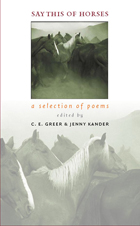 Say This of Horses: A Selection of Poems
C.E. Greer
University of Iowa Press, 2007 Containing more than a hundred poems by seventy-four poets of twenty-two nationalities, Say This of Horses represents the abundance of poems about horses that have been written throughout the ages and around the world. Whether probing the ages-old connection between horses and humans, the immediate physical presence of horses, or the metaphysical elements of these magnificent animals, this collection celebrates the horse as what Maxine Kumin calls “our enduring myth, the repository for our love and terror.”
Divided into six sections, Say This of Horses considers horses in a multitude of times and places. “Antiquity” explores the forging of the earliest mythical ties between horses and humans. “Here, Now” places horses in the present, where their physical presence is most acutely felt. “Esssence” explores the metaphysical qualities of horses. “Harnessed” contains a selection of poems about horses in war, at work, and in sport and recreation. “Mirrors” shows them as imaginative symbols. Finally, “Lenses” moves into the realm of abstraction and fantasy.
The selections within this far-reaching collection are joyous, moving, erudite, and at times profoundly sad. Poems by Henry Wadsworth Longfellow, W. S. Merwin, Tess Gallagher, Yusef Komunyakaa, Pablo Neruda, Anne Sexton, Wallace Stevens, May Sarton, Jane Kenyon, and James Dickey, among many others, are sure to delight and surprise readers familiar with or just exploring the rich literature on horses.
Contributors include:
Guillaume Apollinaire, Gwendolyn Brooks, Lawrence Ferlinghetti, C.E. Greer, Donald Hall, Joy Harjo, Imru’ al-Qays, Ted Kooser, Philip Larkin, Ann McCarthy de Zavala, Rainer Maria Rilke, Patiann Rogers, William Carlos Williams
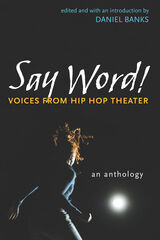 Say Word!: Voices from Hip Hop Theater
An Anthology Edited and with an Introduction by Daniel Banks
University of Michigan Press, 2011 The phenomenon known as Hip Hop encompasses a global, multiethnic, grassroots culture committed to social justice and self-expression through performance. Hip Hop Theater emerged from that culture, mixing spoken-word performance with music and dance and marked by Hip Hop's strong sense of activism and resistance. Hip Hop Theater is engaged with questions of identity – culture, heritage, ethnicity, class, gender, sexuality, and difference—narrating the experiences of historically marginalized peoples and putting them in dialogue with other oppressed communities. Say Word! Voices from Hip Hop Theater collects eight works by contemporary artists who confront today's compelling issues, ranging from racial profiling and police brutality to women's empowerment and from the commercial exploitation of Hip Hop to identity politics. Editor Daniel Banks has assembled work by Abiola Abrams, Zakiyyah Alexander, Chadwick Boseman, Kristoffer Diaz, Rha Goddess, Antoy Grant, Joe Hernandez-Kolski, Rickerby Hinds, and Ben Snyder, augmented with an extensive introduction and other informative commentary. The book also includes a roundtable moderated by Holly Bass and featuring Hip Hop pioneers Eisa Davis, Danny Hoch, Sarah Jones, and Will Power, a conversation that traces the roots of Hip Hop Theater and imagines its future directions.
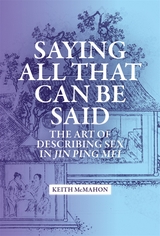 Saying All That Can Be Said: The Art of Describing Sex in Jin Ping Mei
Keith McMahon
Harvard University Press, 2023 In Saying All That Can Be Said, Keith McMahon presents the first full analysis of the sexually explicit portrayals in the Ming novel Jin Ping Mei 金瓶梅 (The Plum in the Golden Vase). Countering common views of those portrayals as “just sex” or as “bad sex,” he shows that they are rich in thematic meaning and loaded with social and aesthetic purpose. McMahon places the novel in the historical context of Chinese sexual culture, from which Jin Ping Mei inherits the style of the elegant, metaphorical description of erotic pleasure, but which the anonymous author extends in an exploration of the explicit, the obscene, and the graphic. The novel uses explicit description to evaluate and comment on characters, situations, and sexual and psychic states of being. Echoing the novel’s way of taking sex as a vehicle for reading the world, McMahon celebrates the richness and exuberance of Jin Ping Mei’s language of sex, which refuses imprisonment within the boundaries of orthodox culture’s cleanly authoritative style, and which continues to inspire admiration from readers around the world. Saying All That Can Be Said will change the way we think about sexual culture in premodern China.
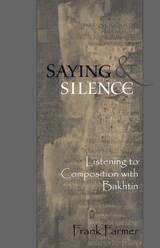 Saying And Silence
Frank Farmer
Utah State University Press, 2001 Frank Farmer has contributed important essays to the study of Bakhtin in composition, and in Saying and Silence he gathers some of those, along with several new essays, into a single volume. Scholars who specialize in Bakhtin will find this work engaging, but equally Farmer wants to explicate and apply Bakhtin for readers whose focus is teaching or some other nonspecialist dimension of writing scholarship. Farmer explores the relationship between the meaningful word and the meaningful pause, between saying and silence, especially as the relationship emerges in our classrooms, our disciplinary conversations, and encounters with publics beyond the academy. Each of his chapters here addresses some aspect of how we and our students, colleagues, and critics have our say and speak our piece, often under conditions where silence is the institutionally sanctioned and preferred alternative. He has enlisted a number of Bakhtinian ideas (the superaddressee, outsideness, voice in dialogue) to help in the project of interpreting the silences we hear, naming the silences we do not hear, and of encouraging all silences to speak in ways that are freely chosen, not enforced.
Saying I No More: Subjectivity and Consciousness in the Prose of Samuel Beckett
Daniel Katz
Northwestern University Press, 1999 In recent criticism, Samuel Beckett's prose has been increasingly described as a labor of refusal: not only of what traditionally has made possible narrative and the novel but also of the major conventional suppositions concerning the primacy of consciousness, subjectivity, and expression for the artistic act. Beginning from the premise that Beckett never betrays his belief in "the impossibility to express," Saying I No More explores the Beckettian refusal. Katz posits that the expression of voicelessness in Beckett is not silence, that the negativity and negation so evident in the great writer's work are not simply affirmed, but that the valorization of abnegation, emptiness, impotence, or the "no" can all too easily become itself an affirmation of power or an inverted imposition of force.
Saying It's So: A Cultural History of the Black Sox Scandal
Daniel A. Nathan
University of Illinois Press, 2002 The story of "Shoeless" Joe Jackson and his White Sox teammates purportedly conspiring with gamblers to throw the 1919 World Series to the Cincinnati Reds has lingered in our collective consciousness for a century. Daniel A. Nathan's wide-ranging history looks at how journalists, historians, novelists, filmmakers, and baseball fans have represented and remembered the scandal. Nathan's reflections on what these different cultural narratives reveal about their creators and eras shape a fascinating study of cultural values, memory, and the ways people make meaning.
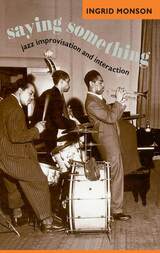 Saying Something: Jazz Improvisation and Interaction
Ingrid Monson
University of Chicago Press, 1997 A close-up exploration of the role of the rhythm section in jazz ensemblers
This fresh look at the neglected rhythm section in jazz ensembles shows that the improvisational interplay among drums, bass, and piano is just as innovative, complex, and spontaneous as the solo. Ingrid Monson juxtaposes musicians' talk and musical examples to ask how musicians go about "saying something" through music in a way that articulates identity, politics, and race. Through interviews with Jaki Byard, Richard Davis, Sir Roland Hanna, Billy Higgins, Cecil McBee, and others, she develops a perspective on jazz improvisation that has "interactiveness" at its core, in the creation of music through improvisational interaction, in the shaping of social communities and networks through music, and in the development of cultural meanings and ideologies that inform the interpretation of jazz in twentieth-century American cultural life.
Replete with original musical transcriptions, this broad view of jazz improvisation and its emotional and cultural power will have a wide audience among jazz fans, ethnomusicologists, and anthropologists.
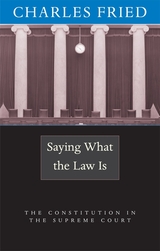 Saying What the Law Is: The Constitution in the Supreme Court
Charles Fried
Harvard University Press, 2004 In a few thousand words the Constitution sets up the government of the United States and proclaims the basic human and political rights of its people. From the interpretation and elaboration of those words in over 500 volumes of Supreme Court cases comes the constitutional law that structures our government and defines our individual relationship to that government. This book fills the need for an account of that law free from legal jargon and clear enough to inform the educated layperson, yet which does not condescend or slight critical nuance, so that its judgments and analyses will engage students, practitioners, judges, and scholars.
Taking the reader up to and through such controversial recent Supreme Court decisions as the Texas sodomy case and the University of Michigan affirmative action case, Charles Fried sets out to make sense of the main topics of constitutional law: the nature of doctrine, federalism, separation of powers, freedom of expression, religion, liberty, and equality.
Fried draws on his knowledge as a teacher and scholar, and on his unique experience as a practitioner before the Supreme Court, a former Associate Justice of the Supreme Judicial Court of Massachusetts, and Solicitor General of the United States to offer an evenhanded account not only of the substance of constitutional law, but of its texture and underlying themes. His book firmly draws the reader into the heart of today's constitutional battles. He understands what moves today's Court and that understanding illuminates his analyses.
Saying What We Mean: Implicit Precision and the Responsive Order
Selected Works by Eugene T. Gendlin, Edited by Edward S. Casey and Donata M. Schoeller; Foreword by Edward S. Casey
Northwestern University Press, 2018 The first collection of Eugene T. Gendlin’s groundbreaking essays in philosophical psychology, Saying What We Mean casts familiar areas of human experience, such as language and feeling, in a radically different light. Instead of the familiar scientific emphasis on what is conceptually explicit, Gendlin shows that the implicit also comprises a structure that can be made available for recognition and analysis. Developing the traditions of phenomenology, existentialism, and pragmatism, Gendlin forges a new path that synthesizes contemporary evolutionary theory, cognitive psychology, and philosophical linguistics.
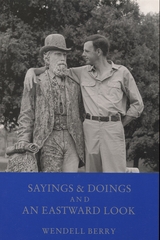 Sayings and Doings and An Eastward Look
Wendell Berry
Ohio University Press, 1990 Published in 1990 by Gnomon Press This volume combines two small books of poetry by Wendell Berry, both with expanded texts. In Sayings and Doings the inner lives of the country people Berry knows so well surface in sayings, stories, reminiscences, and a number of jocular dialogues. Many are expressions we hear and often mean to remember but, when we start to retell them, find that we have forgotten the exact wording, without which they lose their effectiveness. Here the poet remembers well. One can hear as one reads, and the rural speech has been whittled so that not a syllable is wasted. The condensed nature of Sayings and Doings is mirrored in the Asian influence of An Eastward Look, which includes haiku, the journal-like sequence "A Long Journey and a Small Notebook," and the masterful "Chinese Painting Poems." For those familiar with many other collections of Berry's poems, this volume will acquaint them with other facets of his work, until now too little known.
Sayings Traditions in the Apocryphon of James
Ron Cameron
Harvard University Press, 2004 The discovery and publication of the Apocryphon of James from Nag Hammadi has significantly expanded the spectrum of early Christian literature about Jesus. In this informative monograph, which has been out of print until now, Ron Cameron provides a form-critical analysis which aims to clarify the ways in which the sayings of Jesus were used and transformed in early Christian communities. By recognizing the importance of this particular document, scholars will no longer be able to regard the synoptic gospels of the New Testament as unique or sufficient for understanding the trajectory of the Jesus tradition. The "synoptic problem" must now be seen as a gospels problem.
The SBL Commentary on the Septuagint: An Introduction
Dirk Büchner
SBL Press, 2017 Explore the groundwork for a new commentary series from SBL
Press
This book contains verse by verse commentary on selections from the Greek text of the Hebrew Bible known as the Septuagint. Each chapter is from a different bible book, for which there will eventually be a full commentary published in the Society of Biblical Literature Commentary on the Septuagint. The commentary series focuses on the actual process of translation, so its authors try to describe and explain the kinds of decisions the ancient Alexandrian translators made about how to render Hebrew into Greek.
Features
- Translations from and commentary on Genesis, Exodus, Leviticus, Numbers, Esther, Job, and Psalms
Contributions from eight experts on the Septuagint
- Guidelines and procedures used in the production of the translations in the series
The SBL Handbook of Style
Society of Biblical Literature
SBL Press, 2014 The definitive source for how to write and publish in the field of biblical studies
The long-awaited second edition of the essential style manual for writing and publishing in biblical studies and related fields includes key style changes, updated and expanded abbreviation and spelling-sample lists, a list of archaeological site names, material on qur’anic sources, detailed information on citing electronic sources, and expanded guidelines for the transliteration and transcription of seventeen ancient languages.
Features:
- Expanded lists of abbreviations for use in ancient Near Eastern, biblical, and early Christian studies
- Information for transliterating seventeen ancient languages
- Exhaustive examples for citing print and electronic sources
The Scalawag In Alabama Politics, 1865–1881
Sarah Woolfolk Wiggins
University of Alabama Press, 1977 Who was this scalawag? Simply a native, white, Alabama Republican! Scorned by his fellow white Southerners, he suffered, in his desire for socioeconomic reform and political power, more than mere verbal abuse and social ostracism; he lived constantly under the threat of physical violence. When first published in 1977, Wiggin’s treatment of the scalawag was the first book-length study of scalawags in any state, and it remains the most thorough treatment. According to The Journal of American History, this is the “most effective challenge to the scalawag stereotype yet to appear.”
Scald
Denise Duhamel
University of Pittsburgh Press, 2017 When her “smart” phone keeps asking her to autocorrect her name to Denise Richards, Denise Duhamel begins a journey that takes on celebrity, sex, reproduction, and religion with her characteristic wit and insight. The poems in Scald engage feminism in two ways—committing to and battling with—various principles and beliefs. Duhamel wrestles with foremothers and visionaries Shulamith Firestone, Andrea Dworkin, and Mary Daly as well as with pop culture figures such as Helen Reddy, Cyndi Lauper, and Bikini Kill. In dialogue with artists and writers such as Catherine Opie, Susan Faludi, and Eve Ensler, Duhamel tries to understand our cultural moment. While Duhamel’s Scald can burn, she has more importantly taken on the role of the ancient Scandinavian “Skald,” one who pays tribute to heroic deeds. In Duhamel’s case, her heroes are also heroines.
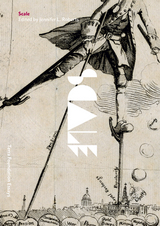 Scale
Edited by Jennifer L. Roberts
Terra Foundation for American Art, 2016 Scale is perhaps the most spectacularly overlooked aspect of artistic production. As photographic and digital reproductions have essentially dematerialized art, critical and historical research dealing with scale—both within the American critical tradition and abroad—has become scattered and insufficiently theorized. However, by posing a specific challenge, such research forces a heightened recognition of both the properties of materials and the deep technical knowledge of makers. A reconsideration of scalar relationships in American art and visual culture therefore reveals original insights.
Scale is the second volume in the Terra Foundation Essays series. With eighty color illustrations and a wealth of new research from Glenn Adamson, Wendy Bellion, Wouter Davidts, Darcy Grimaldo Grigsby, Christopher P. Heuer, Joshua G. Stein, and Jason Weems, it explores viewers’ physical relationship to Barnett Newman’s abstract canvases, the arduous engineering behind the creation of Mount Rushmore, and the charged significance of liberty poles in the landscape of eighteenth-century New York, among other topics that range from studies of specific works of art to significant conceptual and theoretical concerns.
Scale
Nathan McClain
Four Way Books, 2017 Scale is about a relationship between a father and a son. These poems consider the importance of acknowledging the past as well as the dangers in doing so.
Scale and Scope: The Dynamics of Industrial Capitalism
Alfred D. Chandler Jr.
Harvard University Press, 1990 Scale and Scope is Alfred Chandler’s first major work since his Pulitzer Prize–winning The Visible Hand. Representing ten years of research into the history of the managerial business system, this book concentrates on patterns of growth and competitiveness in the United States, Germany, and Great Britain, tracing the evolution of large firms into multinational giants and orienting the late twentieth century’s most important developments.
This edition includes the entire hardcover edition with the exception of the Appendix Tables.
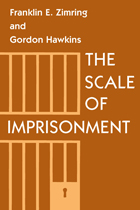 The Scale of Imprisonment
Franklin E. Zimring and Gordon J. Hawkins
University of Chicago Press, 1991 Two of the nation's foremost criminal justice scholars present a comprehensive assessment of the factors behind the growth and subsequent overcrowding of American prisons. By critiquing the existing scholarship on prison scale from sociology and history to correctional forecasting and economics, they both reveal that explicit policy changes have had little influence on the increases in imprisonment in recent years and analyze whether it is possible to place limits effectively on prison population.
"The Scale of Imprisonment has an exceptionally well designed literature review of interest to public policy, criminal justice, and public law scholars. Its careful review, analysis, and critique of research is stimulating and inventive."—American Political Science Review
"The authors fram our thoughts about the soaring use of imprisonment and stimulate our thinking about the best way we as criminologists can conduct rational analysis and provide meaningful advice."—Susan Guarino-Ghezzi, Journal of Quantitative Criminology
"Zimring and Hawkins bring a long tradition of excellent criminological scholarship to the seemingly intractable problems of prisons, prison overcrowding, and the need for alternative forms of punishment."—J. C. Watkins, Jr., Choice
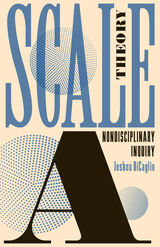 Scale Theory: A Nondisciplinary Inquiry
Joshua DiCaglio
University of Minnesota Press, 2021 A pioneering call for a new understanding of scale across the humanities
How is it possible that you are—simultaneously—cells, atoms, a body, quarks, a component in an ecological network, a moment in the thermodynamic dispersal of the sun, and an element in the gravitational whirl of galaxies? In this way, we routinely transform reality into things already outside of direct human experience, things we hardly comprehend even as we speak of DNA, climate effects, toxic molecules, and viruses. How do we find ourselves with these disorienting layers of scale? Enter Scale Theory, which provides a foundational theory of scale that explains how scale works, the parameters of scalar thinking, and how scale refigures reality—that teaches us how to think in terms of scale, no matter where our interests may lie. Joshua DiCaglio takes us on a fascinating journey through six thought experiments that provide clarifying yet provocative definitions for scale and new ways of thinking about classic concepts ranging from unity to identity. Because our worldviews and philosophies are largely built on nonscalar experience, he then takes us slowly through the ways scale challenges and reconfigures objects, subjects, and relations. Scale Theory is, in a sense, nondisciplinary—weaving together a dizzying array of sciences (from nanoscience to ecology) with discussions from the humanities (from philosophy to rhetoric). In the process, a curious pattern emerges: attempts to face the significance of scale inevitably enter terrain closer to mysticism than science. Rather than dismiss this connection, DiCaglio examines the reasons for it, redefining mysticism in terms of scale and integrating contemplative philosophies into the discussion. The result is a powerful account of the implications and challenges of scale, attuned to the way scale transforms both reality and ourselves.
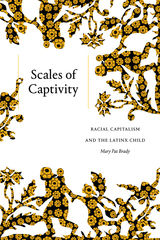 Scales of Captivity: Racial Capitalism and the Latinx Child
Mary Pat Brady
Duke University Press, 2022 In Scales of Captivity, Mary Pat Brady traces the figure of the captive or cast-off child in Latinx and Chicanx literature and art between chattel slavery’s final years and the mass deportations of the twenty-first century. She shows how Latinx expressive practices expose how every rescaling of economic and military power requires new modalities of capture, new ways to bracket and hedge life. Through readings of novels by Helena María Viramontes, Oscar Casares, Lorraine López, Maceo Montoya, Reyna Grande, Daniel Peña, and others, Brady illustrates how submerged captivities reveal the way mechanisms of constraint such as deportability ground institutional forms of carceral modernity and how such practices scale relations by naturalizing the logic of scalar hierarchies underpinning racial capitalism. By showing how representations of the captive child critique the entrenched logic undergirding colonial power, Brady challenges racialized modes of citizenship while offering visions for living beyond borders.
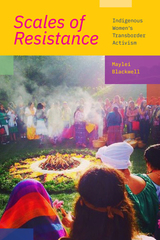 Scales of Resistance: Indigenous Women’s Transborder Activism
Maylei Blackwell
Duke University Press, 2022 In Scales of Resistance Maylei Blackwell narrates how Indigenous women’s activism in Mexico and its diaspora weaves in and between local, national, continental, and transborder scales. Drawing on more than seventy testimonials and twenty years of fieldwork spent accompanying Indigenous women activists, Blackwell focuses on how these activists navigate the blockages to their participation and transform exclusionary spaces into scales of resistance. Blackwell shows how activists in Mexico and those in the migrant stream that runs from Oaxaca into California redefined women’s roles in community decision-making. They did so by scaling down Indigenous autonomy to their own bodies, homes, and communities; grounding their political claims within Indigenous epistemologies and the gendered nature of social organization; and scaling up to regional, national, and continental contexts. This allowed them to place themselves at the heart of Indigenous resistance and autonomy, decolonizing gender hierarchies and creating new scales of participation. Blackwell reveals the importance of moving across different types of scale and contrasting colonial divisions of scale itself with Indigenous conceptions of scale, space, solidarity, and connection.
|
|

